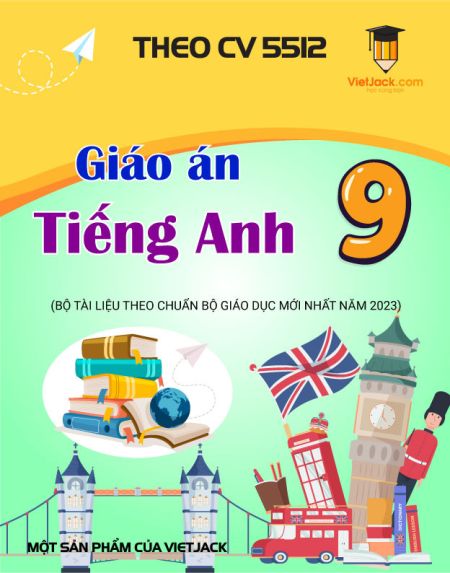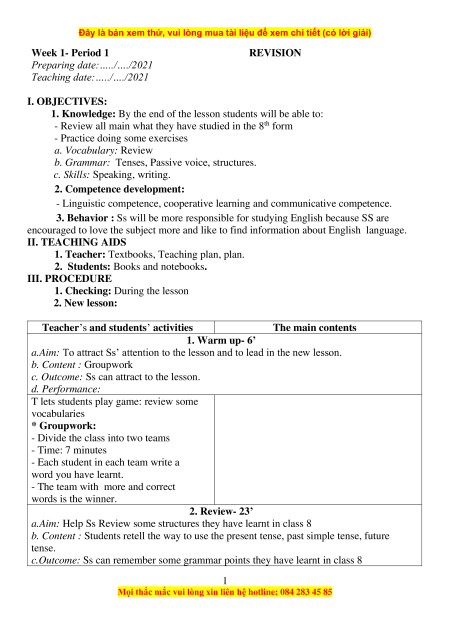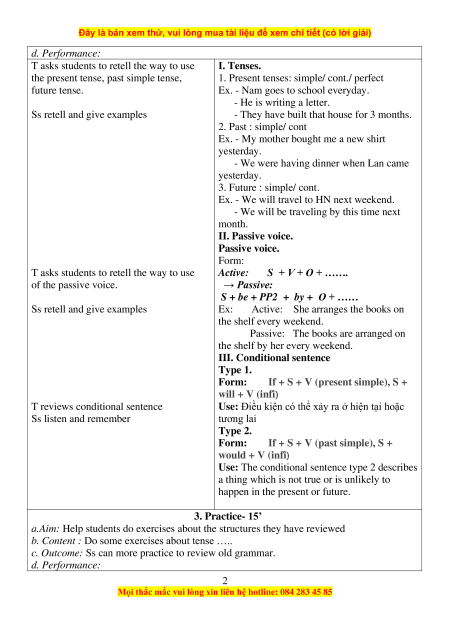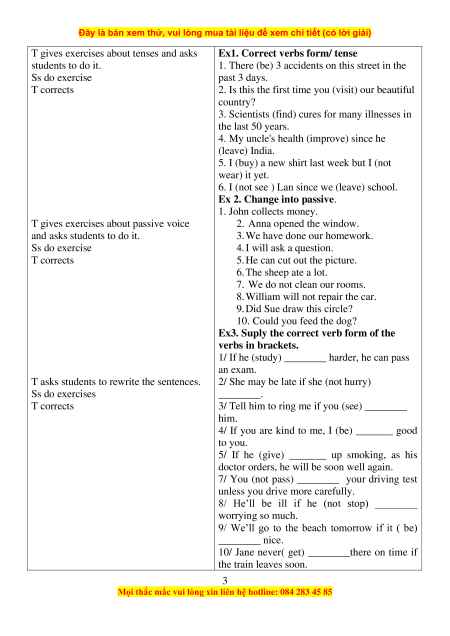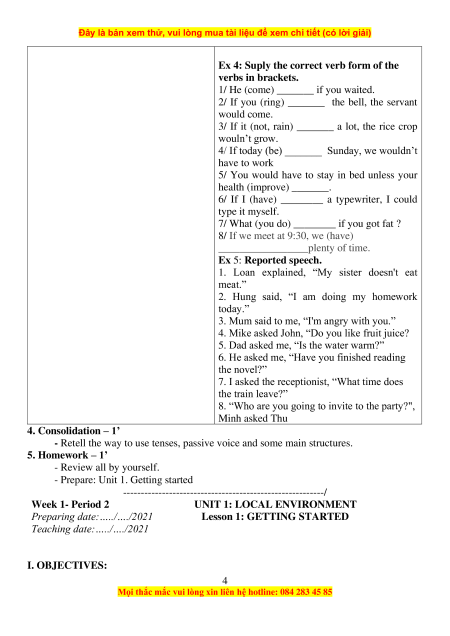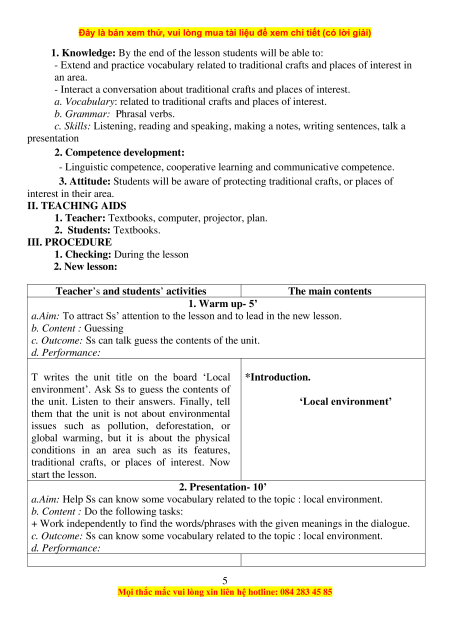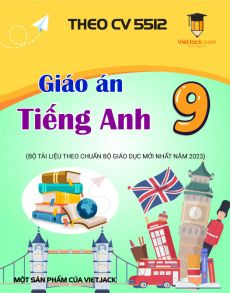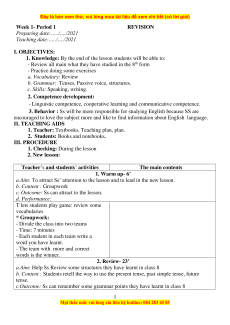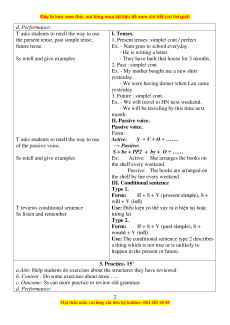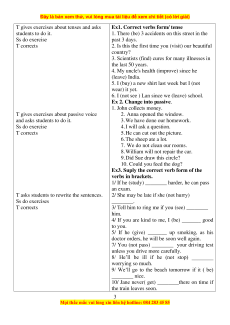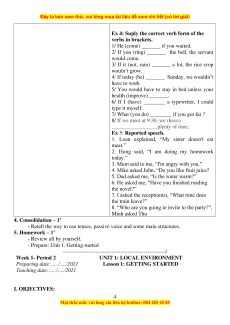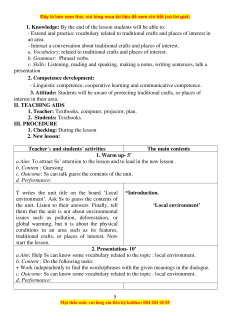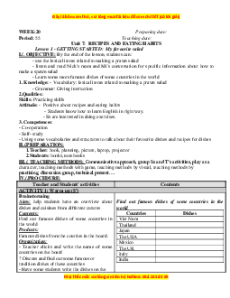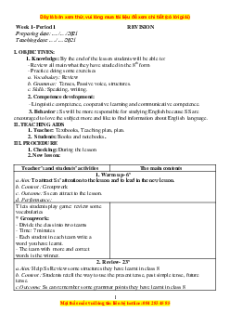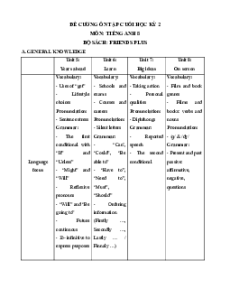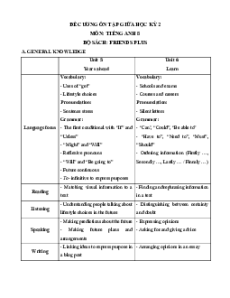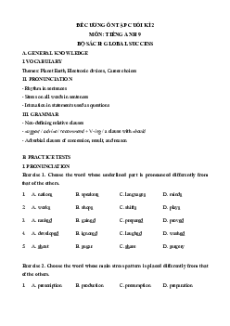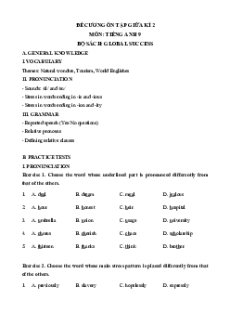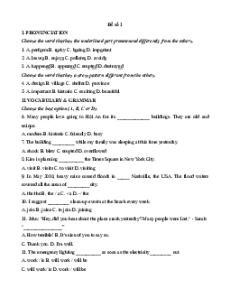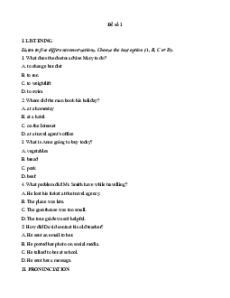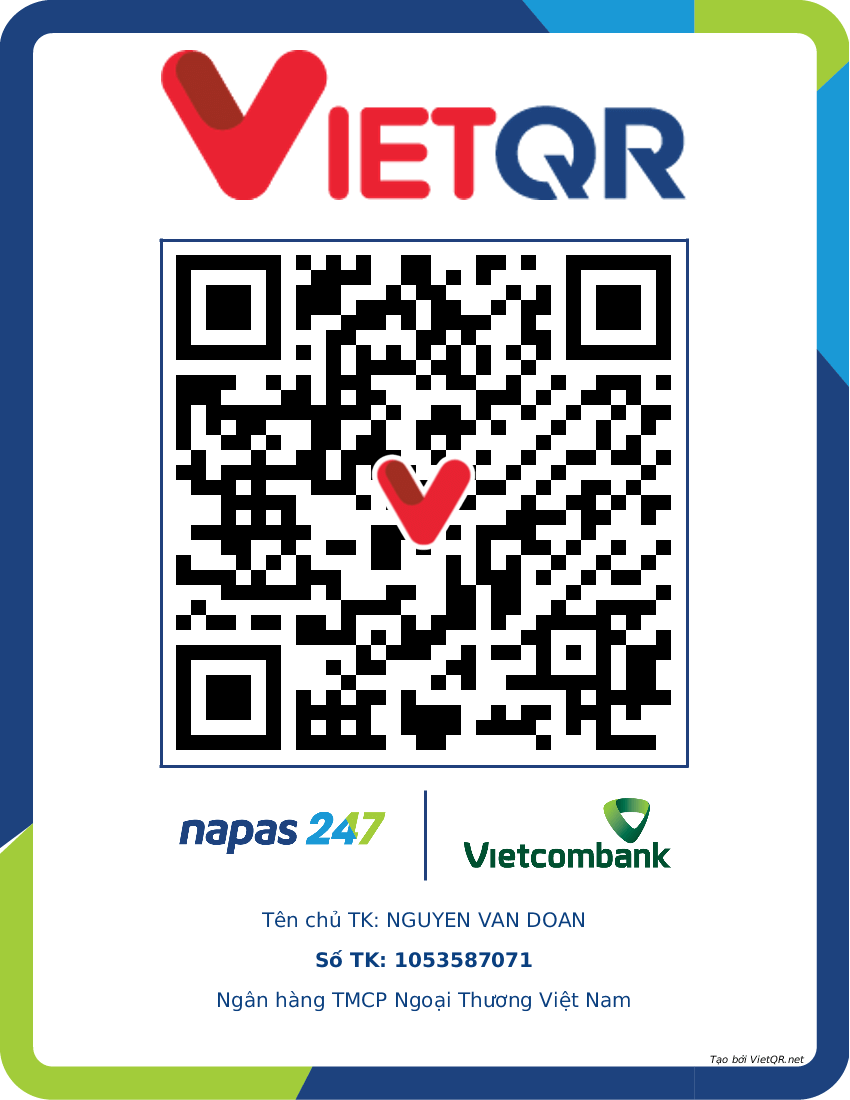Week 1- Period 1 REVISION
Preparing date:…../…./2021
Teaching date:…../…./2021 I. OBJECTIVES:
1. Knowledge: By the end of the lesson students will be able to:
- Review all main what they have studied in the 8th form
- Practice doing some exercises a. Vocabulary: Review
b. Grammar: Tenses, Passive voice, structures.
c. Skills: Speaking, writing.
2. Competence development:
- Linguistic competence, cooperative learning and communicative competence.
3. Behavior : Ss will be more responsible for studying English because SS are
encouraged to love the subject more and like to find information about English language. II. TEACHING AIDS
1. Teacher: Textbooks, Teaching plan, plan.
2. Students: Books and notebooks. III. PROCEDURE
1. Checking: During the lesson 2. New lesson:
Teacher’s and students’ activities The main contents 1. Warm up- 6’
a.Aim: To attract Ss’ attention to the lesson and to lead in the new lesson. b. Content : Groupwork
c. Outcome: Ss can attract to the lesson. d. Performance:
T lets students play game: review some vocabularies * Groupwork:
- Divide the class into two teams - Time: 7 minutes
- Each student in each team write a word you have learnt.
- The team with more and correct words is the winner. 2. Review- 23’
a.Aim: Help Ss Review some structures they have learnt in class 8
b. Content : Students retell the way to use the present tense, past simple tense, future tense.
c.Outcome: Ss can remember some grammar points they have learnt in class 8 1
d. Performance:
T asks students to retell the way to use I. Tenses.
the present tense, past simple tense,
1. Present tenses: simple/ cont./ perfect future tense.
Ex. - Nam goes to school everyday. - He is writing a letter. Ss retell and give examples
- They have built that house for 3 months. 2. Past : simple/ cont
Ex. - My mother bought me a new shirt yesterday.
- We were having dinner when Lan came yesterday. 3. Future : simple/ cont.
Ex. - We will travel to HN next weekend.
- We will be traveling by this time next month. II. Passive voice. Passive voice. Form:
T asks students to retell the way to use
Active: S + V + O + ……. of the passive voice. → Passive:
S + be + PP2 + by + O + …… Ss retell and give examples
Ex: Active: She arranges the books on the shelf every weekend.
Passive: The books are arranged on
the shelf by her every weekend.
III. Conditional sentence Type 1.
Form: If + S + V (present simple), S + will + V (infi)
T reviews conditional sentence
Use: Điều kiện có thể xảy ra ở hiện tại hoặc Ss listen and remember tương lai Type 2.
Form: If + S + V (past simple), S + would + V (infi)
Use: The conditional sentence type 2 describes
a thing which is not true or is unlikely to
happen in the present or future. 3. Practice- 15’
a.Aim: Help students do exercises about the structures they have reviewed
b. Content : Do some exercises about tense …..
c. Outcome: Ss can more practice to review old grammar. d. Performance: 2
T gives exercises about tenses and asks
Ex1. Correct verbs form/ tense students to do it.
1. There (be) 3 accidents on this street in the Ss do exercise past 3 days. T corrects
2. Is this the first time you (visit) our beautiful country?
3. Scientists (find) cures for many illnesses in the last 50 years.
4. My uncle's health (improve) since he (leave) India.
5. I (buy) a new shirt last week but I (not wear) it yet.
6. I (not see ) Lan since we (leave) school.
Ex 2. Change into passive. 1. John collects money.
T gives exercises about passive voice 2. Anna opened the window. and asks students to do it. 3. We have done our homework. Ss do exercise 4. I will ask a question. T corrects
5. He can cut out the picture. 6. The sheep ate a lot. 7. We do not clean our rooms.
8. William will not repair the car. 9. Did Sue draw this circle? 10. Could you feed the dog?
Ex3. Suply the correct verb form of the verbs in brackets.
1/ If he (study) ________ harder, he can pass an exam.
T asks students to rewrite the sentences.
2/ She may be late if she (not hurry) Ss do exercises ________. T corrects
3/ Tell him to ring me if you (see) ________ him.
4/ If you are kind to me, I (be) _______ good to you.
5/ If he (give) _______ up smoking, as his
doctor orders, he will be soon well again.
7/ You (not pass) ________ your driving test
unless you drive more carefully.
8/ He’ll be ill if he (not stop) ________ worrying so much.
9/ We’ll go to the beach tomorrow if it ( be) ________ nice.
10/ Jane never( get) ________there on time if the train leaves soon. 3
Ex 4: Suply the correct verb form of the verbs in brackets.
1/ He (come) _______ if you waited.
2/ If you (ring) _______ the bell, the servant would come.
3/ If it (not, rain) _______ a lot, the rice crop wouln’t grow.
4/ If today (be) _______ Sunday, we wouldn’t have to work
5/ You would have to stay in bed unless your health (improve) _______.
6/ If I (have) ________ a typewriter, I could type it myself.
7/ What (you do) ________ if you got fat ?
8/ If we meet at 9:30, we (have)
_________________plenty of time.
Ex 5: Reported speech.
1. Loan explained, “My sister doesn't eat meat.”
2. Hung said, “I am doing my homework today.”
3. Mum said to me, “I'm angry with you.”
4. Mike asked John, “Do you like fruit juice?
5. Dad asked me, “Is the water warm?”
6. He asked me, “Have you finished reading the novel?”
7. I asked the receptionist, “What time does the train leave?”
8. “Who are you going to invite to the party?", Minh asked Thu 4. Consolidation – 1’
- Retell the way to use tenses, passive voice and some main structures. 5. Homework – 1’ - Review all by yourself.
- Prepare: Unit 1. Getting started
---------------------------------------------------------/ Week 1- Period 2
UNIT 1: LOCAL ENVIRONMENT
Preparing date:…../…./2021
Lesson 1: GETTING STARTED
Teaching date:…../…./2021 I. OBJECTIVES: 4
Giáo án Tiếng Anh 9 (mới CV 5512) | Giáo án Tiếng Anh 9 mới, chuẩn nhất
584
292 lượt tải
300.000 ₫
MUA NGAY ĐỂ XEM TOÀN BỘ TÀI LIỆU
CÁCH MUA:
- B1: Gửi phí vào TK:
1133836868- CT TNHH DAU TU VA DV GD VIETJACK - Ngân hàng MB (QR) - B2: Nhắn tin tới Zalo VietJack Official ( nhấn vào đây ) để xác nhận thanh toán và tải tài liệu - giáo án
Liên hệ ngay Hotline hỗ trợ: 084 283 45 85
Bộ giáo án Tiếng Anh 9 (mới CV5512) được cập nhật liên tục trong gói này từ nay đến hết tháng 3/2024.
Để tải tài liệu gốc về máy bạn click vào nút Tải Xuống ở trên!
Bộ tài liệu bao gồm: 2 tài liệu lẻ (mua theo bộ tiết kiệm đến 50%)
- Bộ giáo án Tiếng Anh 9 mới CV 5512 chuẩn nhất được thiết kế theo phong cách hiện đại, đẹp mắt, trình bày chi tiết cho từng bài học và bám sát chương trình Sách giáo khoa Tiếng Anh 9.
- Mua trọn bộ sẽ tiết kiệm hơn tải lẻ 50%.
Đánh giá
4.6 / 5(584 )5
4
3
2
1
Trọng Bình
Tài liệu hay
Giúp ích cho tôi rất nhiều
Duy Trần
Tài liệu chuẩn
Rất thích tài liệu bên VJ soạn (bám sát chương trình dạy)
TÀI LIỆU BỘ BÁN CHẠY MÔN Tiếng Anh
Xem thêmTÀI LIỆU BỘ BÁN CHẠY Lớp 9
Xem thêmTài liệu bộ mới nhất

Đây là bản xem thử, vui lòng mua tài liệu để xem chi tiết (có lời giải)
1
Mọi thắc mắc vui lòng xin liên hệ hotline: 084 283 45 85
Week 1- Period 1
Preparing date:…../…./2021
Teaching date:…../…./2021
REVISION
I. OBJECTIVES:
1. Knowledge: By the end of the lesson students will be able to:
- Review all main what they have studied in the 8
th
form
- Practice doing some exercises
a. Vocabulary: Review
b. Grammar: Tenses, Passive voice, structures.
c. Skills: Speaking, writing.
2. Competence development:
- Linguistic competence, cooperative learning and communicative competence.
3. Behavior : Ss will be more responsible for studying English because SS are
encouraged to love the subject more and like to find information about English language.
II. TEACHING AIDS
1. Teacher: Textbooks, Teaching plan, plan.
2. Students: Books and notebooks.
III. PROCEDURE
1. Checking: During the lesson
2. New lesson:
Teacher’s and students’ activities
The main contents
1. Warm up- 6’
a.Aim: To attract Ss’ attention to the lesson and to lead in the new lesson.
b. Content : Groupwork
c. Outcome: Ss can attract to the lesson.
d. Performance:
T lets students play game: review some
vocabularies
* Groupwork:
- Divide the class into two teams
- Time: 7 minutes
- Each student in each team write a
word you have learnt.
- The team with more and correct
words is the winner.
2. Review- 23’
a.Aim: Help Ss Review some structures they have learnt in class 8
b. Content : Students retell the way to use the present tense, past simple tense, future
tense.
c.Outcome: Ss can remember some grammar points they have learnt in class 8

Đây là bản xem thử, vui lòng mua tài liệu để xem chi tiết (có lời giải)
2
Mọi thắc mắc vui lòng xin liên hệ hotline: 084 283 45 85
d. Performance:
T asks students to retell the way to use
the present tense, past simple tense,
future tense.
Ss retell and give examples
T asks students to retell the way to use
of the passive voice.
Ss retell and give examples
T reviews conditional sentence
Ss listen and remember
I. Tenses.
1. Present tenses: simple/ cont./ perfect
Ex. - Nam goes to school everyday.
- He is writing a letter.
- They have built that house for 3 months.
2. Past : simple/ cont
Ex. - My mother bought me a new shirt
yesterday.
- We were having dinner when Lan came
yesterday.
3. Future : simple/ cont.
Ex. - We will travel to HN next weekend.
- We will be traveling by this time next
month.
II. Passive voice.
Passive voice.
Form:
Active: S + V + O + …….
→ Passive:
S + be + PP2 + by + O + ……
Ex: Active: She arranges the books on
the shelf every weekend.
Passive: The books are arranged on
the shelf by her every weekend.
III. Conditional sentence
Type 1.
Form: If + S + V (present simple), S +
will + V (infi)
Use: Điều kiện có thể xảy ra ở hiện tại hoặc
tương lai
Type 2.
Form: If + S + V (past simple), S +
would + V (infi)
Use: The conditional sentence type 2 describes
a thing which is not true or is unlikely to
happen in the present or future.
3. Practice- 15’
a.Aim: Help students do exercises about the structures they have reviewed
b. Content : Do some exercises about tense …..
c. Outcome: Ss can more practice to review old grammar.
d. Performance:

Đây là bản xem thử, vui lòng mua tài liệu để xem chi tiết (có lời giải)
3
Mọi thắc mắc vui lòng xin liên hệ hotline: 084 283 45 85
T gives exercises about tenses and asks
students to do it.
Ss do exercise
T corrects
T gives exercises about passive voice
and asks students to do it.
Ss do exercise
T corrects
T asks students to rewrite the sentences.
Ss do exercises
T corrects
Ex1. Correct verbs form/ tense
1. There (be) 3 accidents on this street in the
past 3 days.
2. Is this the first time you (visit) our beautiful
country?
3. Scientists (find) cures for many illnesses in
the last 50 years.
4. My uncle's health (improve) since he
(leave) India.
5. I (buy) a new shirt last week but I (not
wear) it yet.
6. I (not see ) Lan since we (leave) school.
Ex 2. Change into passive.
1. John collects money.
2. Anna opened the window.
3. We have done our homework.
4. I will ask a question.
5. He can cut out the picture.
6. The sheep ate a lot.
7. We do not clean our rooms.
8. William will not repair the car.
9. Did Sue draw this circle?
10. Could you feed the dog?
Ex3. Suply the correct verb form of the
verbs in brackets.
1/ If he (study) ________ harder, he can pass
an exam.
2/ She may be late if she (not hurry)
________.
3/ Tell him to ring me if you (see) ________
him.
4/ If you are kind to me, I (be) _______ good
to you.
5/ If he (give) _______ up smoking, as his
doctor orders, he will be soon well again.
7/ You (not pass) ________ your driving test
unless you drive more carefully.
8/ He’ll be ill if he (not stop) ________
worrying so much.
9/ We’ll go to the beach tomorrow if it ( be)
________ nice.
10/ Jane never( get) ________there on time if
the train leaves soon.

Đây là bản xem thử, vui lòng mua tài liệu để xem chi tiết (có lời giải)
4
Mọi thắc mắc vui lòng xin liên hệ hotline: 084 283 45 85
Ex 4: Suply the correct verb form of the
verbs in brackets.
1/ He (come) _______ if you waited.
2/ If you (ring) _______ the bell, the servant
would come.
3/ If it (not, rain) _______ a lot, the rice crop
wouln’t grow.
4/ If today (be) _______ Sunday, we wouldn’t
have to work
5/ You would have to stay in bed unless your
health (improve) _______.
6/ If I (have) ________ a typewriter, I could
type it myself.
7/ What (you do) ________ if you got fat ?
8/ If we meet at 9:30, we (have)
_________________plenty of time.
Ex 5: Reported speech.
1. Loan explained, “My sister doesn't eat
meat.”
2. Hung said, “I am doing my homework
today.”
3. Mum said to me, “I'm angry with you.”
4. Mike asked John, “Do you like fruit juice?
5. Dad asked me, “Is the water warm?”
6. He asked me, “Have you finished reading
the novel?”
7. I asked the receptionist, “What time does
the train leave?”
8. “Who are you going to invite to the party?",
Minh asked Thu
4. Consolidation – 1’
- Retell the way to use tenses, passive voice and some main structures.
5. Homework – 1’
- Review all by yourself.
- Prepare: Unit 1. Getting started
---------------------------------------------------------/
Week 1- Period 2
Preparing date:…../…./2021
Teaching date:…../…./2021
UNIT 1: LOCAL ENVIRONMENT
Lesson 1: GETTING STARTED
I. OBJECTIVES:

Đây là bản xem thử, vui lòng mua tài liệu để xem chi tiết (có lời giải)
5
Mọi thắc mắc vui lòng xin liên hệ hotline: 084 283 45 85
1. Knowledge: By the end of the lesson students will be able to:
- Extend and practice vocabulary related to traditional crafts and places of interest in
an area.
- Interact a conversation about traditional crafts and places of interest.
a. Vocabulary: related to traditional crafts and places of interest.
b. Grammar: Phrasal verbs.
c. Skills: Listening, reading and speaking, making a notes, writing sentences, talk a
presentation
2. Competence development:
- Linguistic competence, cooperative learning and communicative competence.
3. Attitude: Students will be aware of protecting traditional crafts, or places of
interest in their area.
II. TEACHING AIDS
1. Teacher: Textbooks, computer, projector, plan.
2. Students: Textbooks.
III. PROCEDURE
1. Checking: During the lesson
2. New lesson:
Teacher’s and students’ activities
The main contents
1. Warm up- 5’
a.Aim: To attract Ss’ attention to the lesson and to lead in the new lesson.
b. Content : Guessing
c. Outcome: Ss can talk guess the contents of the unit.
d. Performance:
T writes the unit title on the board ‘Local
environment’. Ask Ss to guess the contents of
the unit. Listen to their answers. Finally, tell
them that the unit is not about environmental
issues such as pollution, deforestation, or
global warming, but it is about the physical
conditions in an area such as its features,
traditional crafts, or places of interest. Now
start the lesson.
*Introduction.
‘Local environment’
2. Presentation- 10’
a.Aim: Help Ss can know some vocabulary related to the topic : local environment.
b. Content : Do the following tasks:
+ Work independently to find the words/phrases with the given meanings in the dialogue.
c. Outcome: Ss can know some vocabulary related to the topic : local environment.
d. Performance:

Đây là bản xem thử, vui lòng mua tài liệu để xem chi tiết (có lời giải)
6
Mọi thắc mắc vui lòng xin liên hệ hotline: 084 283 45 85
T asks Ss to look at the picture and answer the
questions
Ss answer the question
T lets Ss listen to the dialogue and read
Ss read the dialogue in groups.
T asks Ss to work independently to find the
words/phrases with the given meanings in the
dialogue.
Ss share their answers before asking them to
discuss as a class.
Ss write the correct answers on the board.
T corrects
T asks Ss to read words and phrasal verbs.
T explains: “As far as I know” and Tell them
that there are some similar expressions such as
‘as far as I can remember’, ‘as far as I can
see’, or ‘as far as I can tell’.
Ss listen and remember
1. Listen and read
• Who and what can you see in the
picture?
• Where are they?
• What do you think the people in the
picture are talking about?
a. Can you find a word/phrase that
means:
Key:
1. craft
2. set up
3. take over
4. artisans
5. attraction
6. specific region
7. remind
8. look round
3. Practice- 15’
a.Aim: Help Ss understand a dialogue about a visit to a traditional craft village and answer
the question, know and use some words and phrasal about traditional handicrafts.
b. Content :
+ Ss read and answer the questions and then share their answers with classmates
+ Ss match some traditional handicrafts of different regions in the box under the pictures.
c. Outcome: Ss can understand a dialogue about a visit to a traditional craft village and
answer the question they also can know and use some words and phrasal about traditional
handicrafts..
d. Performance:
T asks Ss to read the questions to make sure
they understand them. Ask them firstly to
answer the questions without reading the
dialogue again. Ss exchange their answers with
classmates.
Ss read and answer the questions and then
share their answers with classmates
T corrects
b. Answer the following questions.
Key:
1. They are at Phong’s grandparents’
workshop in Bat Trang.
2. It is about 700 years old.
3. His great-grandparents did.
4. Because people can buy things for
their house and make pottery themselves
there.

Đây là bản xem thử, vui lòng mua tài liệu để xem chi tiết (có lời giải)
7
Mọi thắc mắc vui lòng xin liên hệ hotline: 084 283 45 85
5. It’s in Hue.
6. Because the handicrafts remind them
of a specific region.
T asks Ss to match some traditional handicrafts
of different regions in the box under the
pictures.
Ss match and compare their answers in pairs.
T asks Ss to read words and phrasal verbs.
T asks Ss to complete the sentences with the
words/phrases in 2.
Ss to write their answers on the board.
T confirms the correct answers.
T may check Ss’ short-term memory by asking
some questions to know information about the
places where the handicrafts are made
Have Ss close their books.
2. Write the name of each traditional
handicraft in the box under the picture.
Key:
A. paintings
B. drums
C. marble sculptures
D. pottery
E. silk
F. lacquerware
G. conical hats
H. lanterns
3. Complete the sentences with the
words/ phrases from 2 to show where in
Viet Nam the handicrafts are made. You
do not have to use them all.
Key:
1. conical hat
2. lanterns
3. silk
4. paintings
5. Pottery
6. marble sculptures
*Questions
1. Where is the birthplace of bai tho
conical hat?
2. Where can you enjoy the lights of
many beautiful lanterns?
3. Which village in Ha Noi produces
silk?
4. On the Tet holiday, What do
Hanoians buy at Dong Ho village?
5. Where is the famous pottery?
…
4. Application- 13’
a. Aim: Helps Ss know some places of interest by doing the quiz
b. Content : Ss do the quiz in pair.
c. Outcome: Ss can do the quiz and know some places of interest.
d. Performance:

Đây là bản xem thử, vui lòng mua tài liệu để xem chi tiết (có lời giải)
8
Mọi thắc mắc vui lòng xin liên hệ hotline: 084 283 45 85
T asks Ss to work in pairs to do the quiz. The
pair which has the answers the fastest is invited
to read out their answers. Elicit feedback from
other pairs. Confirm the correct answers.
*Groupwork:
- Divide the class into 6 groups
- Write 3 similar quiz about places of interest.
- Time: five minutes.
- When time is up, ask the first group to read
out a question in their quiz. Ss from other
groups give the answer. The group confirms the
correct answer. The second group then reads out
a question in their quiz. This question should be
different from the one of the first group.
Continue the activity until all the groups have
read out all of their questions or when time is
up.
4. QUIZ: WHAT IS THE PLACE OF
INTEREST?
a. Work in pairs to do the quiz.
Key:
1. park
2. museum
3. zoo
4. beach
5. beauty spot
b. Work in groups. Write a similar quiz
about places of interest. Ask another
group to answer the quiz.
* Homework. – 2’
- Learn new words.
- Find some traditional crafts which they know.
- Find some places of interest in your area.
- Prepare: A closer look 1
-------------------------------------------------------------/
Week 1- Period 3
Preparing date:…../…./2021
Teaching date:…../…./2021
UNIT 1: LOCAL ENVIRONMENT
Lesson 2: A CLOSER LOOK 1
I. OBJECTIVES:
1. Knowledge: By the end of the lesson students will be able to:
- Practice vocabulary related to traditional crafts and places of interest.
- Practice Stress on content words in sentences.
a. Vocabulary: related to traditional crafts and places of interest.
b. Pronunciation: Stress on content words in sentences
c. Skills: Improve their listening skill, writing skill and pronunciation.
2. Competence development: Groupwork, independent working, pairwork, linguistic
competence, cooperative learning and communicative competence.

Đây là bản xem thử, vui lòng mua tài liệu để xem chi tiết (có lời giải)
9
Mọi thắc mắc vui lòng xin liên hệ hotline: 084 283 45 85
3. Behavior: Students will be aware of protecting traditional crafts, or places of
interest in their area.
II. TEACHING AIDS
1. Teacher: Textbooks, computer, projector, plan.
2. Students: Textbooks.
III. PROCEDURE
1. Checking: During the lesson
2. New lesson:
Teacher’s and students’ activities
The main contents
1. Warm up:- 5’
a, Aims: To attract Ss’ attention to the lesson and to lead in the new lesson.
b, Contents: Network.
c, Outcome: SS can call out some traditional crafts which they know.
d, Organization:
T asks Ss call out some traditional crafts
which they know
T introduces the lesson: in this lesson we
are going to learn some verbs that are used
to talk about producing o creating a craft.
* Network.
embroider carve
1. Presentation- 15’
a, Aims: Help Ss know stress on content words in sentences
b, Contents: Ss do the following tasks:
+ Listen and answer the questions.
+ Underline the content words in the sentences.
c, Outcome: Ss can know stress on content words in sentences and do exericses well.
d, Organization:
T explains how to stress in English (Part b).
T lets Ss listen to the tape and answer the
questions.
T calls some Ss to give the answers and give
feedback. Play the recording again for Ss to
repeat the sentences.
1. Pronunciation
5a. Listen and answer the questions.
Key:
1. Sentence 1: craft, village, lies, river, bank
Sentence 2: painting, embroidered
Sentence 3: what, region, famous
Sentence 4: drums, aren’t, made, village
Sentence 5: famous, artisan, carved, table,
beautifully
2. They are: nouns, verbs, adjectives,
adverbs, wh-question words, and negative
auxiliaries.
3. Sentence 1: the, on, the
traditional
crafts

Đây là bản xem thử, vui lòng mua tài liệu để xem chi tiết (có lời giải)
10
Mọi thắc mắc vui lòng xin liên hệ hotline: 084 283 45 85
T asks Ss to listen to the tape and underline
the content words in the sentences.
Ss listen to the tape and underline the
content words in the sentences.
T corrects
Ss listen and repeat.
Sentence 2: this, is
Sentence 3: is, this, for
Sentence 4: in, my
Sentence 5: a, this
4. They are: articles, prepositions, pronouns,
and possessive adjectives.
6a. Underline the content words in the
sentences.
Key + Audio script:
1. The Arts Museum is a popular place of
interest in my city.
2. This cinema attracts lots of youngsters.
3. The artisans mould clay to make
traditional pots.
4. Where do you like going at weekends?
5. We shouldn’t destroy historical buildings.
3, Practice- 15’
a, Aims: Help Ss know more the verbs to talk about crafts and know places of interest in
their area.
b, Contents: Ss do the following tasks:
+ Write the verbs in the box under the pictures. One of them should be used twice.
+ Match the verbs in column A with the groups of nouns in column B, write the correct
verb forms for these verbs.
+ Complete the word web.
+ Complete the passage by filling each blank with a suitable word from the box.
c, Outcome: SS can Ss know more the verbs to talk about crafts and know places of
interest in their area and they can understand more deeply and use the verbs correctly.
d, Organization:
T asks Ss to write the verbs in the box under
the pictures.
Ss work individually to do this exercise and
then compare their answers with a
classmate. and quickly write them on the
board.
T corrects
T asks Ss to read the words.
T asks Ss to match the verbs in column A
with the groups of nouns in column B.
Ss work in pairs to do the exercise.
2. Vocabulary
1. Write the verbs in the box under the
pictures. One of them should be used
twice.
Key:
A. cast
B. carve
C. embroider
D. weave
E. mould
F. weave
G. knit
2a. Match the verbs in column A with the
groups of nouns in column B.
Key:

Đây là bản xem thử, vui lòng mua tài liệu để xem chi tiết (có lời giải)
11
Mọi thắc mắc vui lòng xin liên hệ hotline: 084 283 45 85
T corrects
T asks Ss to write the correct verb forms in
the past and past participle.
Ss write their answers on the board.
T corrects
1. b 2. d 3. e 4. a 5. f 6. c
b. Now write the correct verb forms for
these verbs.
Key:
2. cast; cast
3. wove; woven
4. embroidered; embroidered
5. knitted; knitted
6. moulded; moulded
*Groupwork
- Divide the class into 6 groups
- Organize a competition for this activity.
- Time: five minutes.
- T may prepare some large pieces of paper
for the groups to write their answers on.
- Ss write down as many places of interest
in the word web as possible.
- The group with the most places is the
winner.
- The winning group presents their
words/phrases. Other groups tick the similar
words/phrases they have and add more if
they can.
T asks Ss to complete the passage by filling
each blank with a suitable word from the
box.
Ss individually do the exercise.
T corrects
3. Complete the word web.
Suggested answers:
- Entertaining: cinema, department store,
restaurant, café, theatre, opera house, club,
park, zoo...
- Cultural: opera house, museum, craft
village, historical building, theatre, market,
craft village...
- Educational: library, museum, theatre...
- Historical: building, temple, shopping
district, market, beauty spot, craft village...
4. Complete the passage by filling each
blank with a suitable word from the box.
Key:
1. historical
2. attraction
3. exercise
4. traditional
5. culture
6. handicrafts
4. Application – 7’
a, Aims: Help Ss can talk about crafts and places of interest in their area.
b, Contents: Speaking
c, Outcome: Ss can talk about crafts and places of interest in their area.
d, Organization
T asks Ss to talk about crafts and places of
interest in their area.
Ss do it
T corrects the mistakes

Đây là bản xem thử, vui lòng mua tài liệu để xem chi tiết (có lời giải)
12
Mọi thắc mắc vui lòng xin liên hệ hotline: 084 283 45 85
3. Guides for homework- 2’
- Learn new words by heart.
- Practice vocabulary and pronunciation again.
- Guide Ss how to do EX in WB.
- Prepare: A closer look 2
=======================================/
Date of checking……../………/2021
……………………………………..
……………………………………..
……………………………………..
Vũ Thị Đua
Week 2 – Period 4
Date of planning: …./…../2021
Date of teaching: …/…../2021
UNIT 1: LOCAL ENVIRONMENT
Lesson 3: A CLOSER LOOK 2
I. OBJECTIVES:
1. Knowledge: By the end of the lesson students will be able to:
- Use the lexical items related to traditional crafts and places of interest.
- Use complex sentences and phrasal verbs
- Practice doing exercises with verbs of liking.
a. Vocabulary: Review
b. Grammar: complex sentences and phrasal verbs
c. Skills: Writing.
2. Competence development: Groupwork, independent working, pairwork, linguistic
competence, cooperative learning and communicative competence.
3. Behavior : Students will be aware of protecting traditional crafts, or places of
interest in their area.
II. TEACHING AIDS

Đây là bản xem thử, vui lòng mua tài liệu để xem chi tiết (có lời giải)
13
Mọi thắc mắc vui lòng xin liên hệ hotline: 084 283 45 85
1. Teacher: Text book or softbook, projector.
2. Students’: Books and notebooks.
III. PROCEDURE
1. Checking: During the lesson
2. New lesson:
Teacher’s and students’ activities
The main contents
1.Warm up: 5’
a, Aims: To attract Ss’ attention to the lesson and to lead in the new lesson.
b, Contents: Ss remember the subordinator.
c, Outcome: SS can attract to the lesson and remember the subordinator.
d, Organization:
- Ask Ss to remember the subordinator.
- Divide Ss into 4 groups, which groups
write more in 2’ is winner.
*Network.
although while
*Complex sentences: review
2.Presentation – 13’
a, Aims: Help Ss review complex sentences and do exercises.
b, Contents: Ss do the following tasks:
+ Ss remind the complex sentences
+ Underline the dependent clause in each sentence below. Say whether it is a dependent
clause of concession (DC), of purpose (DP), of reason (DR), or of time (DT).
+ Make a complex sentence. Use the subordinator provided and make any necessary
changes.
c, Outcome: SS can remind complex sentences and do the related exercises correctly.
d, Organization:
T explains types of dependent clause. Give
example with although, when, so that, and
because.
Ss listen and copy
T asks Ss to do exercise 1: Underline the
dependent clause with these subordinators.
Ss do this exercise individually. Name the
dependent clauses on the board.
T corrects
1. Complex sentences
1. Underline the dependent clause in each
sentence below. Say whether it is a
dependent clause of concession (DC), of
purpose (DP), of reason (DR), or of time
(DT).
Key:
1. When people talk about traditional
subordinator

Đây là bản xem thử, vui lòng mua tài liệu để xem chi tiết (có lời giải)
14
Mọi thắc mắc vui lòng xin liên hệ hotline: 084 283 45 85
T asks Ss write the complex sentences
individually and then compare them with a
partner. Have two Ss write their sentences
on the board.
- Each student writes two or three
sentences.
- Ask other Ss to give feedback.
- Confirm the correct answers.
paintings → DT
2. so that she could buy some bai tho conical
hats → DP
3. Although this museum is small → DC
4. because we have space to skateboard →
DR
5. before they make the drumheads → DT
2. Make a complex sentence. Use the
subordinator provided and make any
necessary changes.
Key:
1. The villagers are trying to learn English in
order that they can communicate with
foreign customers.
2. After we had eaten lunch, we went to Non
Nuoc marble village to buy some souvenirs.
3. Even though this hand-embroidered
picture was expensive, we bought it.
4. This department store is an attraction in
my city because the products are of good
quality.
5. This is called a Chuong conical hat since it
was made in Chuong village.
3. Practice- 15’
a, Aims: Help Ss know and use phrasal verbs and use them correctly.
b, Contents: Ss do the following exercises:
+ Read and answer the questions.
+ Match the phrasal verbs in A with their meaning in B.
+ Complete each sentence.
+ Complete the second sentence so that it has a similar meaning to the first sentence, using
the word given.
c, Outcome: SS can know and use phrasal verbs , they can practise more using phrasal verbs
d, Organization:
T asks Ss to read the sentences taken from
the conversation in GETTING STARTED,
paying attention to the two verb phrases.
Have them answer the two questions orally
as a class.
3. Read and answer the questions.
Key:
1. set up: start something (a business, an
organisation, etc.)
take over: take control of something (a
business, an organisation, etc.)
2. No, the individual words in the verb
phrase do not help with comprehension. This
is why they are sometimes considered

Đây là bản xem thử, vui lòng mua tài liệu để xem chi tiết (có lời giải)
15
Mọi thắc mắc vui lòng xin liên hệ hotline: 084 283 45 85
*Groupwork
- Divide the class into 4 groups
- Organize a competition for this activity.
- Time: five minutes.
- Call out any phrasal verbs they know and
have them explain the meaning of these
verbs.
- The group with the most phrasal verbs is
the winner.
T asks Ss to match the phrasal verbs in A
with their meaning in B.
Ss do this exercise individually, and then
compare their answers with a classmate.
Check Ss’ answers and confirm the correct
ones.
T asks Ss to complete each sentence using
the correct form of a phrasal verb in 4.
Ss do this exercise individually. Elicit the
answers and give correction.
difficult.
4. Match the phrasal verbs in A with their
meaning in B.
Key:
1. c 2. g 3. f 4. a
5. h 6. b 7. e 8. d
5. Complete each sentence.
Key:
1. face up to
2. turned down
3. passed down
4. live on
5. close down
6. did ... come back
T asks Ss to do exercise 6. Tell Ss that all the
phrasal verbs used in this exercise have been
presented in this lesson.
Ss write the sentences individually and then
compare their answers with a classmate.
T calls on five Ss to write their sentences on
the board. Other Ss and T give feedback.
6. Complete the second sentence so that it
has a similar meaning to the first sentence,
using the word given.
Key:
1. Where did you find out about Disneyland
Resort?
2. When did you get up this morning?
3. I’ll look through this leaflet to see what
activities are organised at this attraction.
4. They’re going to bring out a guidebook to
different beauty spots in Viet Nam.
5. I’m looking forward to the weekend!
4. Application (5’)
a, Aims: Help Ss can make sentences with phrasal verbs
b, Contents: Ss make sentences with phrasal verbs
c, Outcome: SS can make sentences with phrasal verbs which they have learnt correctly.
d, Organization:
T asks Ss make sentences with phrasal verbs
Ss do it
T corrects the mistakes
3.Guides for homework- 2’

Đây là bản xem thử, vui lòng mua tài liệu để xem chi tiết (có lời giải)
16
Mọi thắc mắc vui lòng xin liên hệ hotline: 084 283 45 85
- Make 7 sentences to use complex sentences and find 10 phrasal verbs
- Complete the exercises part writing in exercise’sbook.
- Prepare: Communication.
------------------------------------------------/
Week 2 – Period 5
Date of planning: …./…../2021
Date of teaching: …/…../2021
UNIT 1: LOCAL ENVIRONMENT
Lesson 4: COMMUNICATION
I. OBJECTIVES:
1. Knowledge: By the end of the lesson students will be able to:
- Talking about arranging a visit to a place of interest in the region.
a. Vocabulary: Extra vocabulary.
b. Grammar: Review
c. Skills: Speaking, writing, sentences completion, interact to each other.
2. Competence development: - Linguistic competence, cooperative learning and
communicative competence.
3.Behavior : Students will be aware of protecting places of interest in their area.
II. TEACHING AIDS
1. Teacher: Textbooks, computer, projector, plan.
2. Students: Textbooks.
III. PROCEDURE
1. Checking: During the lesson
2. New lesson
Teacher’ and students’ activities
The main contents
1. Warm up:- 4’
a, Aims: To attract Ss’ attention to the lesson and to lead in the new lesson.
b, Contents: Chatting.
c, Outcome: SS can talk about some places of interest.
d, Organization:
- Ask Ss some qs:
Do you know any place of interest?
What are they?
Where will you go if you have a day out?
What activities will you do there?
2,Presentation- 5’
a, Aims: Help Ss listen and complete a plan a day out to a place of interest for their class.
b, Contents: Ss work in group then do the following tasks:
+ Learn some extra vocabulary
+ Listen and complete their plan by filling each blank with no more than three words.
c, Outcome: SS can complete a plan a day out to a place of interest for their class well.

Đây là bản xem thử, vui lòng mua tài liệu để xem chi tiết (có lời giải)
17
Mọi thắc mắc vui lòng xin liên hệ hotline: 084 283 45 85
d, Organization:
T teaches some extra vocabulary
Ss read and copy
T encourages Ss to share the experience of
preparing for a class trip by asking the
questions: what should you do to prepare
for a class trip.
Ss discuss and answer the question
T introduces the table: A day out
And then asks Ss to listen to the tape about
and complete their plan by filling each
blank with no more than three words
Ss listen and complete
*Vocabulary.
- team-building
- turn up: arrive
- set off : begin a journey
1. Listen and complete their plan by
filling each blank with no more than
three words.
Key:
1. Green Park
2. bus
3. 8 a.m.
4. own lunch
5. supermarket
6. team-building
7. quizzes
8. painting village
9. make
10. 5 p.m.
3.Practice- 15’
a, Aims: Help Ss talk about arranging a visit to a place of interest in the region.
b, Contents: Ss work in group then do the following tasks:
+ discuss the plan for this day out. Make notes in the table.
+ Present your plan to the class. Which group has the best plan?
c, Outcome: SS can arrange and present a plan a day out to a place of interest for their
class.
d, Organization:
*Groupwork
- Divide the class into 4 groups.
- Time: 7 minutes
- Prepare some big sheets of paper for Ss to
draw the table and make notes.
- Ask Ss to do the following things:
+ choose a place of interest to visit
+ decide what to do and make notes
2. Work in groups to discuss the plan
for this day out. Make notes in the table.

Đây là bản xem thử, vui lòng mua tài liệu để xem chi tiết (có lời giải)
18
Mọi thắc mắc vui lòng xin liên hệ hotline: 084 283 45 85
+ decide who will present what to the class
+ rehearse what to say
- Move around to observe and give help if
necessary. Inform the groups that they will
have only three minutes to talk about their
plan.
- Groups present their plan to the class. Keep
watch of the time for each group. Other
groups and T give feedback.
3. Present your plan to the class.
Which group has the best plan?
4. Application (5’)
a, Aims: Help Ss can talk about arranging a visit to a place of interest
b, Contents: Speaking
c, Outcome: Ss can talk about arranging a visit to a place of interest
d, Organization:
T asks Ss to to talk about arranging a visit to
a place of interest
Ss do it
T corrects
3. Guides for homework- 2’
- Learn new words/ workbook: C. Speaking
- Prepare next lesson: Unit 1- Skills 1.
-------------------------------------------------/
Week 2 – Period 6
Date of planning: …./…../2021
Date of teaching: …/…../2021
UNIT 1: LOCAL ENVIRONMENT
Lesson 5: SKILLS 1
I. OBJECTIVES:
1. Knowledge: By the end of the lesson students will be able to:
- Read for general and specific information about a traditional craft village.
- Discuss local traditional crafts, their benefits and challenges
a. Vocabulary: Vocabulary about traditional crafts.
b. Grammar: Review
c. Skills: Speaking, reading.
2. Competence development: - Linguistic competence, cooperative learning and
communicative competence.
3.Behavior : Students will be aware of protecting traditional crafts, or places of interest in
their area
II. TEACHING AIDS
1. Teacher’s: Textbook, plan…….
2. Students’: Textbook and notebooks…..

Đây là bản xem thử, vui lòng mua tài liệu để xem chi tiết (có lời giải)
19
Mọi thắc mắc vui lòng xin liên hệ hotline: 084 283 45 85
III. PROCEDURE
1. Checking: During the lesson
2. New lesson
Teacher’s and students’ activities
The main contents
1. WARM UP & INTRODUCTION (3’-5’)
a.Aim: To attract Ss’ attention to the lesson and to lead in the new lesson.
b. Content : Give names of some traditional craft villages in Viet Nam
c. Expected result: Ss can give names of some traditional craft villages in Viet Nam, and
attract to the lesson…
d. Performance:
- Ask Ss to give names of some
traditional craft villages in Viet Nam.
- Ask them if they know any things about
those villages.
2. Presentation 7’
a.Aim: Help Ss read for general and specific information about a traditional craft village
b. Content :
+ Ask each other questions to find out the similarities and differences between your
pictures.
+ Read and match the titles with the paragraphs.
c. Expected result: Ss can get information from reading for general and specific
information about tthe text
d. Performance:
T has Ss do this activity in pairs. One
student looks at Picture A on page 12
while the other looks at Picture B on page
15. They ask each other questions to find
out the similarities and differences
between the two pictures. They can focus
on the colour and decoration of the hats.
Ss work in pairs
T asks Ss to read the titles in the box
quickly. And match them with the
paragraphs.
Ss do exercise 2 and compare their
answers with a classmate.
T corrects
1. Reading
1. Ask each other questions to find out the
similarities and differences between your
pictures.
Suggested answers:
- Similarities: conical hat, string
- Differences: Picture A: light green, pictures
between layers, blue string, look lighter
Picture B: white, no decoration, pink string,
look heavier
2. Read and match the titles with the
paragraphs.
Key:
1. C 2. A 3. B
3. Practice 15’
a.Aim: Help Ss understand information about a traditional craft village and do exercises.

Đây là bản xem thử, vui lòng mua tài liệu để xem chi tiết (có lời giải)
20
Mọi thắc mắc vui lòng xin liên hệ hotline: 084 283 45 85
b. Content :
+Read the text again and answer the questions.
+ Read and decide the benefits of traditional crafts (B) or challenges that artisans may
face (C).
c. Expected result: Ss can know how to make a conical hat in Hue and have more
knowledge about benefits and responsible for promoting traditional crafts.
d. Performance:
T asks Ss to read the passage again to
answer the questions.
Ss compare their answers before giving
the answers to T.
T asks them to give evidence when giving
the answers.
3. Read the text again and answer the
questions.
Key:
1. Because it is the birthplace of the conical
hat in Hue.
2. It’s 12 km from Hue City.
3. It’s going to the forest to collect leaves.
4. They’re very thin.
5. It has poems and paintings of Hue between
the two layers.
6. Everybody can, young or old.
T asks Ss to read the ideas. Explain any
points they are not sure about.
Ss read and decide the benefits of
traditional crafts (B) or challenges that
artisans may face (C)
T elicits Ss’ opinions as a class.
T asks Ss to add some more benefits and
challenges.
4. Read and decide the benefits of
traditional crafts (B) or challenges that
artisans may face (C).
Key:
1. B 2. C 3. B 4. C 5. C 6. B
Other benefits: creating national/ regional
pride, helping develop tourism, helping
improve local infrastructure and services,
creating cohesion between craft families and
communities.
Other challenges: limited designs, natural
resources running out, competition from other
countries
4. Application 17’
a.Aim: Help Ss talk about benefits and responsible for promoting traditional crafts.
b. Content : Discussing.
c. Expected result: Ss can discuss about responsible for promoting traditional crafts in
your area
d. Performance:
*Groupwork:
- Divide the class into 4 groups.
- Work out an action plan to deal with the
challenges mentioned above.
5. Discuss about responsible for promoting
traditional crafts in your area. Propose an
action plan to deal with the challenges.

Đây là bản xem thử, vui lòng mua tài liệu để xem chi tiết (có lời giải)
21
Mọi thắc mắc vui lòng xin liên hệ hotline: 084 283 45 85
- Time: 7 minutes
- Move around to provide help and
comments.
- Invite some groups to present their plan.
- Give feedback and ask any questions.
Vote for the best plan.
* Homework.
.- Prepare next lesson: Unit 1. Skills 2
=======================================/
Date of checking……../………/2021
……………………………………..
……………………………………..
……………………………………..
Vũ Thị Đua

Đây là bản xem thử, vui lòng mua tài liệu để xem chi tiết (có lời giải)
22
Mọi thắc mắc vui lòng xin liên hệ hotline: 084 283 45 85
Week 3 – Period 7
Preparing date:…. /…./2021
Teaching date:…../…/2021
UNIT 1 : LOCAL ENVIRONMENT
Lesson 6 : SKILLS 2
I. OBJECTIVES:
1. Knowledge: By the end of the lesson students will be able to:
- Listen for specific information about places of interest in an area
- Write an email to give information about places of interest in an area and things to do there.
a. Vocabulary: Vocabulary related to the topic “ place of interest”
b. Grammar: present simple
c. Skills: Listening, speaking, reading, writing
2. Competence development:
- Linguistic competence, cooperative learning and communicative competence.
- Students can be able to write an email to give information about places of interest.
3.Behavior : Students will be aware of protecting places of interest in their area.
II. TEACHING AIDS
1. Teacher’s: Textbook, plan…….
2. Students’: Textbook and notebooks…..
III. PROCEDURE
1. Checking: During the lesson
2. New lesson
Teacher’s and students’ activities
The main contents
1. Warm up (5’)
a, Aims: To attract Ss’ attention to the lesson and to lead in the new lesson.
b, Contents: Talk about benefits and responsible for promoting traditional crafts then tell
about a place of interest in their hometown.
c, Outcome: Ss can review benefits and responsible for promoting traditional crafts and
talk about a place of interest in their hometown.
d, Organization:
Talk about benefits and responsible for
promoting traditional crafts
- Ask Ss to tell about a place of interest in
their hometown.
- Free talk
2.Presentation (15’)
a, Aims: Help Ss listen for specific information about places of interest in an area and
answer the questions.
b, Contents:
+ Describe what you see in each picture. Do you know what places they are?

Đây là bản xem thử, vui lòng mua tài liệu để xem chi tiết (có lời giải)
23
Mọi thắc mắc vui lòng xin liên hệ hotline: 084 283 45 85
+ Listen and decide if the statements are true (T) or false (F).
+ Listen again and complete the table. Use no more than three words for each blank
c, Outcome: Ss can get specific information about places of interest in an area and answer
the questions.
d, Organization:
T asks Ss to look at the pictures and describe
what they see in each of them.
Ss describe and guess the name of each place.
T plays the recording for Ss to check.
Ss listen and check.
T plays the recording again for Ss to decide if
the sentences are true or false.
Ss listen and do exercise and then compare
their answers in pairs
T asks Ss to write their answers on the board.
T asks Ss to complete the table by filling each
blank with no more than three words.
Ss compare their answers with a classmate
before giving T the answers.
T asks three Ss to write their answers on the
board.
T plays the recording one last time to confirm
the answers for both 2 and 3.
* Listening
1. Describe what you see in each
picture. Do you know what places they
are?
Key:
A. Ha Noi Botanical Garden
B. Bat Trang pottery village
C. Viet Nam National Museum of History
2. Listen and decide if the statements
are true (T) or false (F).
Key:
1. T
2. T
3. F (His friend’s relatives own it.)
4. F (They also come from other
countries.)
5. T
3. Listen again and complete the table.
Use no more than three words for each
blank.
Key:
1. artefacts
2. exploring Vietnamese culture 3.
make things
4. paint on ceramics
5. the hill
6. books
7. pigeons
8. watching
3. Practice (15’)
a, Aims: Help students get ideas and take notes to write an email
b, Contents: Discuss and give advice for a visitor to spend a day in your hometown/city.
c, Outcome: Ss can get information about places of interest in an area and things to do
there.
d, Organization:
T asks Ss to work in pairs and discuss the
places of interest in their city that can be
4. Discuss and give advice for a visitor
to spend a day in your

Đây là bản xem thử, vui lòng mua tài liệu để xem chi tiết (có lời giải)
24
Mọi thắc mắc vui lòng xin liên hệ hotline: 084 283 45 85
visited in one day and the activities that can
be done there.
Eg:
A: If a visitor has a day to spend in your
hometow, where will you advise him to go?
B: I think he should go to the waterfall
A: What can he do there?
B: He can swim, enjoy the beautiful view
there…
T should move around to give comments as
there may not be enough time for checking with
the whole class.
hometown/city.
4.Application (10’)
a, Aims: Help students know how to write an email
b, Contents: Discuss and give advice for a visitor to spend a day in your hometown/city.
c, Outcome: Ss can write an email to give information about places of interest in an area
and things to do there.
d, Organization:
*Groupwork
- Asks Ss to write the email, using the notes
they have made. Ss may also write this in
groups on big pieces of paper. Ss or groups
exchange their descriptions to spot any
mistakes. Share them with the whole class. T
may collect some Ss’work to mark at home or
ask them to review the email as homework. In
this case, remember to ask for Ss’ revised
work in the next lesson.
- Divide the class into 4 groups
- Time: 10 minutes
- Ask Ss to write the email, using the notes
they have made.
- Prepare big pieces of paper for Ss to write.
- Groups exchange their descriptions to spot
any mistakes. Share them with the whole
class.
- Collect some Ss’ work to mark at home or
5. Write an email.
Sample writing:
Dear Mary,
It's great to know that you're coming to
Viet Nam. I hope you’ll have a good time
spending one day in Ha Noi.
There are many interesting places in the
city, but I think within one day you are
able to visit three places. The first place I
suggest is Viet Nam National Museum of
History. Since you like history very much,
it's a must-see place. There's an extensive
collection of artefacts tracing ret Sam's
history. They're arranged chronologically
from primitive to modem times. The
second place is Hoan Kiem Lake. It's one
of the symbols of Ha Noi. There you can
enjoy the beautiful scenery and visit Ngoc
Son Temple. You can also go for a walk at
the Old Quarter, wander around the old
streets and some ancient houses to explore
Vietnamese culture. Fortunately, these
places are close to one another, so you
can walk around easily.

Đây là bản xem thử, vui lòng mua tài liệu để xem chi tiết (có lời giải)
25
Mọi thắc mắc vui lòng xin liên hệ hotline: 084 283 45 85
Tell me when you're coming, so I can
show you around these places.
Look forward to seeing you soon!
Best wishes,
Phuong Thao
* Homework.
- Do exercises in Workbook.
- Ask them to rewrite the email as homework.
- Prepare next lesson: Unit 1 - Looking back.
Week 3 - Period 8
Date of planning: …../…/ 2021
Date of teaching: …./…/2021
UNIT 1. MY HOBBIES
Lesson 7. Looking back & Project
I. Objectives
1. Knowlegdes:By the end of the lesson, Ss will be able to:
- Practice vocabulary and grammar points they have learnt in this unit.
- Practice making communication.
a,Vocabulary: Vocabulary related to the topic “ place of interest”
b, Grammar: present simple, present continuous, complex sentences, phrasal verbs
c. Skill: Students develop reading, speaking, and listening skill.
2. Competence development orientation: - Students can make a presentation to answer the
topic : “ what makes you proud of your area?”
- Linguistic competence, cooperative learning and communicative competence.
3. Behavior: Students will be aware of protecting traditional crafts, or places of interest in
their area
II. Teaching aids
1. Teacher: Textbooks, teaching plan, teacher’s book…
2. Students: Textbooks, notebooks…
III. Procedures
1. Checking: During the lesson.
2. New lesson:
Teacher’s and students’ activities
The main contents
1.Vocabulary- 15’
a.Aim: Help Ss review some traditional handicrafts and practice vocabularies related to
topic.
b. Contents :
+ Write some traditional handicrafts.
+ Complete the second sentence in each pair by putting the correct form of a verb from the
box into each blank.
+ Complete the passage with the words/phrases from the box.
c. Outcome: Ss can memorize the learnt new words and the way of using.

Đây là bản xem thử, vui lòng mua tài liệu để xem chi tiết (có lời giải)
26
Mọi thắc mắc vui lòng xin liên hệ hotline: 084 283 45 85
d. Organization:
T asks Ss to complete the word web
individually.
T asks one or two Ss to write their answers
on the board.
T asks Ss to do this exercise individually,
then compare their answers with a partner.
Elicit the answers from Ss.
T asks Ss to do this exercise individually.
Have some Ss read out their answers.
Confirm the correct ones.
1. Write some traditional handicrafts.
Key: (in any order)
1. paintings
2. pottery
3. drums
4. silk
5. lanterns
6. conical hats
7. lacquerware
8. marble sculptures
2. Complete the second sentence in each
pair by putting the correct form of a
verb from the box into each blank.
Key:
1. cast
2. embroidering
3. wove
4. knitted
5. carved
6. moulded
3. Complete the passage with the
words/phrases from the box.
Key:
1. zoo
2. looking forward to
3. looked
4. team-building
5. lunch
6. museum
7. craft
8. interest
2. Grammar- 15’
a.Aim: Help Ss review the complex sentences and the phrasal verb.
b. Contents : Review grammar points they have learnt in unit 3.
+ Complete the complex sentences with your own ideas.
+ Rewrite each sentence so that it contains the phrasal verb in brackets.
c. Outcome: Ss can memorize the complex sentences and the way of using.
d. Organization:
T asks Ss to complete the complex
sentences with their own ideas. Call on two
Ss to write their answers on the board. Other
4 Complete the complex sentences with
your own ideas.

Đây là bản xem thử, vui lòng mua tài liệu để xem chi tiết (có lời giải)
27
Mọi thắc mắc vui lòng xin liên hệ hotline: 084 283 45 85
Ss give feedback. Check their answers.
T asks Ss to write the sentences individually.
Have two Ss write the sentences on the
board. Ask other Ss to give comments.
Correct the sentences if needed.
5. Rewrite each sentence so that it
contains the phrasal verb in brackets.
Key:
1. I don’t remember exactly when my
parents set up this workshop.
2. We have to try harder so that our
handicrafts can keep up with theirs.
3. What time will you set off for Da Lat?
4. We arranged to meet in front of the
lantern shop at 8 o’clock, but she never
turned up.
5. The artisans in my village can live on
basket weaving.
3. Communication- 10’
a.Aim: Help Ss talk about some popular place of interest in their area
b. Contents : Play game: Guess about a popular place of interest in their area.
c. Outcome: Ss can write the places of interest they have learnt.
d. Organization:
*Groupwork
- Divide the class into six groups.
- Time: 7minutes
- Group members take turns to think of a
popular place of interest in their area. Other
Ss ask Yes/No questions to guess the place.
- The secretary writes down all the places of
interest they have guessed. Finally, the
secretary reports on the places
6. Play game: Guess about a popular
place of interest in their area.
3. Consolidation
Retell the main content of the lesson.
4. Homework. – 5’
- Complete the project of unit 1: Ss work in groups (4groups) to do the project.
Group 1: Food in Na hang.
Group 2: A famous place: Hong Thai
Group 3: beautiful scenery in Na Hang.
-Time: A week
- Give a presentation to the class.
- Prepare next lesson: Unit 2: Getting started.
--------------------------------------------------------/

Đây là bản xem thử, vui lòng mua tài liệu để xem chi tiết (có lời giải)
28
Mọi thắc mắc vui lòng xin liên hệ hotline: 084 283 45 85
Week 3- Period 9
Preparing date:…../…./2021
Teaching date:…../…./2021
UNIT 2: CITY LIFE
Lesson 1 : GETTING STARTED: “Duong’s first visit to
Sydney”
A. OBJECTIVES :
1. Knowledge :By the end of the lesson, Ss will be able to:
- Use the lexical items related to the topic of city life.
- Interact a conversation about life in Sydney and talk about the things can do there -
a,Vocabulary: vocabulary related to city life.
b, Grammar: Review comparative form.
c, Skills: Listening, reading and speaking.
2. Competences : develop the competences of- self-study, communication, cooperation,
using languages and problem solving in doing exercises.
3. Behavior: Ss are interested exploring other countries
B. TEACHING AIDS :
1. Teacher: Textbooks, teaching plan, teacher’s book,….
2. Students: Text book, notebook….
C. PROCEDURE :
1. Checking: During the lesson
2. New lesson:
Teacher’s and students’ activities
The main contents
1. Warm up -5’
a.Aim: To attract Ss’ attention to the lesson and to lead in the new lesson.
b. Contents : Ss give some differences between city life and country life.
1c. Outcome: Ss can attract to the lesson.
d. Organization:
- Ask Ss to give some differences between
city life and country life.
- Ask Ss if they like living in the city or in
the countryside.
2. Presentation -15’
a.Aim: Help Ss interact a conversation about life in Sydney and talk about the things can do
there and then answer the questions
b. Contents : Listen and read a conversation.
c. Outcome: Ss can understand the conversation and do exercise.
d. Organization:
T asks Ss to open their books to Unit 2. Ask
them some questions.
1. Listen and read
Questions may include:
• What can you see in the pictures?

Đây là bản xem thử, vui lòng mua tài liệu để xem chi tiết (có lời giải)
29
Mọi thắc mắc vui lòng xin liên hệ hotline: 084 283 45 85
Ss answer the questions as a class.
T plays the recording and have Ss follow
along.
Ss read the dialogue in pairs.
• Do you know these two boys?
• Where are they now?
• What are they talking about?
...
Guiding questions:
• Where is it?
• Is it a capital city?
• What is it famous for?
...
3. Practice- 15’
a.Aim: Help Ss know to replace the words about topic “City life.”
b. Contents : Practice:
+ Complete the sentences with information from the conversation.
+ Find words in the conversation to match these definitions.
+ Answer the questions.
+ Think of other ways to say these expressions from the conversation.
- Replace the word(s) in italics with one of the words from the box.
- Work in pairs to do the quiz.
c. Outcome: Ss can memorize the learnt vocabularies and develop their speaking, listening
and reading willing to interact a conversation .
d. Organization:
T asks Ss to read the conversation again and
do the exercise individually. Check and write
the correct answers on the board.
T asks Ss to find words in the conversation
to match these definitions
Ss do the exercise individually
T corrects
T asks Ss to work individually to answer the
questions, then compare their answers with a
partner. Ask them to locate the information
in the conversation. Call on some pairs to
give the questions and answers. Confirm the
correct answers.
a. Complete the sentences with
information from the conversation.
Key:
1. visit
2. ancient
3. natural
4. variety
5. study
b. Find words in the conversation to
match these definitions.
Key:
1. jet lag
2. a feature
3. reliable
4. metropolitan
5. multicultural
c. Answer the questions.
Key:
1. He grew up in Sydney.
2. Sydney is.

Đây là bản xem thử, vui lòng mua tài liệu để xem chi tiết (có lời giải)
30
Mọi thắc mắc vui lòng xin liên hệ hotline: 084 283 45 85
T tells Ss to find the phrases in the
conversation and practise saying them
together. Explain the meaning to Ss, then
elicit other examples from Ss.
3. It is convenient and reliable.
4. Because it is a metropolitan and
multicultural city.
5. In 1850.
d. Think of other ways to say these
expressions from the conversation.
Key:
1. How are you?/How are things?/How are
you doing?
2. (Are you) recovering from the jet lag?
3. I slept quite well.
4. That’s OK/It’s no trouble/It’s not a
problem/It’s my pleasure.
T tells Ss that most of the words they need to
use are related to cities or city life. Let them
work in pairs.
Ss do exercise in pairs
T checks their work, then let them read each
word correctly. Check and correct their
pronunciation.
T asks Ss to work in pairs. Give them a few
minutes to do the quiz. Award extra points
for pairs who can say which country these
cities are in. Congratulate the winners.
2. Replace the word(s) in italics with one
of the words from the box.
Key:
1. international
2. local
3. crowded
4. neighboring
5. Urban
3. Work in pairs to do the quiz.
Key:
1. A 2. C 3. C 4. A 5. C 6. B
4. Application - 9’
a.Aim: Help Ss know some interesting places
b. Contents : Talk about the city life
c. Outcome: Ss can talk about the city life
d. Organization:
T asks Ss to talk about the city life
Ss do it
T corrects the mistakes
* Homework.
- Learn new words by heart
- Prepare: A closer look 1
=======================================/
Date of checking……../………/2021
……………………………………..
……………………………………..
……………………………………..

Đây là bản xem thử, vui lòng mua tài liệu để xem chi tiết (có lời giải)
31
Mọi thắc mắc vui lòng xin liên hệ hotline: 084 283 45 85
Vũ Thị Đua
Week 4- Period 10
Preparing date:…../…./2021
Teaching date:…../…./2021
UNIT 2: CITY LIFE
Lesson 2: A CLOSER LOOK 1
A. OBJECTIVES :
1. Knowledge : By the end of the lesson students will be able to:
- Practise vocabulary related to the topic "city life". Use adjectives correctly to
describe the city life.
- Identify in which situations to stress pronouns in sentences and say these sentences
correctly .Practise how to pronounce Stress on pronouns in sentences.
a. Vocabulary: vocabulary related to tourism and travelling.
b. Grammar: adjectives
c. Pronunciation: Stress on pronouns in sentences.
2. Competences :
- Linguistic competence, cooperative learning and communicative competence.
3. Behavior : Students will be aware of protecting and promoting their city life.
B. TEACHING AIDS :
1. Teacher: Textbooks, teaching plan, teacher’s book,….
2. Students: Text book, notebook….
C. PROCEDURE :

Đây là bản xem thử, vui lòng mua tài liệu để xem chi tiết (có lời giải)
32
Mọi thắc mắc vui lòng xin liên hệ hotline: 084 283 45 85
1. Checking: During the lesson
2. New lesson:
Teacher’s and students’ activities
The main contents
A.Warm up
Goal: To attract Ss’ attention to the lesson and to lead in the new lesson.
- Explain to Ss the normal position of
adjectives in sentences. Then let Ss brainstorm
all adjectives they have learnt, especially
adjectives connected with cities and city life.
Encourage them to call out as many words as
possible.
*Brainstorm.
Noisy, exciting, busy, …
2. Presentation- 15’
a.Aim: Help Ss know some adjectives to describe about city life.
b. Contents : Learn the vocabulary.
+ Put one of the adjectives in the box in each blank.
+ Now underline all the other adjectives in the letter.
c. Outcome: SS can understand using and meaning of the vocabularies
d. Organization:
T has Ss read through the letter so that they can
understand the general idea. And then
complete the letter by using the adjectives in
the box
- Ss work in pairs to do the task.
- Have some Ss read their answers.
- T confirms the correct answers.
- Ask Ss read the letter again and underline all
the other adjectives. Have them give the
meanings of these adjectives in the context of
the letter. Correct their answers.
1. Vocabulary
1a. Put one of the adjectives in the box in
each blank.
Key:
1. ancient/historic
2. warm
3. comfortable
4. helpful
5. fascinating
6. historic/ancient
7. local
8. delicious
b. Now underline all the other adjectives
in the letter.
Key:
fabulous, sunny, small, friendly, affordable,
good
3. Practice- 17’
a.Aim: Help Ss know and use some adjectives to describe about city life.
Help Ss know how to stress on pronouns in sentences
b. Contents : Practice
+ Which of the following adjectives describe city life? Put a tick (v ).
+ Put a suitable adjective from 2 in each blank.

Đây là bản xem thử, vui lòng mua tài liệu để xem chi tiết (có lời giải)
33
Mọi thắc mắc vui lòng xin liên hệ hotline: 084 283 45 85
+ Pronunciation: stress on pronouns in sentences
c. Outcome: Ss can identify lexical items related to the topic, and Ss can know stress on
pronouns in sentences.
d. Organization:
T has Ss read aloud all the adjectives to make
sure they pronounce the adjectives correctly.
Ask them which adjectives they know. Quickly
teach Ss the adjectives they do not know.
- Ss work in groups and discuss which
adjectives describe, or are related to, city life.
Encourage them to talk about their choice.
T asks Ss to work individually, then compare
their answers with a partner’s. Ask some Ss to
write their answers on the board. Check their
answers as a class.
2. Which of the following adjectives
describe city life? Put a tick (v ).
(Sample answer: Ss may have different
answers providing that they can explain)
stressful busy frightening
cosmopolitan exciting forbidden
unemployed populous annoying
downtown historic modern
polluted fashionable
3. Put a suitable adjective from 2 in each
blank.
Key:
1. fashionable
2. annoying
3. forbidden
4. cosmopolitan
5. modern
6. polluted
T explains to Ss that pronouns in general, and
personal pronouns in particular, are normally
unstressed (weak) in sentences, but when they
are especially important, or when we want to
show a contrast, they
are stressed (strong). Give some examples.
Have Ss read the yellow box in the book to
fully understand the rule.
- T plays the recording and Ss repeat. Play the
recording as many times as necessary. Correct
their pronunciation, especially the stressed
words. Have them circle the stressed pronouns.
- Play the recording. Ss listen and mark the
underlined words as W (weak) or S (strong).
Elicit their answers and correct their mistakes.
- For a stronger class, before playing the
recording, have Ss read the exchanges and
mark the underlined words as W (weak) or S
4. Listen and Circle the pronouns that
sound strong.
Key:
1. A: Can you come and give me a hand?
(me is weak)
B: OK. Wait for me! (me is strong)
2. A: Did you come to the party last night?
(you is weak)
B: Yes. But I didn’t see you. (you is strong)
3. A: Look - it’s him! (him is strong)
B: Where? I can’t see him. (him is weak)
4. A: They told us to go this way. (us is
weak)
B: Well, they didn’t tell us! (us is strong)
5a. Listen and mark the underlined
words as W (weak) or S (strong).
Key:
1. A: Is he (W) there?
B: No. Everybody else is, but he’s (S) gone
home!

Đây là bản xem thử, vui lòng mua tài liệu để xem chi tiết (có lời giải)
34
Mọi thắc mắc vui lòng xin liên hệ hotline: 084 283 45 85
(strong). Ask some Ss to give the answers and
quickly write them on the board.
- Now play the recording for Ss to check their
answers.
- Ss work in pairs to practise the exchanges
above. Go around and give support if
necessary.
2. A: Do you know that woman?
B: Her (S)? Er... No. I don’t recognise her
(W).
3. A: I’m afraid we (W) can’t stay any
longer.
B: What do you mean ‘we’ (S)? I’ve (S)
got plenty of time.
4. A: Look! Everybody’s leaving.
B: What about us (S)? Shall we (W) go,
too?
b. Work in pairs. Practise the exchanges
above.
Ex: expensive, modern, …
4. Application 5’
a.Aim: Help Ss to memorize the learnt vocabularies and say many words to describe the
life in the city.
b. Contents : Fill in the blank
c. Outcome: Ss can describe the life in the city as possible
d. Organization:
T asks Ss to practice saying as many words to
describe the life in the city as possible
Ss do it
T corrects
* Homework.
- Practice vocabulary and pronunciation again.
- Guide ss how to do EX in WB.
- Prepare: A closer look 2
Week 4 - Period 11
Date of planning: …./…./2021
Date of teaching: …./…./2021
UNIT 2: CITY LIFE
Lesson 3: A closer look 2
A. OBJECTIVES :
1. Knowledge : By the end of the lesson students will be able to:
- Use the lexical items related to the topic "city life".
- Review comparison of adj./ adv. & use Phrasal verb.
- Practice doing exercises with comparison of adj./ adv. & use Phrasal verb.
a. Vocabulary: Review
b. Grammar: Comparison of adj./ adv. & use Phrasal verb.
c. Skills: Listening, speaking, reading, writing
2. Competences :
- Linguistic competence, cooperative learning and communicative competence.

Đây là bản xem thử, vui lòng mua tài liệu để xem chi tiết (có lời giải)
35
Mọi thắc mắc vui lòng xin liên hệ hotline: 084 283 45 85
3. Behavior : Students will be aware of protecting and promoting their city life and Ss are
interested in using langugage’s diversity.
B. TEACHING AIDS :
1. Teacher: Textbooks, teaching plan, teacher’s book,….
2. Students: Text book, notebook….
C. PROCEDURE :
1. Checking: During the lesson
2. New lesson:
Teacher’ and students’ activities
The main contents
1. Warm up (3’)
a, Aims: To attract Ss’ attention to the lesson and to lead in the new lesson.
b, Contents: Groupwork
c, Outcome: Ss can write a sentence using with comparative .
d, Organization:
*Groupwork
- Divide the class into two teams.
- Time: 3minutes
- Each member in each team goes to the
board and write a sentence using with
comparative .
- The team with the most correct sentences
is the winner.
*Review.
Comparison of adj./ adv.
2.Presentation (7’)
a, Aims: Help Ss review comparison of adjectives and adverbs and do exercises
b, Contents: Ss study the Grammar Box individually.
+ Match the beginnings to the correct endings.
+ Complete the text with the most suitable form of the adjectives in brackets. Add the
where necessary.
c, Outcome: Ss can remember the form and use of comparison of adjectives and adverbs
and do exercises well.
d, Organization:
T asks Ss to work individually. Check their
answers as a class.
Ss work individually and share their
answer with the classmate.
T helps Ss study the REMEMBER! box.
Give explanations if necessary. Ss give
more examples.
T asks Ss to work individually. After they
I. Comparison of adjectives and adverbs
1 Match the beginnings to the correct
endings.
Key:
1. f 2. d 3. e 4. h 5. g 6. a 7. c 8. b
REMEMBER!
2. Complete the text with the most suitable
form of the adjectives in brackets. Add the

Đây là bản xem thử, vui lòng mua tài liệu để xem chi tiết (có lời giải)
36
Mọi thắc mắc vui lòng xin liên hệ hotline: 084 283 45 85
have done the activity, ask some Ss to write
their answers on the board.
- Correct their mistakes.
where necessary.
Key:
1. the largest
2. smaller
3. the most popular
4. wider
5. the dirtiest
6. cleaner
7. the best
8. the most exciting
3. Practice (25’)
a, Aims: Help Ss review phrasal verbs and do exercises to do exercises.
b, Contents:
+ Underline the correct particle to complete each phrasal verb.
+ Underline the phrasal verbs in the sentences, and match them to their meaning from the
box.
+ Read the text and find eight phrasal verbs. Match each of them with a definition from the
box.
c, Outcome: Ss can review phrasal verbs and do more about phrasal verbs.
d, Organization:
T asks Ss to recall the phrasal verbs they
have learnt in Unit 1:
to set up
to look forward to
to get over
to show someone around
to grow up
to find out ...
T asks Ss to do this task individually. Ask
Ss to read and underline the correct
particle. T may ask them to write down the
phrasal verbs in their copy books. Call on
some Ss to read out their answers. Correct
their mistakes.
- Explain to them the meaning of these
phrasal verbs in the sentences.
T asks Ss to read the sentences, underline
the phrasal verbs and match them to their
meaning from the box.
- Call on some Ss to read the sentences.
Correct their answers as a class.
II. Phrasal verbs.
4. Underline the correct particle to
complete each phrasal verb.
Key:
1. set up
2. gets on with
3. take your hat off
4. grown up
5. shown around
6. pull down
5. Underline the phrasal verbs in the
sentences, and match them to their
meaning from the box.
Key:
1. Turn it off : press the switch
2. turned it down: refuse
3. go over: examine

Đây là bản xem thử, vui lòng mua tài liệu để xem chi tiết (có lời giải)
37
Mọi thắc mắc vui lòng xin liên hệ hotline: 084 283 45 85
4. go on with: continue doing
5. take off : remove
6. Put it down: make a note
T has Ss read the text, find eight phrasal
verbs and match them with their definition
from the box. Tell them to study the
context of these phrasal verbs and elicit
their meaning.
6. Read the text and find eight phrasal
verbs. Match each of them with a
definition from the box.
Key:
1. dress up: put on smart clothes
2. turn up: arrive
3. find out: discover
4. go on: continue
5. get on: make progress
6. think sth over: consider
7. apply for: ask for (a job)
8. cheer sb up: make someone feel happier
4. Application (8’)
a, Aims: Help Ss more practice about phrasal verbs
b, Contents: Ss work group to write sentences using with comparative and phrasal verbs.
c, Outcome: Ss can make sentences with phrasal verbs
d, Organization:
*Groupwork
- Divide the class into two teams.
- Time: 3minutes
- Each member in each team goes to the
board and write sentences using with
comparative and phrasal verbs
- Team 1: (write sentence using with
comparative)
- Team 2: (write sentences using with
phrasal verbs)
- The team with the most correct sentences
is the winner.
* Homework.
- Practice structures.
- Prepare: Communication.
Week 4 - Period 12
Date of planning: …./…../2021
Date of teaching: …./…../2021
UNIT 2: CITY LIFE
Lesson 4: Communication + Test 15’
A. OBJECTIVES :
1. Knowledge : By the end of the lesson students will be able to:
- Use the lexical items related to the topic "city life".
- Discuss some features of a city.

Đây là bản xem thử, vui lòng mua tài liệu để xem chi tiết (có lời giải)
38
Mọi thắc mắc vui lòng xin liên hệ hotline: 084 283 45 85
- Speak and write about one of the cities they like.
a. Vocabulary: vocabulary related to features of cities.
b. Grammar: Comparison of adj./ adv. & use Phrasal verb.
c. Skills: Speaking, writing.
2. Competences : - Students can write about a cities and talk some information about it.
- Linguistic competence, cooperative learning and communicative competence.
3. Behavior : Students will be aware of protecting and promoting their city life and Ss
love the cities and hometown.
B. TEACHING AIDS :
1. Teacher: Textbooks, teaching plan, teacher’s book,….
2. Students: Text book, notebook….
C. PROCEDURE :
1. Checking: During the lesson
2. New lesson:
Teacher’s and students’ activities
The main contents
1. Warm up (3’)
a, Aims: To attract Ss’ attention to the lesson and to lead in the new lesson.
b, Contents: Ss work individually to give names of city of interest and tell what they are
famous for.
c, Outcome: Ss can give more names of city of interest and tell what they are famous for
d, Organization:
- Ask Ss to give names of city of interest
and tell what they are famous for
*Network.
Vung tau
2. Presentation (5’)
a, Aims: : Help Ss discuss some features of a city and read a passage about Singapore and
answer the questions
b, Contents: Discuss some features about a city and give reasons.
c, Outcome: Ss can know some features of Singapore city
d, Organization:
T asks Ss to discuss some features of a
city and give reasons
Ss work in groups of three to discuss their
choices, and give reasons why.
1. Discuss some features about a city and
give reasons.
City of
interest

Đây là bản xem thử, vui lòng mua tài liệu để xem chi tiết (có lời giải)
39
Mọi thắc mắc vui lòng xin liên hệ hotline: 084 283 45 85
3. Practice (15’)
a, Aims: Help students read the specific information the passage to do exercise well.
b, Contents:
+ Read the passage and answer the questions.
+ Read the information about these cities and answer the questions.
+ Write about the city you choose.
c, Outcome: Ss can get the information from reading to answer the question and can write
about the city through some information.
d, Organization:
T tells Ss that they are going to read a
passage about Singapore. Ask if any
student has visited Singapore.
Ss summary some information about
Singapore.
T asks Ss to read the passage . And answer
the questions about these cities.
- Where is Vung Tau?
- What is its main features?
- What is it famous for?
- What can we see there?
…
Ss answer the questions
2. Read the passage and answer the
questions.
The main points of the passage:
- the location of the city
- its attractions
- what is liked most about the city
3. Read the information about these cities
and answer the questions.
Groupwork
- Choose a city
- Create groups (Group 1: people choose
Vung Tau, Group 2: New York city, group
3: Melbourne.)
- Time: 10 minutes
- Write a short paragraph about the city you
choose.
4. Write about the city you choose.
Ex:
The city I‛d like to visit most is New York.
There are many things to see and to do there.
You can ...
1. Application (5’)
a, Aims: help Ss talk about a city through some information
b, Contents: Ss talk about a city
c, Outcome: Ss can talk about a city they like confidently.
d, Organization:
- Talk about each city (giving full sentences
based on the information given).
- Walk around to observe and give help if
needed.
Ss talk about some features of Tuyen
5. Talk about the city you choose.
Ex:
The city I‛d like to visit most is New York.
There are many things to see and to do there.
You can ...

Đây là bản xem thử, vui lòng mua tài liệu để xem chi tiết (có lời giải)
40
Mọi thắc mắc vui lòng xin liên hệ hotline: 084 283 45 85
Quang city.
The writing test. (15’)
Code 1:
I. Write the words.
………………………… ………………………..
………………………… ………………………..
II. Choose the best option to complete each sentence. Circle A, B, C or D.
1. Because of population growth, the city has become ___________ than it used to be.
A. less crowdedly B. more crowded C. most crowded D. the most crowded
2. Hoi An is one of ___________ in Viet Nam.
A. most ancient town B. most ancient towns
C. more ancient town D. the most ancient towns
3. This building has been ___________ because it was no longer safe for people.
A. pulled down B.turned on C. found out D. turned off
4. He ______ his name on a tree and left.
A. did B. carved C. cut D. embroider
III. Make 1 sentence with comparative and 1 sentence with superlative.
1…………………………………………………………………………………
2…………………………………………………………………………………
Code 2

Đây là bản xem thử, vui lòng mua tài liệu để xem chi tiết (có lời giải)
41
Mọi thắc mắc vui lòng xin liên hệ hotline: 084 283 45 85
I. Write the words.
…………………………. ………………………..
…………………………… …………………………….
II. Choose the best option to complete each sentence. Circle A, B, C or D.
1. How many balls of wool do you need to ______ that sweater?
A. do B. carved C. mould D. knit
2. They ______ these statues in bronze.
A. knit B. cast C. wove D. cut
3. Many city___________ find it difficult to deal with the city’s pollution.
A. dwellers B. livers C. individuals D. vehicle
4. Turn ………………….the lights when it’s not necccesary.
A. on B. off C. up D. down
III. Make 1 sentence with comparative and 1 sentence with superlative.
1…………………………………………………………………………………
2…………………………………………………………………………………
Code 3:
1. Write the words.

Đây là bản xem thử, vui lòng mua tài liệu để xem chi tiết (có lời giải)
42
Mọi thắc mắc vui lòng xin liên hệ hotline: 084 283 45 85
………………………… ……….. ………………………..
………………………… ………………………..
II. Choose the best option to complete each sentence. Circle A, B, C or D.
1. Sydney is a ___________ city. People from all around the world come and live here.
A. multicultural B. affordable C. challenging D. boring
2. ______ I warned her about the quality of the product, she bought it as a souvenir.
A. However B. When C. Because D. Although
3. Turn …………………….. the lights when you leave the classroom.
A. on B. off C. up D. down
4. City life not only offers young people with lots of opportunities, but it has lots of
___________ as well.
A. variety B. advantages C. drawbacks D. benefits
III. Make 1 sentence with comparative and 1 sentence with superlative.
1…………………………………………………………………………………
2…………………………………………………………………………………
* Keys
Code 1:
I. Write the words.
1. lanterns 2. Conical hats 3. Weave 4. embroider

Đây là bản xem thử, vui lòng mua tài liệu để xem chi tiết (có lời giải)
43
Mọi thắc mắc vui lòng xin liên hệ hotline: 084 283 45 85
II. Choose the best option to complete each sentence. Circle A, B, C or D.
1. B. more crowded 2. D. the most ancient towns
3. A. pulled down 4. B. carved
III. Make 1 sentence with comparative and 1 sentence with superlative.
Ss’s answer
Code 2
I. Write the words.
1. silk 2. drums 3. Knit 4. embroider
II. Choose the best option to complete each sentence. Circle A, B, C or D.
1. D. knit 2. B. cast 3. A. dwellers 4. B. off
III. Make 1 sentence with comparative and 1 sentence with superlative.
Ss’s answer
Code 3:
1. Write the words.
1. carve 2. Conical hats 3. Paintings 4. pottery
II. Choose the best option to complete each sentence. Circle A, B, C or D.
1. A. multicultural 2. D. Although 3. B. off 4. C. drawbacks
III. Make 1 sentence with comparative and 1 sentence with superlative.
Ss’s answer
* Homework.
- Workbook: C. Speaking
- Prepare next lesson: Skills 1.
=======================================/
Date of checking……../………/2021
……………………………………..
……………………………………..
……………………………………..
Vũ Thị Đua

Đây là bản xem thử, vui lòng mua tài liệu để xem chi tiết (có lời giải)
44
Mọi thắc mắc vui lòng xin liên hệ hotline: 084 283 45 85
Week 5 - Period 13
Date of planning: …./…../2021
Date of teaching: …./…../2021
UNIT 2: CITY LIFE
Lesson 4: Skills 1
A. OBJECTIVES :
1. Knowledge : By the end of the lesson students will be able to:
- Read for general and specific information about a city and answer the questions.
- Conduct a survey to rank your own town/city you know.
- Talk about wonders of Viet Nam and how to protect and preserve them
a. Vocabulary: words related to wonders of Viet Nam.
b. Grammar: Passive voice: Impersonal passive
Suggest V-ing/ that S should do sth.
c. Skills: reading, speaking (mainly), writing , listening (partly),
2. Competences : Develop Ss’ ability of reading and speaking skills.
- Linguistic competence, cooperative learning and communicative competence.
3. Behavior : Students will be aware of protecting and loving the wonders of VN Huong
Pagoda
B. TEACHING AIDS :
1. Teacher: Textbooks, teaching plan, teacher’s book,….
2. Students: Text book, notebook….
C. PROCEDURE :
1. Checking: During the lesson
2. New lesson:
Teacher’s and students’ activities
The main contents
1. Warm up (3’)
a, Aims: To attract Ss’ attention to the lesson and to lead in the new lesson.
b, Contents: Ss answer the question.
c, Outcome: Ss can answer the questions fluently to give some places they like to go.
d, Organization:
- Ask Ss:
Which city in VN/ in the world do you want
to live most? Why?
2. Presentation (15’)
a, Aims: Help Ss read for general information about a city and answer the questions

Đây là bản xem thử, vui lòng mua tài liệu để xem chi tiết (có lời giải)
45
Mọi thắc mắc vui lòng xin liên hệ hotline: 084 283 45 85
b, Contents:
+ Work in pairs. What features are important to you in a city?
+ Read the passage quickly and find the information to fill the blanks.
c, Outcome: Ss can know some vocabularies related to the topic and answer the questions
well.
d, Organization:Goal:
T asks Ss to work in pairs and put the
factors in order of importance.
Eg:
S1: What features are important to you in a
city?
S2: I think transport is the most important in
a city because ….
T asks Ss to work individually. Call on
some Ss to read out their answers and where
they can find the answers.
Conf irm the correct ones.
I. Reading
1. Work in pairs. What features are
important to you in a city?
2. Read the passage quickly and find the
information to fill the blanks.
Key:
1. The Economist Intelligence Unit (EIU)
2. 2014
3. The best city: Melbourne
The worst cities: Dhaka, Tripoli, and Douala
3. Practice (20’)
a, Aims: Help students read for specific information about a city and answer the questions
Help Ss conduct a survey to rank your own town/city you know.
b, Contents:
+ Read the passage again and answer the questions.
+ Conduct a survey to rank your own town/city you know. Work out the final result of your
group.Then present it to the class.
c, Outcome: Ss can read for specific information and have more ideas to make a present.
d, Organization:
T has Ss read the questions. Ss read the
passage again and find answers to the
questions. Remind them to locate the
answers in the passage.
Ss compare their answers in pairs.
T checks and confirms the correct answers.
3. Read the passage again and answer the
questions.
Key:
1. Climate, transport, education, safety, and
recreational facilities in cities (are used).
2. Among the top 20.
3. Because the living conditions there were
the most difficult or dangerous.
4. Osaka was.
5. They are a city’s green space, urban
sprawl, natural features, cultural attractions,
convenience, and pollution

Đây là bản xem thử, vui lòng mua tài liệu để xem chi tiết (có lời giải)
46
Mọi thắc mắc vui lòng xin liên hệ hotline: 084 283 45 85
*Groupwork:
- Divide the class into groups of six.
- Time: 4 minutes
- Ask each other the 10 questions and write
the points that each student gives for each
factor in the table.
- While Ss are talking, go around to give
assistance if necessary.
- Next they work out the fi nal result of
their group.
- A student from each group presents the
results to the class. Act as a facilitator,
inviting and encouraging comments about
the results.
4a. Conduct a survey to rank your own
town/city you know.
*Question:
How many points do you give to factor 1 –
safety?
Then write the points in the table.
b. Work out the final result of your
group.Then present it to the class.
4. Application (5’)
a, Aims: Help Ss practice speaking.
b, Contents: Ss talk about some features of Hai Duong city.
c, Outcome: Ss can talk about some features of Hai Duong city.
d, Organization:
Goal:
T asks Ss talk about some features of Hai
Duong city.
Ss do it
T corrects the mistakes
* Homework. – 2’
- Learn by heart vocabulary and practice talking about the city you know.
- Prepare next lesson: Skills 2
----------------------------------------------------------/
Week 5 – Period 14
Preparing date:…. /…./2021
Teaching date:…/…../2021
UNIT 2: CITY LIFE
Lesson 6: SKILLS 2
A.Objectives:
1. Knowledge: By the end of the lesson, students will be able to:
- Listen to get specific information about some problems of city life.
- Write a paragraph about the disadvantages of city life.
a. Vocabulary: vocabulary related to features of cities.
b. Grammar: the present simple and connectors
c. Skills: speaking, reading; listening, writing (mainly)

Đây là bản xem thử, vui lòng mua tài liệu để xem chi tiết (có lời giải)
47
Mọi thắc mắc vui lòng xin liên hệ hotline: 084 283 45 85
2. Competence development: groupwork, independent working, pair work, linguistic
competence, cooperative learning and communicative competence.
3. Behavior: Ss are interested in protecting cities to make them better places
B.Teaching aids:
1. Teacher : Lesson plan, poster, textbook , teacher’s book.
2. Students: Workbook, notebook, look up vocabulary
C. Procedure:
1. Checking:
- Talk about your favorite sports and games
2. New lesson:
Teacher’s and students’ activities
The main contents
1. Warm up- 5’
a.Aim: To attract Ss’ attention to the lesson and lead in the lesson
b. Content : Network.
c. Outcome: Ss can give adjectives used to describe the problems of city life.
d. Performance:
- T asks Ss to give adjectives used to
describe the problems of city life.
Ss work in small groups. Then tell Ss to
think the problems they have experienced in
the city
Drawbacks in a city? *Network.
noisy
urban sprawl: air pollution:
2. Presentation- 15’
a.Aim: Help Ss listen to get specific information about some problems of city life and do
exericse.
b. Content : Listening
+ Listen and write the missing word in each gap.
+ Listen again and choose the correct answer.
c. Outcome: Ss can listen to get information about some problems of city life and do
exercise well.
d. Performance:
T asks Ss to listen to the tape and write
down the words they hear in the passage.
Ss listen and write the missing word in
each gap.
T may play the recording again, or as
many times as needed.
T asks Ss to listen again and choose the
1 Listening
2. Listen and write the missing word in
each gap.
Key:
1. cities 2. offi ce 3. traffi c 4. roads
3. Listen again and choose the correct
answer.
problems
of city life

Đây là bản xem thử, vui lòng mua tài liệu để xem chi tiết (có lời giải)
48
Mọi thắc mắc vui lòng xin liên hệ hotline: 084 283 45 85
correct answer.
T corrects as a class.
Key:
1. C 2. A 3. A 4. B 5. B
3. Practice- 15’
a.Aim: Help Ss write a paragraph about the disadvantages of city life.
b. Content : Writing
+ Read the paragraph and complete the outline below.
+ Write a paragraph on one of the topics.
c. Outcome: Ss can write a paragraph about the disadvantages of city life.
d. Performance:
T asks Ss to read the sample paragraph
carefully and complete the outline. Tell
them to pay attention to the connectors/
markers:
Firstly,
Secondly,
Thirdly.
Ss read the sample paragraph carefully and
complete the outline.
*Groupwork:
- Divide the class into groups of six.
- Time:10 minutes
- Choose one item from the list 1. Make an
outline along with connectors
first/firstly, second/secondly, and pay
attention to spelling and punctuation. and
write the paragraph about the disadvantages
of city life
- While Ss are writing, go around to give
assistance if necessary.
- Ss can use the passage in 4 to help them
structure their paragraph.
- T may collect some Ss’ papers and mark
them, then give comments to the class
2. Writing
4. Read the paragraph and complete the
outline below.
Outline:
Topic sentence: Living in a city has a number
of drawbacks.
Problem 1: traffic jams and traffic accidents
Problem 2: air pollution
Problem 3: noise/noise pollution
Conclusion: These factors contribute to
making city life more diffi cult for its
residents.
5. Write a paragraph on one of the topics.
Writing tip
Remember to organise your ideas to make
your
paragraph clearer:
- Firstly …
- Secondly … /Next …
- Thirdly … /Lastly … /Finally …
- In conclusion … /To conclude …
4. Application - 13’
a.Aim: Ss can know how to perform the presentation
b. Content : Speaking
c. Outcome: Ss can talk about some features of Hai Duong city.
d. Performance:

Đây là bản xem thử, vui lòng mua tài liệu để xem chi tiết (có lời giải)
49
Mọi thắc mắc vui lòng xin liên hệ hotline: 084 283 45 85
T asks Ss talk about some features of Hai
Duong city
Ss do it
T corrects the mistakes
* Homework. – 2’
- Do exercises in Workbook.
- Prepare next lesson: Unit 2 - Looking back.
Week 5 – Period 15
Preparing date:…. /…./2021
Teaching date:…/…../2021
UNIT 2: CITY LIFE
Lesson 7: LOOKING BACK - PROJECT
A.Objectives:
1. Knowledge:By the end of the lesson, students will be able to:
- Revise all the knowledge of the unit.
- Practice vocabulary and grammar points they have learnt in this unit.
- Write interesting notices
- Practice making communication, project.
a. Vocabulary: vocabulary to describe city life
b. Grammar: the present simple and connectors
c. Skills: speaking, reading; listening, writing
2. Competence development: groupwork, independent working, pair work, linguistic
competence, cooperative learning and communicative competence.
3. Behavior: Ss have awareness of protecting cities to make them better places
B.Teaching aids:
1. Teacher : lesson plan, poster, textbook , teacher’s book.
2. Students: workbook, notebook, look up vocabulary
C. Procedure
1. Checking:
- Talk about your favorite sports and games
2. New lesson:
Teacher’s and students’ activities
The main contents
1. Warm up- 4’
a.Aim: To attract Ss’ attention to the lesson and lead in the lesson
b. Content : Ss tell a story using with connectors first/firstly, second/ secondly.
c. Outcome: Ss can tell a story using with connectors first/firstly, second/ secondly.
d. Performance:

Đây là bản xem thử, vui lòng mua tài liệu để xem chi tiết (có lời giải)
50
Mọi thắc mắc vui lòng xin liên hệ hotline: 084 283 45 85
T asks Ss to tell a story using with
connectors first/firstly, second/ secondly.
2. Vocabulary- 10’
a.Aim: Help Ss review some nouns and adjectives related to topic: City life
b. Content :
+ Complete the word webs with nouns and adjectives connected with the city.
+ Put one word from the box in each gap.
c. Outcome: Ss can remember the vocabularies and their using.
d. Performance:
*Groupwork
- Divide the class into 2 teams (Team1:
Complete the word webs with nouns; Team
2: Complete the word webs with
adjectives)
- Time: five minutes.
- The team with the most correct words is
the winner.
->T asks Ss to use nouns and adjectives to
describe about the city.
T asks Ss to read the passage and complete
this exercise individually.
Ss work in individually.
T corrects
1. Vocabulary
1. Complete the word webs with nouns
and adjectives connected with the city.
Examples:
Nouns: skyscraper, dweller, index, asset,
metro, traffic jam, urban sprawl, shopping
mall, gallery, cinema, recreational facilities,
street
Adjectives: cosmopolitan, metropolitan,
multicultural, urban, downtown, populous,
livable, modern, polluted, crowded, exciting
…
2. Put one word from the box in each gap.
Key:
1. Fascinating 2. noisy 3. full
4. crowded 5. urban
6. fabulous 7. bored
3. Grammar- 15’
a.Aim: Help Ss review comparison and phrasal verb and do exercise.
b. Content : Review grammar
+ Complete each sentence with the word given, using comparison. Include any other
necessary words.
+ Complete each space with a phrasal verb from the list. Change the form of the verb if
necessary.
+ Rewrite each sentence so that it has a similar meaning and contains the word in capitals.
c. Outcome: Ss can use comparison and phrasal verb and do exercise well.
d. Performance:
T asks Ss to do the task by themselves or in
pairs. Correct their answers as a class.
2. Grammar
3. Complete each sentence with the word
given, using comparison. Include any other
necessary words.

Đây là bản xem thử, vui lòng mua tài liệu để xem chi tiết (có lời giải)
51
Mọi thắc mắc vui lòng xin liên hệ hotline: 084 283 45 85
T lets Ss review the phrasal verbs they have
learnt in units 1 and 2. Then have them do
the task. Correct their answers as a class.
- This task helps Ss use structures with
phrasal verbs to rewrite sentences. T may
have some Ss write sentences on the board.
Let other Ss give comments. Then check as
a class.
Key:
1. as interesting as/so interesting as
2. the fastest
3. the shortest/a shorter
4. less entertaining
5. more carefully
4. Complete each space with a phrasal verb
from the list. Change the form of the verb
if necessary.
Key:
1. (has) turned down
2. going on
3. get over
4. cheered up
5. turn back
6. found out
5. Rewrite each sentence so that it has a
similar meaning and contains the word in
capitals.
Key:
1. Turn of the lights when you leave the
classroom.
2. Mai grew up in a small town in the south.
3. Kathy looked up the restaurant on her
mobile phone.
4. My grandmother has got over her
operation.
5. We are looking forward to seeing you
again.
4. Communication- 5’
a.Aim: Help Ss know some cities and its natural attractions
b. Content : Play game
c. Outcome: Ss can name as many places of interest as possible.
d. Performance:
*Groupwork
- Divide the class into 2 teams to play the
game.
- The first team gives the name of a city or
town in Viet Nam.
- The other team says any man-made or
natural attractions that it is famous for.
- Encourage them to be as quick as possible,
3. Communication
6. Play game
Ex:
Team 1: Hai Duong City.
Team 2: Well, it is famous for its green
bean cakes.
Team 2: Da Nang City.
Team 1: It has fabulous Ngu Hanh Son

Đây là bản xem thử, vui lòng mua tài liệu để xem chi tiết (có lời giải)
52
Mọi thắc mắc vui lòng xin liên hệ hotline: 084 283 45 85
and try to call out famous man-made or
natural attractions, or features of different
cities in the country. When time is up, stop
the game. The team with the most items
wins and congratulate the winning team.
(Marble Mountains)…
Team 1: Bac Ninh
Team 2: Dam pagoda, Phat Tich pagoda,
Eight Kings of Ly empire Temple,…
Team 2: Ha Noi
Team 1: Ngoc Son temple, Ha Noi museum,
Hoan Kiem lake,…
…
4. Project- 10’
a.Aim: Help Ss know write interesting notices in a city
b. Content : Make project
c. Outcome: Ss can know how to make their project at home.
d. Performance:
GUIDE STUDENTS, ASK THEM TO
DO AT HOME.
- This activity is aimed at helping Ss to form
a habit of observing signs and notices
around them, especially when they go to a
town/city where there is lots of information
all around them. They also learn how to
write appropriate notices.
- Ss work in groups to do the task. T checks.
Note that other orders are also possible.
- Explain to Ss the Watch out! box. Give
more examples if needed.
- Ss work independently, then exchange
their work with a partner. T checks.
4. Project
1. Put the items in these scrambled notices
in the correct order, starting with the
heading in capitals.
Key:
A
QUIET PLEASE
Exams in progress
Groups 9A + 9B to Gym
Classes as normal tomorrow
B
ENGLISH CONVERSATION LESSONS
Town Hall every evening
Of ered by native teachers
Language exchange also a possibility
Ring Dylan on 42564039
A: In a school
B:On the notice board of the town’s cultural
centre
2. Delete the words which are unnecessary
in these notices, and make change(s) where
appropriate.
Key:
VENDING MACHINE
No soup.
Tea and cof ee, 10p and 50p coins only.
No more canned drinks.
Machine to be repaired soon.
3. In 20 – 30 words, write a notice for one

Đây là bản xem thử, vui lòng mua tài liệu để xem chi tiết (có lời giải)
53
Mọi thắc mắc vui lòng xin liên hệ hotline: 084 283 45 85
- Ask Ss to do this task as a 15’ writing test
- Collect and give marks.
- And in the next lesson, have them present
what they have written to the class. The
class gives comments.
of the following situations.
Sample
SEMINAR ABOUT FEATURES OF CITY
LIFE
Monday Nov 10th in town hall.
All teenage girls are welcome.
For further details, ring Trang - 098456789.
* Homework – 1’
- Rewrite the project.
- Prepare next lesson: Unit 3: Getting started.
===================================/
Date of checking……/…../2021
……………………………….
………………………………
……………………………….
………………………………..
Vũ Thị Đua
Week 6- Period 16
Preparing date:…../…./2021
Teaching date:…../…./2021
UNIT 3: TEEN STRESS AND PRESSURE
Lesson 1 : GETTING STARTED
A. OBJECTIVES :
1. Knowledge :By the end of the lesson, Ss will be able to:
- Use the lexical items related to the topic changes in adolescence.
- Interact a conversation about a bit tense lately of Mai and talk about how you feel today.
- Listen and read Phuc, Nick and Veronica’s conversation for specific information about
Mai’s stress.
a. Vocabulary: vocabulary related to changes in adolescence.
b. Grammar: Review: Reported speech.
c. Skills: Listening, reading and speaking.
2. Competences : develop the competences of- self-study, communication, cooperation,
using languages and problem solving in doing exercises.
3. Behavior: Ss can realize their stress and pressure and be calm in every situation.
B. TEACHING AIDS :
1. Teacher: Textbooks, teaching plan, teacher’s book,….
2. Students: Text book, notebook….
C. PROCEDURE :
1. Checking: During the lesson
2. New lesson:

Đây là bản xem thử, vui lòng mua tài liệu để xem chi tiết (có lời giải)
54
Mọi thắc mắc vui lòng xin liên hệ hotline: 084 283 45 85
Teacher’s and students’ activities
The main contents
1. Warm up -5’
a.Aim: To attract Ss’ attention to the lesson and to lead in the new lesson.
b. Contents : Ss compare about the air, entertainment, cost of living, traffic, weather
between two cities: Ha Noi and Hai Duong.---
c. Outcome: Ss can use comparison to make sentences and attract to the lesson.
d. Organization:
- Do a class activity on comparison.
- Divide class into two sides and ask them to
compare about the air, entertainment, cost of
living, traffic, weather between two cities:
Ha Noi and Hai Duong.---
*Chatting.
Ex:
- The air in Hai Duong is cleaner than in
HN.
2. Presentation- 10’
a. Aim: Help Ss interact a conversation about a bit tense lately of Mai and answer the
questions
b, Contents: Ss learn some vocabularies
+ Listen and read
+ Find the OPPOSITE of the following words in the conversation.
+ Choose the best answer
+ Explain: ‘Sometimes I wish my parents could put themselves in my shoes’?
c, Outcome: SS can know how to read some vocabulary words and its meaning related to
the topic.
d, Organization:
T asks Ss to look at the picture and Introduce
Ss in the picture: Phuc, Nick, and Amelie.
Explain that Mai was supposed to be there but
she couldn’t come in the end. Then answer
the questions:
Ss answer the question.
Tell Ss they are going to listen to the
conversation between Phuc, Nick, and
Amelie. Play the recording and
have Ss follow along.
Ss listen and read the dialogue
T asks Ss to work individually, then in pairs,
to find the words/phrases in the text with
opposite meanings.
Ss go to the board and write the answer.
- T corrects and asks Ss to make sentences
1. Listen and read
*Questions
*Question
• Where are Phuc, Nick, and Amelie?
• What are they going to do?
• What are they talking about?
• Why do you think Mai couldn’t come?
a.Find the OPPOSITE of the following
words in the conversation.or example,
Key:
1. to stay up late
2. to be stressed (out)
3. good grades
4. to disappoint someone

Đây là bản xem thử, vui lòng mua tài liệu để xem chi tiết (có lời giải)
55
Mọi thắc mắc vui lòng xin liên hệ hotline: 084 283 45 85
using these words and phrases.
5. to take a break
6. to be fully booked de boaro
3. Practice- 15’
a. Aim: Help Ss understand the conversation about a bit tense lately of Mai and know and
use some adjectives of emotions and feelings to do exercises well.
b, Contents: Ss do the following tasks:
+ Fill the gaps with the words in the box.
+ Match the statements with the functions.
c, Outcome: Ss can more understand the conversation about a bit tense lately of Mai and
answer the questions
d, Organization:
- T has Ss work individually, then in pairs, to
compare their answers with each other.
Correct the task as a class and encourage Ss
to explain why the chosen option is the
correct answer.
T asks Ss what they think Amelie’s statement
means. Then explain if necessary. Then ask
them:
What happened if you have ever felt like
Amelie?
Ss answer
T asks Ss to work in pairs to complete this
task. Remind them to pay attention to the
content words in each sentence, which may
help them to choose the most suitable word.
Tell Ss in most cases more than one option
may be suitable. After they have finished, go
through each item as a whole class.
- T may explain the difference between
‘depressed’ and other words such as ‘tense’,
‘worried’, or ‘stressed’.
(The word ‘depressed’ is very strong and
used only to describe someone who is deeply
sad and has lost hope.)
T asks Ss to work individually first, then in
pairs. Then give corrective feedback to the
whole class. Ask Ss to give examples of the
situations in which these sentences are said.
b. Choose the best answer
Key:
1. C 2. B 3. C 4. A 5. B 6. A
c. Explain: ‘Sometimes I wish my parents
could put themselves in my shoes’?
Key:
Amelie wishes her parents could put
themselves in her situation to better
understand her.ivide
2. Fill the gaps with the words in the box.
Key:
1. worried/tense/stressed;
relaxed/ confient
2. calm
3. depressed/frustrated
4. confient/relaxed/calm
5. delighted/confient
6. frustrated/worried
3. Match the statements with the
functions.
Key:
1. encourage someone
2. give advice to someone
3. empathise with someone
4. assure someone
5. empathise with someone
6. encourage someone

Đây là bản xem thử, vui lòng mua tài liệu để xem chi tiết (có lời giải)
56
Mọi thắc mắc vui lòng xin liên hệ hotline: 084 283 45 85
4. Application- 9’
a. Aim: Help Ss apply in real life and give advice need to be calm in every situation in their
life
b, Contents: Ss work in pairs to tell the class how you feel today and what has happened
that made you feel that way.
c, Outcome: SS can tell the class how you feel today and what has happened that made you
feel that way.
d, Organization:
T asks Ss to work in pairs: As an example,
tell the class how you feel today and what has
happened that made you feel that way.
Ss work in pairs and make up scenarios such
as:
I feel worried because my cat is sick.
I feel disappointed because it has been
raining all day long.
I feel delighted because my son is Star of the
Week at his primary school.
4. How do you feel today?
Eg:
A: Today, I feel happy and motivated. My
English teacher gave me 10 mark for my
English presentation in class. I could
prepare such a good presentation because I
got reference from the website called
Vietjack.com
B: Well done! You did a really great job!
*Homework. – 1’
or - Learn new words.
- Prepare: A closer look 1
-------------------------------------------------------/
Week 6- Period 17
Preparing date:…../…./2021
Teaching date:…../…./2021
UNIT 3: TEEN STRESS AND PRESSURE
Lesson 2 : A CLOSER LOOK 1
I. OBJECTIVES:
1. Knowledge: By the end of the lesson students will be able to:
- Practise vocabulary related to the topic " changes in adolescence".
- Practise how to pronounce stress on the verb be in sentences.
- Identify in which situations to stress the verb be in sentence and say these sentences
correctly
- Avoid stress and pressure
a. Vocabulary: vocabulary related to changes in adolescence.
b. Grammar: …..
c. Pronunciation: Pronounce correctly the sounds /ө / and / ð/ in isolation and in context
d. Skills: Improve their listening skill, writing skill and pronunciation.
2. Competence development: groupwork and independent working, pair work, linguistic
competence, cooperative learning and communicative competence
3. Behavior: Ss can realize their stress and pressure and be calm in every situation.
II. TEACHING AIDS
1. Teacher: Textbooks, computer accessed to the Internet, projector

Đây là bản xem thử, vui lòng mua tài liệu để xem chi tiết (có lời giải)
57
Mọi thắc mắc vui lòng xin liên hệ hotline: 084 283 45 85
2. Students: Textbooks
III. PROCEDURE
1. Checking: Write the vocabulary words
- Talk things you like about television and things you don’t like about it
2. New lesson:
ies.
Teacher’s and students’ activities
The main contents
1. Warm up- 5’
a. Aim: To attract Ss’ attention to the lesson and to lead in the new lesson.
b, Contents: Ss list the reason of teen stress and pressure.
c, Outcome: SS can attract to the lesson and give more reason of teen stress and pressure.
d, Organization:Goal:
- Ask Ss to list the reason of teen stress
and pressure.
*Chatting.
Ex:
- usually get bad marks at school…..
2. Presentation- 12’
a. Aim: Help Ss practise how to pronounce stress on the verb be in sentences
b, Contents:
+ Pay attention to the way the verb be is pronounced
+ Listen and practise saying the sentences
+ Listen and underline the verb forms of be which should be stressed.
c, Outcome: SS can know how to pronounce stress on the verb be in sentences.
d, Organization:
- T plays the recording again and draw Ss’
attention to the stressed ‘Isn’t’ and ask
them to practise saying the question.
Now explain the REMEMBER! box.
Emphasise that normally the verb be is
unstressed, except for the situations
mentioned in the box.
T asks Ss to listen and practise saying the
sentences in pairs.
Ss listen and practise saying the sentences
in pairs.
- Tell Ss that these sentences contain both
stressed and unstressed verb forms of be.
Ss work individually first to underline
those that should be stressed. Then play
the recording for Ss to check. Give
corrective feedback as a class, then Ss
1. Pronunciation
* Pay attention to the way the verb be is
pronounced
5. Listen and practise saying the sentences.
6. Listen and underline the verb forms of
be which should be stressed.
Key:
1. - You aren’t worried about the exam?
Good for you!
- I am worried! But I try not to show it.
2. - Do you think Jack is good at Japanese?
- He is. But he’s a bit shy to speak it.

Đây là bản xem thử, vui lòng mua tài liệu để xem chi tiết (có lời giải)
58
Mọi thắc mắc vui lòng xin liên hệ hotline: 084 283 45 85
practise saying the sentences.
3. - Isn’t badminton her favourite sport?
- Yes, it is.
4. - Who’s he? (no stress)
5. - Sorry – we’re late!
- Actually, you aren’t. We haven’t started yet.
6. - Is she happy at the new school?
- Yes, she is. She likes it a lot.
3. Practice- 15’
a. Aim: Help Ss practise vocabulary related to the topic "changes in adolescence"
b, Contents:
+ Complete the paragraph with the words in the box.
+ Match the source of stress and pressure to the expression.
+ Discuss and give the solution to situation above.
c, Outcome: SS can use the lexical items related to change adolescence to do exercises
well.
d, Organization:
T asks Ss to work individually to complete
this exercise. Tell Ss to pay attention to
the content words surrounding the gaps,
and identify the part of speech of the
missing words.
Ss work in pairs to compare their answers
before T gives corrective feedback to the
whole class.
- T explains the phrases in the box first.
Elicit from Ss some examples for each
item, for example, ‘Can you think of an
example of school pressures and
frustrations?’
Share some of your personal experience
from your teenage years where relevant.
- Ss work in pairs to discuss which
solution can be used for which situation.
Then elicit the answers from the whole
class. Ask Ss to explain their decisions.
2. Vocabulary
1. Complete the paragraph with the words
in the box.
Key:
1. shape and height
2. reasoning skills
3. Embarrassed
4. independence
5. self-aware
6. informed
2. Match the source of stress and pressure
to the expression.
Key:
A. 5 B. 2 C. 6 D. 3 E. 1 F. 4
3. Discuss and give the solution to situation
above.
Key (suggested):
A. 1; 3; 4 B. 4 C. 1 D. 4 E. 2; 1 F. 4
4. Application- 10’
a,Aim: Help Ss give their problem and how to deal with some situation in the life.
b, Contents: Ss work in group to play Game: What is it?
c, Outcome: Ss can talk about some problem in real situation and deal with some situation

Đây là bản xem thử, vui lòng mua tài liệu để xem chi tiết (có lời giải)
59
Mọi thắc mắc vui lòng xin liên hệ hotline: 084 283 45 85
in the life.
d, Organization:
- Now tell Ss the ways you used to deal
with these (difficult/stressful) situations.
Ask Ss to work in pairs to complete the
task. If time allows, ask each pair to join at
least another pair to make a group
discussion.
- T asks Ss to deal with some situation in
the life
Ss do it
T corrects the mistakes
4. Immage you are in any of these
situations and deal with them?
* Homework. – 1’
- Practice vocabulary and pronunciation again.
- Guide ss how to do EX in WB.
- Prepare: A closer look 2
--------------------------------------------------/
Week 6- Period 18
Preparing date:…../…./2021
Teaching date:…../…./2021
UNIT 3: TEEN STRESS AND PRESSURE
Lesson 3 : A CLOSER LOOK 2
I. OBJECTIVES:
1. Knowledge: By the end of the lesson students will be able to:
- Use the lexical items related to the topic " changes in adolescence ".
- Review reported speech
- Use reported questions with question words before to-infi nitives.
- Practice doing exercises with reported speech and reported questions with question words
before to-infinitives.
a. Vocabulary: Review
b. Grammar: Review reported speech.
c. Skills: speaking, reading; listening, writing
2. Competence development: Students can use some adjectives of emotions and feelings.
Linguistic competence, cooperative learning and communicative competence.
3. Behavior: Ss can realize their stress and pressure and be calm in every situation.
II. TEACHING AIDS
1. Teacher: Textbooks, computer accessed to the Internet, projector
2. Students: Textbooks
III. PROCEDURE
1. Checking: Write the vocabulary words
- Talk things you like about television and things you don’t like about it
2. New lesson:

Đây là bản xem thử, vui lòng mua tài liệu để xem chi tiết (có lời giải)
60
Mọi thắc mắc vui lòng xin liên hệ hotline: 084 283 45 85
Teacher’s and students’ activities
The main contents
1. Warm up- 7’
a,Aim: Help Ss remember some types of reported speech and to lead in the new lesson.
b, Contents: Ss retell types of reported speech
c, Outcome: SS can give some types of reported speech
d, Organization:
- Ask Ss to retell types of reported speech.
*Chatting.
Types of reported speech:
- Reported Statements
- Reported Questions
- Reported Orders
- Reported Requests
2. Presentation- 10’
a. Aim: Help Ss review the direct speech and reported speech
b, Contents:
+ Rewrite in direct speech what Mai said to her brother Phuc and to her parents.
+ Rewrite the following sentences in reported speech.
c, Outcome: SS can remember the ways to transform the direct speech and reported speech
d, Organization:
- Ss work individually to complete this
exercise.
- Then they compare their answers in pairs
before
- T gives corrective feedback as a whole
class.
- Ss work individually to complete this
exercise.
- Then they compare their answers in pairs
before
- T gives corrective feedback as a whole
class.
*Groupwork
- Divide the class into side A and side B.
- Side A will say some sentences in direct
speech for side B to change into indirect
speech.
- Then side B says some sentences in indirect
1. Reported speech
1. Rewrite in direct speech what Mai said
to her brother Phuc and to her parents.
Key:
Mai: ‘I’m too tired and don’t want to go out.’
Mai: ‘I want to be a designer.’
Mai’s parents: ‘Design graduates won’t find
jobs easily. We want you to get a medical
degree.’
2. Rewrite the following sentences in
reported speech.
Key:
1. My parents told me they would visit me
that week.
2. Our teacher asked us what we were most
worried about.
3. Phuong told me she was so delighted
because she had just received a surprise
birthday present from her sister.
4. Tom said Kate could keep calm even when
she had lots of pressure.
5. She told her mother she had got a very high
score in her last test.

Đây là bản xem thử, vui lòng mua tài liệu để xem chi tiết (có lời giải)
61
Mọi thắc mắc vui lòng xin liên hệ hotline: 084 283 45 85
speech for side A to change into direct
speech.
6. The doctor asked him if he slept at least
eight hours a day
3. Practice- 17’
a. Aim: Help Ss know the way to use question words before to-infnitives to do exercise
Help Ss know how to use reported questions with question words before to-infinitives
b, Contents:
+ Question words before to-infinitives
+ Rewrite the sentences using question words + to-infinitives.
+ Reported questions with question words before to-infinitives
+ Rewrite the following questions in reported speech, using question words before to-
infinitives.
+ Play a game
c, Outcome: SS can understand know the way to use question words before to-infinitives
and reported questions with question words before to-infinitives to do exercise well
d, Organization:
T tells Ss that the question words who,
what,where, when, and how can be used
before a to-inf nitive to express a situation
that it is diffi cult or uncertain. Give
examples. Explain the Look out! box.
Highlight the verbs ask, wonder, (not) be
sure, have no idea, (not) know, (not) decide,
(not) tell which are often used before the
question word + to-inf nitive.
- T does the first sentence with the class as
an example.
Ss then work individually to rewrite the
sentences before receiving correction from T.
2. Question words before to-infinitives
3. Rewrite the sentences using question
words + to-infinitives.
Key:
1. I don’t know what to wear.
2. Could you tell me where to sign my name?
3. I have no idea when to leave for the bus.
4. We’re not sure where to hang the painting.
5. He wondered how to tell this news to his
parents.
6. They can’t decide who to go first.
- T asks Ss to work in pairs to complete this
exercise.
Ss work in pairs to complete this exercise
3. Reported questions with question words
before to-infinitives
4. Rewrite the following questions in
reported speech, using question words
before to-infinitives.
Key:
1. They wondered/couldn’t tell how to use
that support service.
2. He had no idea who to turn to for help.

Đây là bản xem thử, vui lòng mua tài liệu để xem chi tiết (có lời giải)
62
Mọi thắc mắc vui lòng xin liên hệ hotline: 084 283 45 85
*Groupwork
- Ask the whole class to agree on five
questions they would like to ask about you.
Write them on the board.
- T prepares two diffrent versions of answers
to these five questions. (The more
contradictory the two
versions are, the more fun the game will be!)
Write each version on a separate piece of
paper so that you do not forget them.
- Then divide the class into two groups. Tell
Ss that one group will stay inside the
classroom and the other outside. Each group
will listen to you for the answers to the
questions and the group will then have to
report to the other group what they have
heard from you.
When the two groups have been separated
and cannot hear each other, go to each group
and tell them one version of the answers. Ask
them to remember what you say.
- Finally, ask the two groups to gather again
inside the classroom. Now ask them to
answer the five questions written on the
board according to the information they have
received by reporting what you have told
them.
3. Mai asked her mother when to turn of the
oven.
4. Phong and Minh couldn’t decide where to
park their bikes.
5. He was not sure whether to call her then.
6. They wondered what to do to make Linh
feel happier.
5. GAME: SOMETHING ABOUT OUR
TEACHER…
4. Application- 10’
a. Aim: Help Ss practice more with question words
b, Contents: Ss make sentence with question words
c, Outcome: Ss can make sentence with question words
d, Organization:
T asks Ss to make sentence with question
words
Ss do it

Đây là bản xem thử, vui lòng mua tài liệu để xem chi tiết (có lời giải)
63
Mọi thắc mắc vui lòng xin liên hệ hotline: 084 283 45 85
T corrects the mistakes
*Homework. 1’
? Learn by heart all the structures
? Do exercises in Work book
? Prepare: Unit 1: Communication
=======================================/
Date of checking……../………/2021
……………………………………..
……………………………………..
……………………………………..
Vũ Thị Đua
Week 7- Period 19
Preparing date:…../…./2021
UNIT 3: TEEN STRESS AND PRESSURE
Lesson 4 : COMMUNICATION

Đây là bản xem thử, vui lòng mua tài liệu để xem chi tiết (có lời giải)
64
Mọi thắc mắc vui lòng xin liên hệ hotline: 084 283 45 85
Teaching date:…../…./2021
A.Objectives:
1. Knowledge: By the end of the lesson, students will be able to:
- read about necessary life skills for teenagers in the United States
- talk about those life skills in Viet Nam
- Discuss necessary life skills for teens to avoid stress and pressure
a. Vocabulary: Extra vocabulary about life skills.
b. Grammar: reported speech,question words before to -infinitive
c. Skills: Interviewing, spoken interaction, drawing and talking the presentation.
2. Competence development: groupwork, independent working, pair work, linguistic
competence, cooperative learning and communicative competence.
3. Behavior: Ss have aware of some life skills and be calm in every situation
- Students can use some adjectives of emotions and feelings to talk about teen stress and
pressure.
B.Teaching aids:
1. Teacher : Lesson plan, textbook , teacher’s book….
2. Students: Workbook, notebook, look up vocabulary….
C. Procedure:
1. Checking:
- During the lesson.
2. New lesson:
Teacher’s and students’ activities
The main contents
1. Warm up- 10’
a.Aim: To attract Ss’ attention to the lesson and lead in the lesson
b. Content : Discuss about how the teenagers in their hometown live
c. Outcome: Ss can attract to the lesson and have more knowledge about some sports the
teenagers in their hometown live.
d. Performance:
T asks Ss to discuss about how the teenagers
in their hometown live?
Ss discuss
T introduces the lesson
*Discuss about how the teenagers in their
hometown live
2. Presentation- 10’
a.Aim: Help Ss know some life skills for teens in the United states
b. Content : Learn some vocabularies.
c. Outcome: Ss can know some vocabularies and understand its meaning.
d. Performance:
- Write “life skills” on the board and ask Ss
1. Vocabulary
Extra vocabulary:

Đây là bản xem thử, vui lòng mua tài liệu để xem chi tiết (có lời giải)
65
Mọi thắc mắc vui lòng xin liên hệ hotline: 084 283 45 85
what they think it mean. Ask them to give
some example of the skills.
- Explain the words in the Extra vocabulary
box.
+ Cognitive /ˈkɒɡnətɪv/ (adj): connected
with mental processes of
understandingthuộc, hoặc liên quan tới nhận
thức
+ An emotion : sự cảm động, sự xúc động,
sự xúc cảm
+ (to) concentrate /ˈkɒnsntreɪt/: tập trung
+ Self-discipline (adj): the ability to make
yourself do something, especially something
difficult or unpleasant : kỷ luật, tự giác
+ Resolve conflict : Giải quyết xung đột
+ Risk taking : Chấp nhận rủi ro
3. Practice- 12’
a.Aim: Help Ss know some life skills for teens in the United states and in Vietnam
b. Content : Practice the following tasks:
+ Read about the necessary life skills for teenagers in the United States. Match the skills to
their category.
+ Discuss: Do we teenagers in Viet Nam need all or some of these skills? Why/Why not?
+ Discuss necessary life skills for teens.
c. Outcome: Ss can know some life skills for teens in the United states and give necessary
life skills for teens in Viet Nam.
d. Performance:

Đây là bản xem thử, vui lòng mua tài liệu để xem chi tiết (có lời giải)
66
Mọi thắc mắc vui lòng xin liên hệ hotline: 084 283 45 85
T asks Ss to work in pairs to complete this
task.
Ss match the skills to their category.
T asks Ss to discuss and answer the question
in part 2
Ss answer the question
T asks Ss to work in small groups to make
their own list for Vietnamese teens. They can
base it on the text and add their own
information.
Ss work in small groups
Now the class needs to combine all the group
lists to make a big list for the whole class.
Write this list on the board.
1. Read about the necessary life skills for
teenagers in the United States. Match the
skills to their category.
Key:
1. C 2. B 3. D 4. A 5. E
2. Discuss: Do we teenagers in Viet Nam
need all or some of these skills? Why/Why
not?
⇒ I think teenagers in Viet Nam also need
all of the above skills because these skills
help them to be more independent and to
control their feelings better.
3. Discuss necessary life skills for teens.
4. Application- 12’
a.Aim: Help Ss have more necessary life skills for teens in Viet Nam
b. Content : Look at the list of life skills for teens that your class has developed.
c. Outcome: Ss can ask and answer necessary life skills for teens in Viet Nam
d. Performance:
T asks Ss to work in pairs and answer the
question.
Ss work in pairs
4. Look at the list of life skills for teens
that your class has developed.
Eg:
S1: Which skills do you already have?
S2: I have housekeeping skills.
S1: Which skills do you need to develop?
S2: I need to improve social skills.
* Homework. 1’
- Write list: “life skills for teens” on a poster
- Learn new words/ workbook: C. Speaking
- Prepare next lesson: Skills 1.
---------------------------------------------------/
Week 7- Period 20
UNIT 3: TEEN STRESS AND PRESSURE

Đây là bản xem thử, vui lòng mua tài liệu để xem chi tiết (có lời giải)
67
Mọi thắc mắc vui lòng xin liên hệ hotline: 084 283 45 85
Preparing date:…../…./2021
Teaching date:…../…./2021
Lesson 5 : SKILLS 1
A.Objectives:
1. Knowledge: By the end of the lesson, students will be able to:
- Read for general and specific information about a helpline service for teens in Viet Nam.
- Speak about teen stress and pressure and how to cope with them.
- The way to cope with stress and pressure
a. Vocabulary: Vocabulary about teen stress and pressure.
b. Grammar: Review.
c. Skills: spoken interaction, reading and answering the questions, complete the table,
reporting, talking the presentation.
2. Competence development: - Students can use language to talk about teen stress and
pressure and how to solve or reduce them
3. Behavior: Ss can know the way to address their stress and pressure
B.Teaching aids:
1. Teacher : Lesson plan, textbook , teacher’s book…
2. Students: Workbook, notebook, look up vocabulary….
C,Procedures
1. Checking:
- During the lesson
2. New lesson:
Teacher’s and students’ activities
The main contents
1. Warm up- 5’
a. Aim: To attract Ss’ attention to the lesson and lead in the lesson
b. Content : SS talk some necessary life skills for teens in Viet Nam
c. Outcome: Ss can remind some necessary life skills for teens in Viet Nam.
d. Performance:
T asks Ss to talk some necessary life skills
for teens in Viet Nam
Ss talk
T gives Ss some qs and ask them to answer.
Ss share with classmates.
*Chatting.
- What do you do when you have a
problem?
- Who do you often share your problem?
+ school pressure, physic changes,
problems with classmates, having too
high expectations, negative feelings
about themselves,…
+ face up with oneself or talk to aldult,…
+……
2. Presentation- 10’

Đây là bản xem thử, vui lòng mua tài liệu để xem chi tiết (có lời giải)
68
Mọi thắc mắc vui lòng xin liên hệ hotline: 084 283 45 85
a.Aim: Help Ss know some vocabulary words related to the reading and read for general
information of the text.
b. Content :
+ Learn some vocabularies.
+ Do you know what a child helpline is?
+ Now read the article.
c. Outcome: Ss can know some vocabulary words and lead in the text
d. Performance:
T teaches some vocabulary words
Ss copy and read
T asks Ss the question and explains that a
child helpline is a telecommunication
support service for children and young
people. It is free of charge. When you
contact a helpline, often via telephone, you
will get answered and someone from the
helpline may even come directly to you to
help.
T asks Ss to read through the text quickly to
get its main ideas. Ask them to answer the
question “What is the article about?” using
the text title, photos, and key words.
Ss answer the question
1. Reading
* Vocabulary
Toll-free
International
Nationwide
Relationship
Operation
1 a. Do you know what a child helpline
is?
b. Now read the article.
3. Practice- 19’
a.Aim: Help Ss read about a helpline service for teens in Viet Nam and answer the
questions.
b. Content :
+ Answer the question
+ Read the text again and decide if the following statements are true (T) or false (F).
+ Listen to two students calling a child helpline and complete the notes.
c. Outcome: Ss can understand the content of a helpline service for teens in Viet Nam and
answer the questions well and speak about teen stress and pressure and how to cope with
them
d. Performance:
- T asks Ss to read the text again to
complete the task.
Ss work in pairs to answer the questions.
2. Answer the questions.
Key:
1. It’s a free service for counselling and

Đây là bản xem thử, vui lòng mua tài liệu để xem chi tiết (có lời giải)
69
Mọi thắc mắc vui lòng xin liên hệ hotline: 084 283 45 85
T corrects
T asks Ss to work individually first, then
compare the answers with their partner.
Ask them to discuss and explain each
person’s own decision if their answers are
not the same. Then provide feedback as a
class. For each answer, ask Ss to refer
back to the text to find the relevant
information.
- T tells Ss they are going to listen to two
students calling a child helpline. Ask Ss to
look at the note form to get oriented about
what they are going to hear. Remind Ss that
these are notes so they only need to write
key words or phrases and not full sentences.
- After Ss have completed the task
individually, give feedback as a class.
protecting children and young adults in Viet
Nam.
2. They were callers in the 11-14 year old
and 15-18 year old groups.
3. The calls were mostly questions about
family relationships, friendships, and
physical and mental health.
4.Because they were cases of missing or
abandoned children, or children who were
suffering from
violence, trafficking, or sexual abuse.
5. The helpline promotes child participation
in its operations by involving children as
peer
communicators and decision makers.
6. It aims to create favorable conditions for
children to develop physically and mentally.
3. Read the text again and decide if the
following statements are true (T) or false
(F).
Key: 1. T 2. T 3. F 4. F 5. F 6. T
4. Listen to two students calling a child
helpline and complete the notes.
Key (suggested):
Caller 1
Caller: girl, from Ha Noi, last year of high
school.
Feeling now: a bit depressed and confused.
Problem: wants to be a designer; but her
parents want her.
to be a doctor.
Question: doesn’t know what to say to her
parents.
Caller 2
Caller: boy, named Long, 13 years old, from
Ho Chi Minh City
Feeling now: worried
Problem: online friend asked for 5 million
dong; said if he refused to give it, his life
would be difficult
Question: wonders whether to tell

Đây là bản xem thử, vui lòng mua tài liệu để xem chi tiết (có lời giải)
70
Mọi thắc mắc vui lòng xin liên hệ hotline: 084 283 45 85
somebody about this
4. Application- 10’
a.Aim: Help Ss can give advice to cope with situation.
b. Content : Asking for advice
c. Outcome: Ss can know how to give advice to cope with situation
d. Performance:
- T explains the Study skill box and find an
example for each expression.
Ss listen and copy
*Work in pairs.
- T asks Ss work in pairs to role-play the
callers to call the Magic Number helpline
to ask for help.
Ss work in pairs to role-play the callers. And
your partner listens and takes notes.
- Go around and offer help if needed. When
Ss have finished, call on some pairs to
present their dialogue.
- To revise reported speech, T may ask the
student who listens and takes notes to report
what his/her partner has told him/her.
- T advises Ss to call the helpline or tell
their teachers and their parents to ask for
help if necessary or have difficulty.
5. Asking for advice
What do you think I should do (about…)?
What should I do?
What would you do in this situation?
Could you give me some advice (about…)?
If you were me, what would you do?
I wonder whether to… or…
Do you know who to speak to about this?
Eg:
Hi, my name is Linh, I’m 14 years old. I’m a
bit tense because of my score at school. I
always think that I must get the highest
score in every exam, I must be the best
student in the class. Therefore, I spend all
my time studying… Lately, I feel exhausted
and bored. Although I study almost all the
day, I hardly remember all the things I’m
taught. I’m really worried. What should I
do?
* Homework – 1’
- Practice talking about teen stress and pressure.
- Prepare next lesson: Skills 2on the bo
Week 7- Period 21
Preparing date:…../…./2021
Teaching date:…../…./2021
UNIT 3: TEEN STRESS AND PRESSURE
Lesson 6 : SKILLS 2
A.Objectives:
1. Knowledge: By the end of the lesson, students will be able to:
- Listen for general and specific information about the work of an advice columnist.
- Write a short note to ask for advice and to give advice.
- Know how to cope with stress and pressure
a. Vocabulary: Changes in adolescence

Đây là bản xem thử, vui lòng mua tài liệu để xem chi tiết (có lời giải)
71
Mọi thắc mắc vui lòng xin liên hệ hotline: 084 283 45 85
b. Grammar: Ask for and give advice
c. Skills: Listening and writing True or false, listening and completing, writing a
paragraph, spoken interaction, talking the presentation.
2. Competence development: - Students can use languge to write about teen stress and
pressure and how to solve or reduce them. Linguistic competence, cooperative learning and
communicative competence.
3. Behavior: Ss can know the way to address their stress and pressure to have a better life. Ss
have also aware of listening someone’s advice
B.Teaching aids:
1. Teacher : Lesson plan, poster, textbook , teacher’s book.
2. Students: Workbook, notebook, look up vocabulary
C. Procedure:
1. Checking:
- During the lesson.
2. New lesson:think
it means. Ask them to give some examplese
Teacher’s and students’ activities
The main contents
1. Warm up- 5’
a.Aim: To attract Ss’ attention to the lesson and lead in the lesson
b. Content : Chatting
c. Outcome: Ss can attract to the topic and talk about teen stress and pressure
d. Performance:
T checks old lesson:
T asks Ss to talk about teen stress and
pressure
Ss talk
- Give Ss 2 qs, ask them to discuss and give
the asnwers.
- Share the ideas.
*Chatting
Answer the questions.
- What should you say to others who have
problems?
- How do they feel after that?
2. Presentation- 7’
a.Aim: Help Ss know how to give advice and listen for general information about the work
of advice columnist
b. Content :
+ Learn how to give advice.
+ Listen and choose the best answer.
c. Outcome: Ss can give advice and listen for general information.
d. Performance:
T explains how to give advice
Ss copy
T models with Ss
* How to give advice
- If I were you, I would/ wouldn’t
- I think you should....
- I don’t think you should
- Have you thought about Ving?
- It might help to consider

Đây là bản xem thử, vui lòng mua tài liệu để xem chi tiết (có lời giải)
72
Mọi thắc mắc vui lòng xin liên hệ hotline: 084 283 45 85
T asks Ss if they know what an ‘advice
columnist’ does. Introduce the word. If
possible, bring in to the class some examples
of the advice column page in
local magazines for teens (or you can look
them up on the Internet).
- T tells Ss they are now going to listen to an
interview with Miss Sweetie, the advice
columnist of 4Teen magazine. Then choose
the best answer.
It might be a good idea.
1. Listen and choose the best answer.
Key:
1. likes
2. no longer in
3. not easy
4. takes time
5. need
3. Practice- 15’
a.Aim: Help Ss listen for specific information about the work of advice columnist and
practice writing a short note to ask for advice
b. Content :
+ Answer the questions.
+ Which of the following expressions are more likely to be used by Miss Sweetie when
she gives advice?
+ Give advice to each student.
+ Write a short note to Miss Sweetie to ask her for advice about a problem at school or
with your friends.
c. Outcome: Ss can listen for specific information about the work of advice columnist and
practice writing a short note to ask for advice well.
d. Performance:
- Ss then work individually to complete the
task.
T asks Ss to listen again and answer the
questions.
- Ss work individually first, then compare the
answers with a partner. Then provide
corrective feedback as a class.
- Ss work in pairs for this task.
- Ask them to explain their decision
afterwards. The options that are in the
‘no’category are because the language is too
strong or direct.
2. Answer the questions.
Key:
1. She feels like she is living her teenage
years again, and she loves helping readers
by giving them advice.
2. She said it’s most important that we put
ourselves in other people’s shoes.
3. Because language should be used
sensitively so that the person can get over
the negative feelings.
3. Which of the following expressions
are more likely to be used by Miss
Sweetie when she gives advice?
Key:
1. No 2. Yes 3. No 4. No 5. Yes

Đây là bản xem thử, vui lòng mua tài liệu để xem chi tiết (có lời giải)
73
Mọi thắc mắc vui lòng xin liên hệ hotline: 084 283 45 85
- T asks Ss to look at 2, A CLOSER LOOK 1
and give one piece of advice to each student
using the expressions in the Writing Study
skill box ‘Giving advice’.
Ss work individually to complete this task.
- T asks Ss to work individually first to write
a short note to Miss Sweetie to ask her for
advice about a problem at school or with their
friends.
- Ss make up a situation.
4. Give advice to each student.
Suggested answers:
B. I know how you feel, but I don’t think
you should worry about this change. It’s
normal, and it shows that you’re growing
up.
C. If I were you, I wouldn’t have too high
expectations. I would do my best in the
exam, but I don’t think it’s a good idea to
feel so stressed.
D. Have you thought about telling this to
your parents? They might think of a good
solution to help you.
E. It might help to consider breaking this
big task into smaller tasks and then tackle
them one by one.
F. It might be a good idea to talk about
this to someone. Have you thought about
turning to your teacher for help?
5a.Write a short note to Miss Sweetie to
ask her for advice about a problem at
school or with your friends.
Eg:
Dear Miss Sweetie,
I am in grade 9 at a school in city. I love
my school, my teacher and my parents.
But this year, I have to learn too much.
My parents want me to become an
engineer so I must try my best to enter the
best university. Beside that, I have to
come to center to learn English. My
weekend is also fully booked with music
class, swimming class... I don’t have time
for myself. I don’t know how to tell with
my parents about this problem. Coud you
give me some advice about this?
Unhappy
4. Application - 13’
a.Aim: Help Ss write a short note to give advice

Đây là bản xem thử, vui lòng mua tài liệu để xem chi tiết (có lời giải)
74
Mọi thắc mắc vui lòng xin liên hệ hotline: 084 283 45 85
b. Content : Write a short answer (2-3 sentences) to give advice about the problem.
c. Outcome: Ss can write a short note to give advice
d. Performance:
- This task can be done as either a whole class
activity or a group activity. Tell Ss when all
group members have finished writing the
advice note, they will take turns to report the
note they received, and the advice that they of
ered. If time allows, ask the group to discuss
the problem and the advice. Can they think of
some other advice for the problem?
b. Write a short answer (2-3 sentences)
to give advice about the problem.
Eg:
I think you should talk to your parents
about the situation and tell them about
what you really want. About your
schedule, you should ask your parents to
rearrange it so that you can have time to
relax. That must be better for not only
your physical but also mental health.
* Homework- 2’
- Do exercises in Workbook.
- Prepare next lesson: Looking back - Project.
=======================================/
Date of checking……../………/2021
……………………………………..
……………………………………..
……………………………………..
Vũ Thị Đua
Week 8- Period 22
Preparing date:…../…./2021
Teaching date:…../…./2021
UNIT 3: TEEN STRESS AND PRESSURE
Lesson 7 : LOOKING BACK - PROJECT

Đây là bản xem thử, vui lòng mua tài liệu để xem chi tiết (có lời giải)
75
Mọi thắc mắc vui lòng xin liên hệ hotline: 084 283 45 85
A.Objectives:
1. Knowledge: By the end of the lesson, students will be able to:
- Review what they have learnt in the unit 3 and practice vocabulary and grammar points
they have learnt in this unit.
- Practice making communication, project, self – assessment to see how far they have
progressed and which areas need further practice.
- Know how to cope with stress and pressure.
a. Vocabulary: Vocabulary about teen stress and pressure.
b. Grammar: Ask for and give advice, Wh – to V ; reported speech,…..
c. Skills: speaking, reading; listening, writing
2. Competence development: - Students can use languge to write about teen stress and
pressure and how to solve or reduce them. Linguistic competence, cooperative learning and
communicative competence.
3. Behavior: Ss can know the way to address their stress and pressure to have a better life
and have aware of some life skills and be calm in every situation.
B.Teaching aids:
1. Teacher : Lesson plan, poster, textbook , teacher’s book.
2. Students: Workbook, notebook, look up vocabulary
C. Procedure:
1. Checking:
- During the lesson.
2. New lesson:think
Teacher’s and students’ activities
The main contents
1. Warm- up (3’)
a, Aims: To help Ss to pay attention in the lesson.
b, Contents: Chatting
c, Outcome: Ss can answer some questions
d, Organization:
- Give S some qs and ask them to
answer.
- Share with classmates.
*Chatting.
- What do you do when you have a problem?
- Who do you often share your problem?
2. Vocabulary (10’)
a, Aims: Help Ss review some adjectives to describe the feelings in real situations.
b, Contents:
+ Put yourself in these teens’ shoes. Choose the TWO best words to describe your
feelings in the following situations.
+ Use the following prompts to say something to the students in1 .
+ Give at least two examples for each of these sets of skills.
c, Outcome: Ss can review some adjectives to describe the feelings in real situations and
do vocabulary exercises correctly.
d, Organization:
1. Put yourself in these teens’ shoes.

Đây là bản xem thử, vui lòng mua tài liệu để xem chi tiết (có lời giải)
76
Mọi thắc mắc vui lòng xin liên hệ hotline: 084 283 45 85
T asks Ss to complete the sentences by using
the support from the pictures, the options
provided, and the meaning of the sentences.
Ss work individually first and then compare
with a partner.
T corrects
-T asks Ss to remember the meanings of these
verbs: congratulate, empathise, encourage,
assure, and advise.
Then Ss need to look at the situations in1 to
say appropriate sentences.
-T asks Ss to complete this exercise without
looking back at COMMUNICATION. They can
write in similar skills, or add new skills as
they wish.
Choose the TWO best words to describe
your feelings in the following situations.
Key:
1 . excited/delighted
2. frustrated/upset
3. tense/stressed
4. worried/tense
5. disappointed/frustrated
6. emotional/depressed
2. Use the following prompts to say
something to the students in1 .
Key (suggested):
1.‘Congratulations!’/ ‘Well done! You did
a really great job!’
2.‘You must have been really
disappointed.’ / ‘If I were you, I would
talk to my parents.’
3.‘Stay calm. Everything will be all
right.’/ ‘It might be a good idea to have a
break when you feel too stressed.’
4.‘I understand how you feel.’/ ‘It might
help to consider talking about this to
someone.’/ ‘Have you thought about
calling a counselling service?’
5.‘I understand how you feel.’/ ‘It might
help to consider focusing on the good
points of the presentation rather than only
the weak points.’
6.‘You must have been really emotional.’/
‘I understand how you feel.’
3. Give at least two examples for each of
these sets of skills.
Key (suggested):
1. concentrate on doing something;
organise your timetable.
2. control feelings; know how to get over
negative feelings
3. cooperate with others; communicate
well.
4. know how to act in emergencies; know
when to stop taking risks
5. cook for oneself and others; manage a
small budget

Đây là bản xem thử, vui lòng mua tài liệu để xem chi tiết (có lời giải)
77
Mọi thắc mắc vui lòng xin liên hệ hotline: 084 283 45 85
2. Grammar- 10’
a.Aim: Help Ss review the reported speech and question words to infinitive.
b. Contents : Review grammar points they have learnt in unit 3.
+ Rewrite the following in reported speech.
+ Rewrite the underlined phrases in the following text, using question words +to infinitives
c. Outcome: Ss can memorize reported speech and question words to infinitive and the way
of using.
d. Organization:
- T asks Ss to work individually then in pairs
when they compare their answers with each
other.
Ss work individually then in pairs and then
write the answer the question.
- T asks Ss to work individually to complete
this task.
Ss share their answer with classmates
T corrects
4. Rewrite the following in reported
speech.
Key:
1. She said she was really stressed out, and
that she had had three sleepless nights
thinking about her exam.
2. He said he couldn’t concentrate because
it was too noisy in there.
3. She said she had been very upset at f
irst but she was fine then.
4. He said he didn’t think taking risks too
often was a good idea.
5. She said he would take a cooking class
before he went to college.
6. He said he really wished he could make
informed decisions.
5. Rewrite the underlined phrases in the
following text, using question words
+to-infi nitives
Key:
1. Today, I’m going to tell you what to do
in case of fire.
2. Be sure you know where to find the
nearest exit or stairway.
3. You should know how to activate the
fire alarm.
4. You should know what number to call
to report the fire and ask for help.
3. Communication- 5’
a.Aim: Help Ss give them some advice
b. Contents : Work in pairs. Look at the notes of the two callers from 4, SKILLS 1 and
give them some advice.
c. Outcome: Ss can make communication and review how to ask and give advice.
d. Organization:
- T asks Ss to look at in 4, skills 1 and asks
6. Work in pairs. Look at the notes of

Đây là bản xem thử, vui lòng mua tài liệu để xem chi tiết (có lời giải)
78
Mọi thắc mắc vui lòng xin liên hệ hotline: 084 283 45 85
some questions
Who are the callers?
Why are they calling the helpline? How do
they feel?
Now Ss discuss this task in pairs to work out
the advice they would give to the two callers.
Encourage Ss to use the phrases they have
learnt for giving advice. Call on five pairs to
report the advice to the class. The class then
vote for their favourite piece of advice.
the two callers from 4, SKILLS 1 and
give them some advice.
4. Project- 14’
a.Aim: Help Ss design the set up of a teen support group
b. Contents : Present an ideas for a skill.
c. Outcome: Ss can present their ideas for a teen support group in your school.
d. Organization:
T asks Ss to work in small groups to design
the set up of a teen support group.
First, Ss choose an idea for the support group
and find out more about that idea. For
example, one group chooses the idea ‘study
skills group’.
Ask them to think about:
• Which study skills do you think are
necessary in your class/school? How can you
find out more about this information?
• How can the students improve these skills?
(for this information you can ask your
teacher, or use books, magazines, or the
Internet)
• What can a support group do to help them
do that?
- Then Ss decide how to set up their support
group. Ask them to consider:
• What is the name of the support group?
• What are the support activities it provides?
• How does the support reach students?
•How is the group organised? Who will do
what? How can the teacher and the school
help the operations of the group?
- The class can then vote for the project that
they think is most interesting, useful, and
feasible. If possible, T may even help them
Teen support group
Work in groups. Prepare some ideas for
a teen support group in your school:
● study skills group
● life skills group
● social skills group
● emotion control skills group
● career planning group
Choose one idea and think about how to
set up the support group, focussing on
the following questions:
● What is the name of the support group?
● How is the group organised?
● How does it help teens?
Present your group’s ideas to the rest of

Đây là bản xem thử, vui lòng mua tài liệu để xem chi tiết (có lời giải)
79
Mọi thắc mắc vui lòng xin liên hệ hotline: 084 283 45 85
realise some of these projects in their own
class or school.
the class. Get their feedback.
* Homework- 1’
- Complete the project.
- Prepare next lesson: Review 1.
Week 8- Period 23
Preparing date:…../…./2021
Teaching date:…../…./2021
REVIEW 1: LANGUAGE
A.Objectives:
1. Knowledge: By the end of the lesson, students will be able to:
- Revise the language Ss have learnt and the skills they have practised in units 1-2-3.
- Practice making everyday English.
- Help Ss to recall the language and encourage them to contribute as much as possible.
a. Vocabulary: Review the vocabulary they have learnt since Unit 1.
b. Grammar: Phrasal verbs, reported speech, question word + to infi.
c. Skills: speaking, reading; listening, writing
2. Competence development:
- Linguistic competence, cooperative learning and communicative competence.
3. Behavior: Ss try their best to remember and use the structures.
B.Teaching aids:
1. Teacher : Lesson plan, poster, textbook , teacher’s book.
2. Students: Workbook, notebook, look up vocabulary
C. Procedure:
1. Checking:
- During the lesson.
2. New lesson:think
Life
Teacher’s and students’ activities
The main contents
1. Warm up (2’)
a, Aims: To attract Ss’s attention to the lesson and to lead in the new lesson.
b, Contents: sing a song
c, Outcome: Ss can attention to the lesson and to lead in the new lesson.
d, Organization:
- T lets sing a song
- Ss listen and sing a song
2. Pronunciation (7’)
a, Aims: Help Ss review how to stress on the verb be and content words in sentences
b, Contents:
+ Listen and practise saying the sentences. Pay attention to the underlined words.
+ Look at the underlined words in the sentences and mark them as W (weak) or S (strong).

Đây là bản xem thử, vui lòng mua tài liệu để xem chi tiết (có lời giải)
80
Mọi thắc mắc vui lòng xin liên hệ hotline: 084 283 45 85
Then listen to check and practise.
c, Outcome: Ss can review the rules of stress on the verb be and content words in
sentences and do pronunciation exercise correctly.
d, Organization:
- T asks Ss what kinds of words are
underlined. Elicit the rule from Ss (they are
content words and are stressed because they
contain all the important information being
conveyed).
Ss listen and repeat out loud trying to stress
the same words.
- Call on some Ss to read out the sentences
again.
- Correct their pronunciation as a class.
Note: All the underlined words are stressed
- T asks Ss to work in pairs f irst to mark the
underlined words as W (weak) or S (strong).
- Then T plays the recording for Ss to
check.
- Play the recording again and Ss repeat.
Pause and correct their pronunciation.
1. Listen and practise saying the
sentences. Pay attention to the underlined
words.
2. Look at the underlined words in the
sentences and mark them as W (weak) or
S (strong). Then listen to check and
practice.
1. A: Is (W) Minh happy about winning the
scholarship?
B: Yes, he is (S). But his parents are (W)
happier.
2. A: I can’t (S) understand it! Aren’t (S)
you my son?
B: I’m terribly sorry, dad. But it isn’t (S)
entirely my fault.
3. A: Pho Hien is (W) a very old town in
North Viet Nam.
B: Is it (S)? Where is it (W) located?
4. A:It’s (W) raining. Are they (W)wearing
raincoats?
B: She (S) is, but he (S) isn’t
3.Vocabulary (8’)
a, Aims: Help Ss review words/phrases and some adjectives of feelings
b, Contents:
+ Match the verbs in column A with the words/phrases in column B.
+ Fill each gap with a word from the box.
c, Outcome: Ss can review the vocabularies they have learnt in unit 1,2,3 and do
vocabulary exercises correctly.
d, Organization:
- T asks Ss to do the task individually and
then share their answers with a partner.
3. Match the verbs in column A with the
words/phrases in column B.

Đây là bản xem thử, vui lòng mua tài liệu để xem chi tiết (có lời giải)
81
Mọi thắc mắc vui lòng xin liên hệ hotline: 084 283 45 85
- Check Ss’ answers.
- Let Ss read the passage, then do this
exercise individually. T may ask some Ss to
write their answers on the board.
- T corrects as a class.
Key:
- reduce pollution
- pull down an old building
- empathise with someone
- make a handicraft
4. Fill each gap with a word from the box.
Key:
1. giant
2. tallest
3. attractions
4. Symbol
5. fascinating
6. excited
7. aff ordable
8. interest
4.Grammar (20’)
a, Aims: Help Ss review some phrasal verb, reported speech, and question words to
infinitives.
b, Contents:
+ Complete each sentence with the correct form of a phrasal verb from the list.
+ Rewrite the following questions in reported speech, using question words before to-
infiitives.
c, Outcome: Ss can review phrasal verb, reported speech, and question words to infinitives
and do grammar exercises correctly.
d, Organization:
- T asks Ss to work individually and then
compare their answers with a partner. Call
on some Ss to write their answers on the
board. Other Ss comment. T corrects as a
class.
- T asks Ss to do the task individually. Tell
them to write the reported sentences in their
notebooks.
- Call on some Ss to read their sentences.
5. Complete each sentence with the
correct form of a phrasal verb from the
list.
Key:
1. set up
2. deal with
3. turned down
4. look up
5. give up
6. put up with
7. got over
8. keep up with
6. Rewrite the following questions in
reported speech, using question words
before to-infiitives.
Suggested answers:
1. Trang wondered what to wear to the
fancy dress party.

Đây là bản xem thử, vui lòng mua tài liệu để xem chi tiết (có lời giải)
82
Mọi thắc mắc vui lòng xin liên hệ hotline: 084 283 45 85
- T checks.
2. She couldn’t decide whether to helpChau
with the money her mum had given to her.
3. Nick wondered where to get those
traditional handicrafts.
4. Phuc had no idea who to turn to for help
with his homework.
5. Hoa was not sure when to break the sad
news to him
5.Application (5’)
a, Aims: Help Ss discuss in pairs and choose the suitable words/phrases to complete the
talks
b, Contents: Choose the suitable words/phrases to complete the mini-talks.
c, Outcome: Ss can talk about real situations using everyday English
d, Organization:
- Ask Ss to discuss in pairs and choose the
suitable words/phrases to complete the
talks. After checking their answers, have
some pairs act out the mini-talks.
7. Choose the suitable words/phrases to
complete the mini-talks.
Key:
1. As far as I know
2. what to do
3. Cool
4. No worries
5. If I were in your shoes
* Homework – 2’
- Do the exercises in workbook.
- Review all knowledge in unit 1, 2, 3.
- Prepare: The forty-five minute test.
------------------------------------------------------------/
Week 8- Period 24
Preparing date:…../…./2021
Teaching date:…../…./2021
REVIEW 1: SKILLS
A.Objectives:
1. Knowledge: By the end of the lesson, students will be able to:
- Review the language and skills that they have learnt in Unit 1, 2 and 3.
- Help Ss develop the four skills.
- Practice 4 skills with the knowledge they have learnt in unit 1, 2, 3.
a. Vocabulary: about traditional crafts, city life and changes in adolescence.
b. Grammar: Phrasal verbs, reported speech, Stress on content words/ pronouns in
sentences.
c. Skills: speaking, reading; listening, writing
2. Competence development:
- Linguistic competence, cooperative learning and communicative competence.

Đây là bản xem thử, vui lòng mua tài liệu để xem chi tiết (có lời giải)
83
Mọi thắc mắc vui lòng xin liên hệ hotline: 084 283 45 85
3. Behavior: Ss like praticing four skills
B.Teaching aids:
1. Teacher : Lesson plan, poster, textbook , teacher’s book.
2. Students: Workbook, notebook, look up vocabulary
C. Procedure:
1. Checking:
- During the lesson.
2. New lesson:think
Teacher’s and students’ activities
The main contents
1. Warm- up (4’)
a, Aims: To attract Ss’ attention to the lesson and to lead in the new lesson.
B, Contents: Chatting
c, Outcome: Ss can answer some questions and attract to the lesson.
d, Organization:
*Chatting
T asks some questions
Ss answer the questions.
- What should you say to others who have
problems?
- How do they feel after that?
T introduces the lesson
2. Reading (7’)
a, Aims: Help Ss know how to read and answer the questions
b, Contents:
+ Underline the phrasal verbs in the letters and say what they mean.
+ Decide whether the statements are true (T) or false (F).
c, Outcome: Ss can do reading exercise correctly.
d, Organization:Goal:
- Have Ss read the letters silently. T
clarifis anything they do not understand.
- Choose Ss to read the letters aloud
sentence by sentence.
- Correct their pronunciation.
- Then Ss do the exercise in pairs.
- T corrects as a class.
1. Read the two letters:
a. Underline the phrasal verbs in the letters
and say what they mean.
Key:
- found out: got information - face up to: deal
with
- go on with: continue - keep away from:
avoid
b. Decide whether the statements are true
(T) or false (F).
Key: 1. F 2. T 3. T 4. T 5. F
3. Speaking (10’)
a, Aims: Help Ss talk about given topics
b, Contents: Talk in groups. Prepare a one-minute talk. Choose one of the following

Đây là bản xem thử, vui lòng mua tài liệu để xem chi tiết (có lời giải)
84
Mọi thắc mắc vui lòng xin liên hệ hotline: 084 283 45 85
topics.
c, Outcome: Ss can do speaking exercise correctly.
d, Organization:
- Ss work individually f irst. Have them
read all three situations and think of the
one that interests them the most. Then
they talk in groups. Give them a few
minutes to prepare what they want to say.
Encourage
them to use the language they have learnt.
Go around and give assistance if need be.
2. Talk in groups. Prepare a one-minute
talk. Choose one of the following topics.
4. Listening (7’)
a, Aims: Help Ss know how to listen and answer the questions
b, Contents:
+ Listen to the conversation and answer the questions.
+ Listen again and complete the sentences.
c, Outcome: Ss can do listening exercise correctly.
d, Organization:
- Play the recording once. Ss listen and
write their answers.
- Play the recording again for Ss to check.
Explain any difficult words if necessary.
- Play the recording again once or twice,
or as required. Ss write down the words/
phrases as they hear them.
- T checks.
3a. Listen to the conversation and answer
the questions.
Key:
1. In a (little) town.
2. In a city.
b. Listen again and complete the sentences.
Key:
1. a stranger
2. at night
3. downtown
4. entertainment
5. Writing (15’)
a, Aims: Help Ss know how to a letter to your pen friend about your last visit to a craft
village
b, Contents: Write a letter to your pen friend about your last visit to a craft village.
c, Outcome: Ss can do writing exercise correctly.
d, Organization:
- Before Ss write, brainstorm Ss’ ideas
about a craft village (or a place of interest
they have been to if they haven’t been to
a craft village). Tell them to look at the
cues given; note, they will need
modifying slightly for a place of interest.
4. Write a letter to your pen friend about
your last visit to a craft village.
You can refer to the following:

Đây là bản xem thử, vui lòng mua tài liệu để xem chi tiết (có lời giải)
85
Mọi thắc mắc vui lòng xin liên hệ hotline: 084 283 45 85
Encourage them to use the words/phrases
they have learnt in the units.
- Give Ss time to do the writing task.
Then have them swap their work with a
partner to check before handing it in.
- Collect their papers to check at home.
* Homework
- Review all knowledge in unit 1, 2, 3.
- Prepare: The forty-five minute test.
ard and ask Ss what they think it means. ---------------------------------------------------/
Date of checking …../…../2021
Kí duyệt
………………………………
………………………………
……………………………….
Vũ Thị Đua
Week 9 – Period 25
Preparing date:…. /…./2021
Teaching date:…/…../2021
THE MID- TERM 45 MINUTES TEST
A.Objectives: By the end of the lesson, SS can review knowledge from unit 1 to unit 3.
They will be able to realize their studying result and know how to learn to improve it.
* Listening:
- Listen and circle the best answer.
- Listen and complete.
* Grammar - Vocabulary:
- Choose the best answer to complete the sentences.
* Reading: - Read the notice and match to its meaning.
- Read the passage and choose the best answer.
* Writing:
- Complete the sentences so its meaning doesn’t change.
- Write a short paragraph giving your opinion about the drawsbacks of living
2. Competence: SS will develop some competences such as working independently and
being determined, using language in the right ways.
3. Behavior: Students are hard-working and serious.
B. Teaching aids:
1. Teacher: Textbooks, teaching plan, loud speakers, paper tests.
2. Students: Notebooks, pens…
C. Procedures:
MATRIX
Chủ đề
Nhận biết
Thông hiểu
Vận dụng
Cộng

Đây là bản xem thử, vui lòng mua tài liệu để xem chi tiết (có lời giải)
86
Mọi thắc mắc vui lòng xin liên hệ hotline: 084 283 45 85
Thấp
Cao
TNKQ
TL
TNKQ
TL
TNKQ
TL
TNKQ
TL
Listening
- Listen and tick
the picture .
.
- Listen to a
dialogue and
fill in the
missing word.
Số câu hỏi
5
5
10
Số điểm
1
1
2
Language
focus
Choose the best answer to
complete each following
sentence.
vocabulary,
prepositions,
verb form
Verb of liking,
Comparative
of adj and adv,
question
words, articles
Số câu hỏi
5
5
10
Số điểm
1
1
2
Reading
1.Read sentences then match them with the right signs.
Số câu hỏi
5
5
Số điểm
1,5
1,5
2. Read a passge and circle the answer for each question.
Số câu hỏi
4
1
5
Số điểm
1,2
0,3
1,5
Writing
1. Complete the sentences so its meaning doesn’t change.
Số câu hỏi
5
5
Số điểm
1,5
1,5
2. Write a short paragraph giving your opinion to introduce
about the places of interest.
1
1
1,5
1,5
TS câu hỏi
14
16
6
36
TS điểm
Tỉ lệ %
3,2
32%
3,8
38%
3
30%
10
D. PRODURE
Content of the test
Teacher’s activities
Students’ activities

Đây là bản xem thử, vui lòng mua tài liệu để xem chi tiết (có lời giải)
87
Mọi thắc mắc vui lòng xin liên hệ hotline: 084 283 45 85
I. DELIVERING THE TEST PAPER
II. OBSERVING.
Test 45’ – 9A,B
Đề chẵn
A. LISTENING: Flyers 5 – part 4test 3/ part 2- test 1
I. Listen and tick the box: ( 1p)
1. How many suitcase will they take?
2. What time does the plane leave?
3. Where will the family have lunch?
4. What must Mum remember to put in her bag?
5. What will Paul wear tomorow?
II. Listen and look. Write the missing information: ( 1p)
HELLO!
Please come to my party on: Saturday
1.At …………………………, Regent Street
2. It will start at …………………………………
3.Please bring …………………..and………………
4.and please wear : …………………………………
5. (Ask your mom or dad to..…………………………my dad)
B. VOCABULARY-GRAMMAR-LANGUAGE FUNCTION

Đây là bản xem thử, vui lòng mua tài liệu để xem chi tiết (có lời giải)
88
Mọi thắc mắc vui lòng xin liên hệ hotline: 084 283 45 85
Choose the best answer A, B or C (3pts)
1. The villagers learn English…………….they can speak to foreign tourists.
A. in order that
B. so
C. in order to
2. I invited her to my party, but she ……………..my invitation.
A. turn up
B. turn down
C. turn off
3. I wish my parents could put themselves in my ______
A. situation B. shoes C. feelings
4. she is young, she is very independent.
A. Although B. Because C. In order that
5. Chu Dau village is one of the ......................in my town .
A. historical building B. places of interest C. interesting place
6. Last week, I visited Tay Ho village with my friends. I could make my own______ there.
A. conical hat B. lacquer C. painting
7. Minh don’t know where………..for their holiday.
A. to go B. goes C. going
8. Magic number 18001567 can help………………………
A. children B. adult C. Both A and B
9. A: “I won an essay contest” B:-”……………”
A. “ Congratulations!” B. You must do it. C. Stay calm
10. A: Thank you very much for your help, doctor.- B : “______________”
A. That’s great. B. Yes, I’love to C. You’re welcome.
C. READING
I.Which notice(A-H) says this (1-5)Write the correct letter A-H for each
sentence.(1pt)
1. You must pay in cash. _______
2. You shouldn’t talk here _______
3. You can try on clothes here. ________
4. You can get 1 free if you buy 3 ________
5. This shop never closes. ________
A
B
C
D
E
F
G
H
II. Read the passage and circle the best answer A, B or C.(1,5pts)

Đây là bản xem thử, vui lòng mua tài liệu để xem chi tiết (có lời giải)
89
Mọi thắc mắc vui lòng xin liên hệ hotline: 084 283 45 85
I was born in Ha Noi, the capital of Viet Nam. Ha Noi is famous for its natural
beauty, with lots of rivers and lakes. There are many historical places to visit in Ha
Noi. The Literature Temple (Van Mieu – Quoc Tu Giam) is the country’s first ever
historical university. Teenagers often come here to pray for high results in their
upcoming examinations. As Viet Nam is a Buddhism-oriented nation, its capital has
also been the centre of Buddhism for centuries. In Ha Noi alone, there are about 600
temples and pagodas. It also has a big church in the city centre, a popular place for
the few Christians living here. With a population of nearly eight million, the city is
quite crowded. However, the public transportation is not adequate, so visitors find it
hard to safely cross the roads. The city is packed with universities and enterprises,
making it the top destination for higher education students and labour workers.
Many people from rural areas reside in Ha Noi so that they can get well paid jobs.
This makes the city become more crowded than ever before.
1. What is the passage about?
A. a city
B. changes in a city
C. a city in the past
2. What does 'pray for' means?
A. pass
B. like
C. wish
3. What is the most popular religion in Ha Noi?
A. Buddhism
B. Christianity
C. both A and B
4. The public transportation is not adequate, so …….
A. visitors find it hard to easily cross the roads
B. visitors find it not to dangerously cross the roads
C. Both A and B
5. Which among this is NOT mentioned about Ha Noi?
A. Food B. pagodas C. temples
C. WRITING
I. Rewrite these sentences (1,5pts)
1. Living in the city is more expensive than living in the countryside.
→ Living in the countryside __________________________________________
2. Jim said to me: “I am going to the movies tomorrow.”
-> Jim said..................................................................................................................................
3. We knew we could not afford the rent, but we decided to take rooms in Longwood
House
-> Although ……………………………………....................................................
4. He asked: “How should I deal with school pressure?” (TO)
-> ………………………………..….....................................
5. I really expect to go camping with my friends this week .
→ I’m looking …………………………………………………………………
II. You have a pen pal in the UK, she is coming to VietNam and will spend a day in
your hometown/city. She has asked for your advice on the places of interest she
should go to and things she can do. (1,5pts)

Đây là bản xem thử, vui lòng mua tài liệu để xem chi tiết (có lời giải)
90
Mọi thắc mắc vui lòng xin liên hệ hotline: 084 283 45 85
Now write a short email (100 - 120 words) to tell her about it. You should mention:
- Where she should go?
- What’s about weather/ people?
- Some activities you can do there
Dear Sophia,
Đề lẻ
A. LISTENING: Flyers 5 – part 4test 3/ part 2- test 1
I. Listen and tick the box: ( 1p)
1. How many suitcase will they take?
2. What time does the plane leave?
3. Where will the family have lunch?
4. What must Mum remember to put in her bag?
5. What will Paul wear tomorow?
II. Listen and look. Write the missing information: ( 1p) part 2 test 1
HELLO!
Please come to my party on: Saturday
1.at …………………………, Regent Street
2. It will start at …………………………………
3.Please bring …………………..and………………

Đây là bản xem thử, vui lòng mua tài liệu để xem chi tiết (có lời giải)
91
Mọi thắc mắc vui lòng xin liên hệ hotline: 084 283 45 85
4.and please wear : …………………………………
5. (Ask your mom or dad to..…………………………my dad)
B. VOCABULARY-GRAMMAR-LANGUAGE FUNCTION
Choose the best answer A, B or C (3pts)
1. I invited he to go to Bat Trang village,last week, but she………my invitaion.
A. turned off
B. turned down
C. turned up
2. The salary of a professor ……………..than that of a secretary
A. is higher
B. the highest
C. more high
3. I think you should put yourself in my ______
A. situation B. shoes C. feelings
4. she works very hard, she doesn’t have a good salary.
A. Although B. Because C. In order that
5. Chu Dau village is one of the ......................in my town .
A. historical building B. places of interest C. interesting place
6. Hoi An is very famous for……………There are many kinds of colorful lanterns
A. conical hat B. lantern C. painting
7. He wants to know how……….this exercise.
A. he should do B. doing C. to do
8. Magic number 18001567 can help………………………
A. Both A and B B. adult C. children
9. A: “I have to do all his homework, he says if I don’t do it, he will make my life
difficult”- B:-”……………”
A. “ Congratulations!”
B. You must do it.
C. I think you should talk to your parents or your teacher about that.
10. A: “Would you like to visit Hoi An with me?”- B: “……………….”
A. Sounds great B. Yes, please C. Let’s go
I. Which notice (A-H) says this (1-5) Write the correct letter A-H for each sentence.
(1pt)
1. You must pay in cash. _______
2. You shouldn’t talk here _______
3. You can try on clothes here. ________
4. You can get 1 free if you buy 3 ________
5. This shop never closes. ________
A
B
C
D

Đây là bản xem thử, vui lòng mua tài liệu để xem chi tiết (có lời giải)
92
Mọi thắc mắc vui lòng xin liên hệ hotline: 084 283 45 85
E
F
G
H
II. Read the passage and circle the best answer A, B or C.(1,5pts)
I was born in Ha Noi, the capital of Viet Nam. Ha Noi is famous for its natural beauty,
with lots of rivers and lakes. There are many historical places to visit in Ha Noi. The
Literature Temple (Van Mieu – Quoc Tu Giam) is the country’s first ever historical
university. Teenagers often come here to pray for high results in their upcoming
examinations. As Viet Nam is a Buddhism-oriented nation, its capital has also been the
centre of Buddhism for centuries. In Ha Noi alone, there are about 600 temples and pagodas.
It also has a big church in the city centre, a popular place for the few Christians living here.
With a population of nearly eight million, the city is quite crowded. However, the public
transportation is not adequate, so visitors find it hard to safely cross the roads. The city is
packed with universities and enterprises, making it the top destination for higher education
students and labour workers. Many people from rural areas reside in Ha Noi so that they can
get well paid jobs. This makes the city become more crowded than ever before.
1. What is the passage about?
A. a city
B. changes in a
city
C. a city in the past
2. What does 'pray for' means?
A. pass
B. like
C. wish
3. What is the most popular religion in Ha Noi?
A. Buddhism
B. Christianity
C. both A and B
4. The public transportation is not adequate, so …….
A. visitors find it hard to easily cross the roads
B. visitors find it not to dangerously cross the roads
C. Both A and B
5. Which among this is NOT mentioned about Ha Noi?
A. Food B. pagodas C. temples
C. WRITING
I. Rewrite these sentences (1,5pts)
1. Living in the city is more expensive than living in the countryside.
→ Living in the countryside __________________________________________
2. Jim said to me: “I am going to the movies tomorrow.”
-> Jim said..................................................................................................................................
3. We knew we could not afford the rent, but we decided to take rooms in Longwood
House
-> Although ……………………………………....................................................
4. He asked: “How should I deal with school pressure?” (TO)
-> ………………………………..….....................................
5. I really expect to go camping with my friends this week .
→ I’m looking …………………………………………………………………
II. You have a pen pal in the UK, she is coming to VietNam and will spend a day in
your hometown/city. She has asked for your advice on the places of interest she

Đây là bản xem thử, vui lòng mua tài liệu để xem chi tiết (có lời giải)
93
Mọi thắc mắc vui lòng xin liên hệ hotline: 084 283 45 85
should go to and things she can do. (1,5pts)
Now write a short email (100 - 120 words) to tell her about it. You should mention:
- Where she should go?
- What’s about weather/ people?
- Some activities you can do there
Dear Sophia,
ANSWER KEY
Đề chẵn
Questions
Keys
Points
A.
LISTENING
Part I. 1 p)
1- C 2- B 3- A 4- A 5 – B
0.2 for
each
Part II. ( 1 p)
1. 31 2. 4.30 3. Cakes,games 4. jeans
5. phone
0.2 for
each
B.
VOCABULA
RY-
GRAMMAR-
LANGUAGE
FUNCTION
(3pts)
1- A , 2- B, 3-B, 4-A, 5-B, 6-A, 7-A, 8-C, 9-A ,
10-C
0.3 for
each
B. READING
I. (1 p)
1. E 2. C 3. G 4. B 5. A
0.2 for
each
II. (1 p)
1. A 2.C 3. C 4. C 5.A
0.2 for
each
C. WRITING
I. (1.5 pTs)
1. Living in the countryside is cheaper than living in
the city.
2. Jim said he was going to the movies the next day .
3. Although we knew we could not afford the rent,
we decided to take rooms in Longwood House
4. He asked how to deal with school pressure.
5. I’m looking forward to going camping with my
friends this week.
0.3 for
each
II. Write a short email (100 - 120 words) to tell
her places of interest she should go to and things
she can do using these suggested questions.(1.5
ps)
- Correct form : 0,25p

Đây là bản xem thử, vui lòng mua tài liệu để xem chi tiết (có lời giải)
94
Mọi thắc mắc vui lòng xin liên hệ hotline: 084 283 45 85
- Fullfil task : 0,5p
- Correct grammar : 0,25
- Good punctuation : 0,25
- Orgnization : 0,25p
Đề lẻ
Questions
Keys
Points
A.
LISTENING
Part I. 1 p)
1- C 2- B 3- A 4- A 5 – B
0.2 for
each
Part II. ( 1 p)
1. 31 2. 4.30 3. Cakes,games 4. jeans 5.
phone
0.2 for
each
B.
VOCABULA
RY-
GRAMMAR-
LANGUAGE
FUNCTION
(3pts)
1- B , 2- A, 3-B, 4-A, 5-B, 6-B, 7-C, 8-A, 9-C ,
10-A
0.3 for
each
B. READING
I. (1 p)
1. E 2. C 3. G 4. B 5. A
0.2 for
each
II. (1 p)
1. A 2.C 3. C 4. C 5.A
0.2 for
each
C. WRITING
I. (1.5 pTs)
1. Living in the countryside is cheaper than living in
the city.
2. Jim said he was going to the movies the next day .
3. Although we knew we could not afford the rent,
we decided to take rooms in Longwood House
4. He asked how to deal with school pressure.
5. I’m looking forward to going camping with my
friends this week.
0.3 for
each
II. Write a short email (100 - 120 words) to tell her
places of interest she should go to and things she
can do using these suggested questions.(1.5 ps)
- Correct form : 0,25p
- Fullfil task : 0,5p
- Correct grammar : 0,25
- Good punctuation : 0,25

Đây là bản xem thử, vui lòng mua tài liệu để xem chi tiết (có lời giải)
95
Mọi thắc mắc vui lòng xin liên hệ hotline: 084 283 45 85
- Orgnization : 0,25p
-
III. SUMMARY & HOMEWORK
- Prepare next lesson : Unit 4 – Life in the
past.
- Listen and remember
A-----
---------------------------------------------------------------------------------------
Week 9 - Period 26
Date of planning: …./…../2021
Date of teaching: …./ ….. /2021
UNIT 4 : LIFE IN THE PAST
Lesson 1 : Getting started
A. Objectives
1. Knowledge: By the end of the lesson students will be able to:
- Use the lexical items related to the topic life in the past.
- Interact a conversation about life in the past and the differences between life in the
past and now.
- Understand the conversation and get more information, knowledge about life in the
past
- Vocabulary: lexical items related to life in the past.
- Grammar: Used to: review, Wishes for the present.
- Skill: Listening, reading and speaking.
2. Competence: Developing SS’s abilities of distinguish between customs and traditions.
3. Behavior: Educate the students to know about the life in the past and Ss preserve the past
and love their life.
B. Teaching aids:
1. Teacher: Textbooks, teaching plan, teacher’s book…
2. Students: Textbooks, notebooks…
C. Procedures:
1. Checking: During the lesson.
2. New lesson:
of lifeepts.
Teacher’s and students’ activities
The main contents
1. Warm up (3’)
a, Aims: To attract Ss’s attention to the lesson and to lead in the new lesson.
b, Contents: Look at the pictures about life in the past
c, Outcome: Ss can attact to the lesson.
d, Organization:
- Show some pictures in the past and
introduce to Ss.
- Ask them to give the comments.
2. Presentation (20’)
a, Aims: To help students get the main idea of the text.
- To help students scan the text for the information to fill the blanks.

Đây là bản xem thử, vui lòng mua tài liệu để xem chi tiết (có lời giải)
96
Mọi thắc mắc vui lòng xin liên hệ hotline: 084 283 45 85
b, Contents:
+ Listen and read.
+ Learn the structure:
c, Outcome: Ss can understand the topic of conversation and structure: “used to and
wish”
d, Organization:
T asks Ss to look at the title of the
conversation and the picture. Ask them some
questions:
• What do you think the people in the
conversation are talking about?
• How do you understand the title
‘Preserving the past’?
Ss answer the questions as a class.
T plays the recording and has Ss follow
along.
T retells the form and the use of ‘Used to’.
Ss copy and give examples
T introduces Wishes for the present.
Ss copy and give examples
T explains the words that Ss don’t
understand.
1. Listen and read.
* Structure:
- Used to
Eg:
- Your grandfather used to make one for me.
- Wishes for the present:
- I wish there were movie teams like that now
3. Practice (15’)
a, Aims: To develop students’ knowledge of the vocabulary of things relating to life in the
past.
- Help Ss can understand a conversation about life in the past and and answer the questions
b, Contents:
+ Read the conversation again and answer the questions.
+ Match the expressions from the conversation with their meanings.
+ Choose suitable expressions from 1b to complete the short conversations.
+ Use the words/phrases in the box to complete the sentences.
c, Outcome: Ss can know and use some words related to the topic life in the past well.
Ss also can understand a conversation about life in the past well.
d, Organization:
T asks Ss to work independently.
Then allow Ss to share answers.
Ss work independently and share their
answer with their friends.
T checks their answers as a class.
a. Read the conversation again and
answer the questions.
Key:
1. Fathers make kites for sons.
2. Once every two months.
3. They used to come early, trying to get a
place near the screen.

Đây là bản xem thử, vui lòng mua tài liệu để xem chi tiết (có lời giải)
97
Mọi thắc mắc vui lòng xin liên hệ hotline: 084 283 45 85
T ask them to do exercise b.
Ss do exercise.
T corrects the mistakes
T has Ss work independently to find the most
suitable response to each item. Then T asks
them to practise with their partner.
Ss work in pairs
T checks as a class and explains the answers
where necessary.
T makes sure Ss understand the meaning of
the words/phrases in the box.
T asks them to give some examples to show
that they understand the phrase
‘technological changes”.
Ss then work independently to complete the
sentences. Have them share their answers in
pairs.
T elicits the answers from the whole class.
4. Only wealthy households.
5. Yes, he does. He said: “Sometimes I
wish I could go back to that time.”
Ex b. Match the expressions from the
conversation with their meanings.
Key:
1. c 2. a 3. d 4. b
c. Choose suitable expressions from 1b to
complete the short conversations.
Key:
1. Sure.
2. I can’t imagine that.
3. How cool!
4. I wish I could go back to that time.
5. How cool!
6. I can’t imagine that.
2. Use the words/phrases in the box to
complete the sentences.
Key:
1. a 2. d 3. c 4. b 5. e 6. f
4. Application (5’)
a, Aims: Help Ss practice speaking about the past events.
b, Contents: Ss work in groups to make a list about some of the past events and practices
in your area. Then present them to the class.
c, Outcome: Ss can make a list about some of the past events and practices in their area
and talk about the past events
d, Organization:
T has Ss work in small groups to come up
with as many past events and practices in
their areas as possible.
Time: 4 minutes
T has them present the list they have made to
the class.
3. Make a list about some of the past
events and practices in your area. Then
present them to the class.
Example:
Women in Hue used to go swimming at the
beach fully clothed, to wear palm leaf
conical hats, to wear the traditional long
dress whenever they went out, to stay at
home as housewives, ...

Đây là bản xem thử, vui lòng mua tài liệu để xem chi tiết (có lời giải)
98
Mọi thắc mắc vui lòng xin liên hệ hotline: 084 283 45 85
* Homework – 2’
- Collect the pictures about life in the past.
- Prepare: A closer look 1.
Week 9 – Period 27
Preparing date:…. /…./2020
Teaching date:…/…../2020
UNIT 4 : LIFE IN THE PAST
Lesson 2 : A closer look 1
A. Objectives
1. Knowledge: By the end of the lesson students will be able to:
- Practise vocabulary related to the topic "life in the past".
- Practise how to pronounce Stress on auxiliary verbs in sentences.
- Know more words related to the topic
- Identify in which situations to stress auxiliary verbs in sentences and say these
sentences correctly
- Vocab: vocabulary related to life in the past.
- Pronunciation: Stress on auxiliary verbs in sentences.
- Skills: Improve their listening skill, writing skill and pronunciation.
2. Competence: SS will develop some competences such as being determined, self-studying,
creative and communicating. They will use language correctly.
3. Behavior: Educate the students to know about the life in the past and Ss preserve the
past and love their life.
B. Teaching aids:
1. Teacher: Textbooks, teaching plan, teacher’s book…
2. Students: Textbooks, notebooks…
C. Procedures:
1. Checking: During the lesson.
2. New lesson:
Teacher’s and students’ activities
The main contents
1. Warm up (5’)
a, Aims: To attract Ss’s attention to the lesson and to lead in the new lesson.
b, Contents: Ss show the pictures about life in the past that they collected at home before
class and talk the content of the pictures.
c, Outcome: Ss can review life in the past.
d, Organization:
- Ask Ss to show the pictures about life in the
past that they collected at home before class
and talk the content of the pictures.
- Then they change the pictures each other.
2. Presentation (15’)
a, Aims: Help students know more vocabulary related to the topic and the pronunciation
of an auxiliary verb combines with another verb.

Đây là bản xem thử, vui lòng mua tài liệu để xem chi tiết (có lời giải)
99
Mọi thắc mắc vui lòng xin liên hệ hotline: 084 283 45 85
b, Contents:
+ Learn vocabulary
+ Learn pronunciation
c, Outcome: Ss can use vocabularies related to the topic "life in the past" and can know
pronunciation of an auxiliary verb combines with another verb. .
d, Organization:
T teaches some vocabulary words
Ss copy and read
T explains the pronunciation of an auxiliary
verb combines with another verb.
Ss listen and remember.
1. Vocabulary
- preserve
- bare-footed
- illiterate
- vendors
- seniority
- behaviour
2. Pronunciation
- An auxiliary verb combines with
another verb to help form the tense,
mood, voice of the main verb.
They are: be, have, do, can, shall, will,
may, must, need, used (to)
- An auxiliary verb is not usually
stressed
Eg: Does he like it?
3. Practice (18’)
a, Aims: Help Ss use vocabularies related to the topic "life in the past" and know more
how to pronounce Stress on auxiliary verbs in sentences
b, Contents:
+ Match a verb in A with a word/phrase in B.
+ Complete the sentences.
+ Choose a word/phrase from the box to complete the sentences.
+ Complete the sentences with the right form of the words below.
+ Listen and underline the auxiliary verbs which are stressed. Then practise saying the
sentences.
+ Underline an auxiliary if it is stressed. Then listen, check, and repeat the sentences.
c, Outcome: Ss can use vocabularies related to the topic "life in the past" and pronounce
Stress on auxiliary verbs in sentences
d, Organization:
T asks Ss to do the matching individually.
Then allow them to share their answers with a
partner.
Ss work individually
T checks as a class.
1. Match a verb in A with a
word/phrase in B.
Key:
1. f 2. g 3. b 4. a
5. c 6. e 7. h 8. D

Đây là bản xem thử, vui lòng mua tài liệu để xem chi tiết (có lời giải)
100
Mọi thắc mắc vui lòng xin liên hệ hotline: 084 283 45 85
T asks Ss to work individually. Choose the
correct answer for each sentence first. They
then read the sentence carefully to determine
the form and the tense of the verb.
T checks the answers as a class.
T has Ss work individually. Then they can
exchange their answers with a partner. Check
as a class.
Ss make new sentences using these words and
phrases.
T asks Ss to read the definitions before doing
the task.
T has Ss read each sentence and decide what
part of speech is missing from the sentence.
For example, sentence 1 needs a noun because
this word stands after article ‘a’. They then
complete all the sentences.
- Confirm the correct answers as a class.
T plays the recording.
Ss listen and underline the stressed auxiliaries.
They then repeat the sentences with a focus
on the stressed ones.
T has Ss work individually to stress the
auxiliaries. Then play the recording. Ss listen,
check, and say the sentences.
2. Complete the sentences.
Key:
1. kept a diary
2. entertain themselves
3. preserve our traditions
4. Use your imagination
5. acting out stories
6. collect the post
7. going bare-footed
8. dance to drum music
3. Choose a word/phrase from the box
to complete the sentences.
Key:
1. seniority
2. illiterate
3. street vendors
4. strict rules
5. Physical
6. face to face
4. Complete the sentences with the
right form of the words below.
Key:
1. habit
2. behaviour
3. tradition
4. habit
5. practice
6. behaviour
5. Listen and underline the auxiliary
verbs which are stressed. Then practise
saying the sentences.
Key:
3. did
4. hasn’t.
5. don’t
6. do.
6. Underline an auxiliary if it is
stressed. Then listen, check, and repeat
the sentences.

Đây là bản xem thử, vui lòng mua tài liệu để xem chi tiết (có lời giải)
101
Mọi thắc mắc vui lòng xin liên hệ hotline: 084 283 45 85
Ss listen and
T calls on some Ss to say the sentences
individually.
Key:
1. couldn’t.
2. have
4. aren’t / can’t /can
5. doesn’t
- Don’t
does
4. Application (5’)
a, Aims: Help Ss more practice using vocabularies related to the topic "life in the past"
b, Contents: Make sentences with the words they have learnt.
c, Outcome: Ss can review some vocabulary words they have learnt.
d, Organization:
+ Work in groups
- Divide the class into 2 teams
- Make sentences with the words they have
learnt.
- Team with more right sentences will won
T corrects and gives feedback
* Homework. – 2’
- Practice vocabulary and pronunciation again.
- Guide ss how to do EX in WB.
- Prepare: A closer look 2
=======================================/
Date of checking……../………/2021
……………………………………..
……………………………………..
……………………………………..

Đây là bản xem thử, vui lòng mua tài liệu để xem chi tiết (có lời giải)
102
Mọi thắc mắc vui lòng xin liên hệ hotline: 084 283 45 85
Week 10 – Period 28
Preparing date:…. /…./2021
Teaching date:…/…../2021
UNIT 4 : LIFE IN THE PAST
Lesson 3 : A closer look 2
A. Objectives
1. Knowledge: By the end of the lesson, students will be able to:
- Use the lexical items related to the topic "life in the past".
- Review Used/ didn’t use + to infi to talk about past practices, express wishes for the
present.
- Practice doing exercises with Used/ didn’t use + to infi and wish .
- Vocabulary: Review
- Grammar: Review Used/ didn’t use + to infi to talk about past practices and wishes for the
present.
- Skills: listening, speaking, reading and writing.
2. Competence: SS will develop some competences such as being determined, self-studying,
creative and communicating. They will use language correctly.
3. Behavior: Students have more knowledge about life in the past .
B. Teaching aids:
1. Teacher: Textbooks, teaching plan, teacher’s book…
2. Students: Textbooks, notebooks…
C. Procedures:
1. Checking: During the lesson.
2. New lesson:
Teacher’s and students’ activities
The main contents
1. Warm up (3’)
a, Aims: To warm up the class and lead in the lesson.
b, Contents: Review “ used to+V”
c, Outcome: Ss can remember how to use “used to+V”
d, Organization:

Đây là bản xem thử, vui lòng mua tài liệu để xem chi tiết (có lời giải)
103
Mọi thắc mắc vui lòng xin liên hệ hotline: 084 283 45 85
T asks Ss:
When do we use ‘used to’?
Ss answer
T introduces the lesson
* We use “Used to” and “didn’t use to”
V to talk about an activity that repeatedly
happened in the past.
2. Presentation (18’)
a, Aims: Help Ss more practice using structure “used to+V” and know how to use “wish
sentence”
b, Contents:
+ Use used to or didn’t use to with the verbs from the box to complete the sentences.
+ Read and underline the main verbs in the wish sentences. Then answer the questions.
+ Read and underline the main verbs in the wish sentences. Then answer the questions.
c, Outcome: Ss can review the structure: “used to” and do related exercises correctly.
d, Organization:
T has Ss work individually. Then ask them to
exchange their answers. Correct them as a
class.
- T asks Ss to read the conversation in
GETTING STARTED again and look for
sentences containing wish. Ask them to
underline the main verbs in the sentences and
answer the questions.
Elicit the rule for the main verbs in the wish
sentences for the present. Then have them
read the Look out! box. T may write the rule
on the board.
T gives the structure: Wishes for the
present.
Ss copy and give example
2. Use used to or didn’t use to with the
verbs from the box to complete the
sentences.
Key:
1. used to be
2. didn’t use to transport
3. used to dye
4. used to kill
5. used to pull out
6. didn’t use to spend
3. Read and underline the main verbs
in the wish sentences. Then answer the
questions.
Key:
1. for the present
2. the past simple and past continuous
3. Practice (14’)
a, Aims: Help Ss more practice using “wish sentence for the present”
b, Contents:
+ Tick ( ) if the sentence is correct. If the sentence is not correct, underline the
mistake and correct it.
+ Make up wishes from the prompts.
c, Outcome: Ss can do exercise using wishes for the present and can talk sentences by
using “Wishes for the present” about themselves.

Đây là bản xem thử, vui lòng mua tài liệu để xem chi tiết (có lời giải)
104
Mọi thắc mắc vui lòng xin liên hệ hotline: 084 283 45 85
d, Organization:
- T has Ss do this exercise individually. They
may refer to the rule on the board.
- T checks the answers as a class.
- T has Ss look at the prompts first and decide
whether the sentence is a wish for the
present/future or for something happening
right at that moment. They then choose the
appropriate tense for each sentence.
- T asks them to write out the sentences in
full. Let Ss share their work with their
partner.
T checks as a class.
4 .Tick ( ) if the sentence is correct. If
the sentence is not correct, underline
the mistake and correct it.
Key:
Correct: 1 and 4
Incorrect:
2. will → would
3. can → could
5. don’t → didn’t
6. is → was/were
5. Make up wishes from the prompts.
Key:
1. I wish we could communicate with
animals.
2. I wish no child was/were suffering from
hunger.
3. I wish I was/were playing on the beach.
4. I wish there was/were/would be no
more family violence in the world.
5. I wish I was/were going bushwalking
with my friends.
6. I wish there were four seasons in my
area
T asks Ss make sentences by using “Wishes
for the present” about themselves
Ss practice
*Groupwork:
- Divided the class into two teams
- Team 1: to make some sentences with used
to
- Team 2: to make some sentences with Wish
- Time: five minutes.
- The group with the most correct sentences is
the winner.
Eg: I wish I have a car
4. Application (8’)
a, Aims: Ss can interact to each other.
b, Contents: Ss talk their wishes and how can do it
c, Outcome: Ss can talk their wishes and how can do it
d, Organization:
T asks Ss to talk their wishes and how can do
Eg:

Đây là bản xem thử, vui lòng mua tài liệu để xem chi tiết (có lời giải)
105
Mọi thắc mắc vui lòng xin liên hệ hotline: 084 283 45 85
it
Ss practice
T corrects
I wish I have a car. Right now, I will work
hard and earm more money to buy a car.
* Homework.- 2’
- Do exercise in the exercise’s book.
- Learn by heart all the structures
- Prepare: Communication.
- Write 5 wish sentences about their life.
-----------------------------------------------/
Week 10 – Period 29
Preparing date:…. /…./2021
Teaching date:…/…../2021
UNIT 4 : LIFE IN THE PAST
Lesson 4 : COMMUNICATION
A. Objectives
1. Knowledge: By the end of the lesson students will be able to:
- Know more about past practices.
- Make comments on or express opinions about facts in the past
- Describing past practices.
- Vocabulary: Extra vocabulary about life in the past.
- Grammar: Review
- Skill: Speaking, writing.
2. Competence: Teamwork and independent working, pair work, linguistic competence,
cooperative learning and communicative competence.
3. Behavior: Students are hard-working and attentive. They know and choose the right ways
of communication for them.
B. Teaching aids:
1. Teacher: Textbooks, teaching plan, teacher’s book…
2. Students: Textbooks, notebooks…
C. Procedures:
1. Checking: During the lesson.
2. New lesson:
Teacher’s and students’ activities
The main contents
1. Warm up (3’)
a, Aims: To warm up the class and lead in the lesson.
b, Contents: Ss talk about what they know about past practices.
c, Outcome: Ss can talk about what they know about past practices well.
d, Organization:
- Ask Ss to talk about what they know
about past practices.
2. Presentation (5’)
a, Aims: Help students understand the stories.

Đây là bản xem thử, vui lòng mua tài liệu để xem chi tiết (có lời giải)
106
Mọi thắc mắc vui lòng xin liên hệ hotline: 084 283 45 85
b, Contents: Ss study some extra vocabularies and brainstorm about the stories
c, Outcome: Ss can know some vocabulary words in the text
d, Organization:
T teaches some vocabulary words
Ss copy and read
T asks Ss to discuss and answer the
questions in part 1a. Note: There are no
wrong answers at this stage.
Ss discuss the questions in pairs
Ss read the stories individually as quickly
as possible and checks the answer.
1. Extra vocabulay
- downtown: in, towards or typical of the
centre of a city, especially its main business
area Khu vực thành phố
- remote (adj): far away from places where
other people live – xa xôi, hẻo lánh
- igloo (N): a small round house or shelter
built from blocks of hard snow by the Inuit
people of northern N America: lều tuyết
- domed (adj): hình vòm/ mái vòm
- arctic (Adj):related to or happening in the
regions around the North Pole: thuộc Bắc
cực/ phương Bắc
Ex 1. Read and answer the answer
* Answer
1. ⇒ It collects stories about the past to help
people understand more about life in that
time.
2. ⇒ I think the elderly sent in the stories to
the competition.
3. ⇒ The first story is about work of a
postman in a remote area and the second
one is about life and traditions in Baffin
Island long time ago.
3. Practice (20’)
a, Aims: Help Ss understand the content of the stories.
b, Contents:
+ Read the stories and find the words which mean
+ Discuss the questions.
+ Ss work in groups to decode the sentences written in texting/ chatting style without
looking at the cues.
c, Outcome: Ss can understand the stories, gain a deeper understanding of what life
was like for people in the stories and know how to response relate to which story.
d, Organization:
- T has Ss read the definitions and look for
the words in each story.
Ss do this in pairs
Ex2. Read the stories and find the words
which mean:
Key:
1. illiterate

Đây là bản xem thử, vui lòng mua tài liệu để xem chi tiết (có lời giải)
107
Mọi thắc mắc vui lòng xin liên hệ hotline: 084 283 45 85
- This task encourages Ss to use their
critical thinking skills to find explanations
for the questions.
- Ss will consequently gain a deeper
understanding of what life was like for
these people.
- Have Ss work in groups. Encourage them
to use their imagination and background
knowledge to explain some information
from the stories. Ss then share their
opinions with the class.
- T acts as a facilitator.
2. pass on
3. treat (someone)
4. block
5. survive
6. dogsled
Ex3. Discuss the questions.
Suggested answers:
1. It was difficult to reach the villagers on
the mountain./There were no other means of
transport available.
2. There was no school in the villages./The
nearest school might be too far away.
3. There were no other materials available
in that deserted land./There were no easy
means to transport materials from other
places to the island.
4. It was impossible to build a big house
with several rooms in the ice and snow./
People felt safer living in communal groups.
- Have Ss work in groups to match the
responses with the stories. Ask them to
underline the key words in the responses
which help them do the matching.
4. Which responses relate to which
story?
Key:
Story 1: 2, 4
Story 2: 1, 3, 5
4. Application (15’)
a, Aims: Help Ss write and present a story for the Looking Back competition
b, Contents: Work in groups to presents the story to the class.
c, Outcome: Ss can write and present a story for the Looking Back competition.
d, Organization:
- Ask Ss to work in small groups and work
out a story of their own. Make sure Ss
include the necessary information in the
story as suggested in the task.
- Each group then presents the story to the
class.
- The rest of the class can ask questions
about the topic.
5. Work in groups. Work out a story for
the Looking Back competition.
* Homework.- 3’
- Learn new words/ workbook: C. Speaking
- Prepare next lesson: Skills 1.
---------------------------------------------------/
Week 10 – Period 30
THE MID-TERM 45-MINUTE

Đây là bản xem thử, vui lòng mua tài liệu để xem chi tiết (có lời giải)
108
Mọi thắc mắc vui lòng xin liên hệ hotline: 084 283 45 85
Preparing date:…. /…./2021
Teaching date:…/…../2021
TEST CORRECTION
A. Objectives
1. Knowledge: By the end of the lesson, SS will be able to understand the test better. They
will also develop the skill of doing a test and recognize their errors. They will know how to
learn to get better results.
- Vocabulary: lexical items related to unit 1,2,3
- Grammar: “ Used to+V”, wish sentences…..
2. Competence: They can self-evaluate their studying and have good plans to improve it.
3. Behavior: Students are hard-working and attentive. They will try their best to get better
results.
B. Teaching aids:
1. Teacher: Textbooks, teaching plan, teacher’s book…
2. Students: Textbooks, notebooks…
C. Procedures:
1. Checking: During the lesson.
2. New lesson: Mid-term test correction (43’)
Teacher’s and Students’ activities
Contents
I. WARM UP (5’)
- Delivers the paper test.
II. PRESENTATION (25’)
- Receive the tests, check the
answer.
CÂU
ĐÁP ÁN
ĐIỂM
A. LISTENING
Listen 1 : 1 p
Listen 2 ; 1 p
B. GRAMMAR-
VOCABULARY-
LANGUAGE
FUNCTION
1- C 2- B 3- A 4- A
5 – B
1 . 31
2. 4:30
3. Cakes,games
4. jeans
5. phone
Even test: 1- A , 2- B, 3-B,
4-A, 5-B, 6-A, 7-A, 8-C,
9-A , 10-C
Odd test: 1- B , 2- A, 3-B,
4-A, 5-B, 6-B, 7-C, 8-A,
9-C , 10-A
0,2p for each correct
answer.
0,2p for each correct
answer.
3 pts - 0,3p for each
correct answer.

Đây là bản xem thử, vui lòng mua tài liệu để xem chi tiết (có lời giải)
109
Mọi thắc mắc vui lòng xin liên hệ hotline: 084 283 45 85
C. READING
Read 1 :
Read 2 :
D. WRITING
I. Writing 1 :
II. Writing 2 : 1,5 p
1. E 2. C 3. G
4. B 5. A
1. A 2.C 3. C
4. C 5.A
1. Living in the countryside
is cheaper than living in the
city.
2. Jim said he was going to
the movies the next day .
3. Although we knew we
could not afford the rent,
we decided to take rooms
in Longwood House
4. He asked how to deal
with school pressure.
5. I’m looking forward to
going camping with my
friends this week.
1p - 0,2p for each correct
answer
1p - 0,2p for each correct
answer
1,5 p - 0,3p for each
correct answer.
- Correct form : 0,25p
- Fullfil task : 0,5p
- Correct grammar : 0,25
- Good punctuation : 0,25
- Orgnization : 0,25p
III. REMARK – SOLUTION (8’)
- Strong points :
+ Most ss master well grammar and finish the test best.
Good :
Fair :
Average :
No underaverage test.
➔ Ss do the best :
- Weak point :
+ Listening : some Ss can not listen the needed information.
+ Reading 1 : the new kind of this exercise make some Ss confused.
+ Reading 2 : Questions 1, 2 some Ss do not answer right.
+ Writing 1 : Some Ss can not rewrite correctly some structures : sentence 1, 2
+ Writing 2 : The content of some writings is the same, some are not convinced.
➔ Ss do not get the good grade : Van, Minh Trang, Truong Thao , Thu Trang.
IV. SUMMARY & HOMEWORK (2’)
- Do the test again.
Prepare next lesson : Unit 4 – Skills 2

Đây là bản xem thử, vui lòng mua tài liệu để xem chi tiết (có lời giải)
110
Mọi thắc mắc vui lòng xin liên hệ hotline: 084 283 45 85
=======================================/
Date of checking……../………/2021
……………………………………..
……………………………………..
……………………………………..
Vũ Thị Đua
Week 11 – Period 31
Preparing date:…. /…./2021
Teaching date:…/…../2021
UNIT 4 : LIFE IN THE PAST
Lesson 5 : SKILLS 1
A. Objectives
1. Knowledge: By the end of the lesson students will be able to:
- Read for specific information about children’s pastimes in the past.
- Make comments on or express opinions about facts in the past.
- Vocabulary: Vocabulary about life in the past.
- Grammar: used/didn’t use + to – infinitive
- Skill: Speaking, reading.
2. Competence: Teamwork and independent working, pair work, linguistic competence,
cooperative learning and communicative competence.
3. Behavior: SS are aware of using their wishes in their daily life.

Đây là bản xem thử, vui lòng mua tài liệu để xem chi tiết (có lời giải)
111
Mọi thắc mắc vui lòng xin liên hệ hotline: 084 283 45 85
B. Teaching aids:
1. Teacher: Textbooks, teaching plan, teacher’s book…
2. Students: Textbooks, notebooks…
C. Procedures:
1. Checking: During the lesson.
2. New lesson:
Teacher’s and students’ activities
The main contents
1. Warm up (5’)
a, Aims: To review some activities to entertain themselves and to lead in the new lesson.
b, Contents: Ss brainstorm how teens entertained themselves in the past compared to the
present
c, Outcome: Ss can answer the questions fluently.
d, Organization:
T asks Ss to brainstorm how teens entertained
themselves in the past compared to the
present. Make notes of the activities in two
lists and leave them on the board while the
class reads the conversation in 2.
T asks Ss to answer two questions in their
book
Ss answer the question
T introduces the lesson
* Questions
+ The way children entertain
themselves in the past and nowadays?
Past
Now
- blind man’s bluff
- hide and seek
- fishing
- land artillery/
Mud banger (phao
dat)
- capture the flag
- spinning tops
(con quay)
Watching TV.
surfing Internet.
Internet games/
computer games
playing in mall
Friends.
See Movies.
Reading.
Ex 1. Think.
- Past: Often play physical activities in the
fresh air.
- Now: Often play indoors activities,
modern games
2. Presentation (7’)
a, Aims: Help students know some vocabulary related to the topic.
b, Contents:
+ Ss learn some new words.
c, Outcome: Ss can know some vocabulary words in the text.
d, Organization:
T teaches some new words
Ss listen and copy
T asks Ss read the new words
Ss read
1. Vocabulary
Physical activities
Obesity
Stay in shape

Đây là bản xem thử, vui lòng mua tài liệu để xem chi tiết (có lời giải)
112
Mọi thắc mắc vui lòng xin liên hệ hotline: 084 283 45 85
Street vendors
Household
3. Practice (20’)
a, Aims: Help understand about the content of the text and know how to ask and answer
about the pastime.
b, Contents:
+ Answer the questions.
+ Speaking
+ Discuss habits of children in Viet Nam? Would you like to preserve them?
c, Outcome: Ss can read information about children’s pastimes in the past and answer the
questions and know some habits of children in Viet Nam and know how to preserve them
d, Organization:
T has Ss read the conversation individually
and answer the questions.
Ss read
T checks Ss’ answers as a class. Ask Ss
to show where the information for each
answer appears.
T asks Ss to go to go around to the class to
ask and answer about their pastime.
Ss go around to the class to ask and answer
about their pastime.
T observes and remarks
2. Reading
Ex2. Answer the questions.
Key:
1. They used to play outdoors, in the fresh
air.
2. They met and talked face-to-face.
3. It kept them healthy and in shape.
4. At home.
5. You had to use your own imagination.
6. No, they didn’t.
3. Speaking
Eg:
T: What do you do in your pastime?
S: I often watch TV
T: Do you like keeping a diary
S: Yes. I like keeping a diary
Because I can write my feelings and my
private thoughts in it.
T asks Ss to read the habits which have been
long practised by children in Viet Nam.
Ss read
T asks Ss to discuss these the habits in groups
(3 people)
Ss discuss
T asks Ss to take note their friends’ answer.
T should move around the groups and offer
guidance.
Ex 4. Discuss habits of children in Viet
Nam? Would you like to preserve them?
Eg: 1. hand -written homework
T: What do you think about the hand -
written homework?
Ss: It can prevent students from copying
the answer from internet but it is also
inconvenient and time-consuming.
Especially, students that have bad hand-

Đây là bản xem thử, vui lòng mua tài liệu để xem chi tiết (có lời giải)
113
Mọi thắc mắc vui lòng xin liên hệ hotline: 084 283 45 85
writing can get bad mark just because
teacher cannot understand what they wrote.
Therefore, I don’t want to preserve it.
2.⇒ I want to preserve it because it’s also a
good physical activity for children that
helps them to be healthier and shape.
4. ⇒ I don’t want it to be preserved.
Sometimes, children should be allowed to
speak up, to give their opinions so that
parents can understand their children more
4. Application (10’)
a, Aims: Help Ss practice speaking
b, Contents: Ss talk activities they entertain themselves every day and give the reason why.
c, Outcome: Ss can talk activities they entertain themselves every day and give the reason
why
d, Organization:
T asks Ss to talk activities they entertain
themselves every day and give the reason
why.
Ss talk
T corrects
T moves around the class. If something
interesting is expressed, T may wish to bring
the whole class together to discuss it.
Eg:
Every afternoon I often play football with
my friends. Because it helps me provide my
healthy and stay in shape
I often read newspaper in the library in my
school.
* Homework.- 3’
- Practice talking about life in the past.
- Prepare next lesson: Skills 2
---------------------------------------------------------/
Week 11 – Period 32
Preparing date:…. /…./2021
Teaching date:…/…../2021
UNIT 4 : LIFE IN THE PAST
Lesson 6 : SKILLS 2
A.Objectives:
1. Knowledge: By the end of the lesson, students will be able to:
- Listen for specific information about school life in the past.
- Write a description of how children in the past studied without technology.
a. Vocabulary: Vocabulary about life in the past.
b. Grammar: Review.
c. Skills: Listening and writing True or false, listening and completing, writing a
paragraph, spoken interaction, talking the presentation.

Đây là bản xem thử, vui lòng mua tài liệu để xem chi tiết (có lời giải)
114
Mọi thắc mắc vui lòng xin liên hệ hotline: 084 283 45 85
2. Competence development: groupwork, independent working, pair work, linguistic
competence, cooperative learning and communicative competence.
3. Behavior: Encourage students to study more about our life in the past
B.Teaching aids:
1. Teacher : Lesson plan, poster, textbook , teacher’s book.
2. Students: Workbook, notebook, look up vocabulary
C. Procedure:
1. Checking:
- During the lesson
2. New lesson:
Teacher’s and students’ activities
The main contents
1. Warm up- 5’
a.Aim: To attract Ss’ attention to the lesson and lead in the lesson
b. Content : Guessing
c. Outcome: Ss can attract to the topic and think about some sports they know.
d. Performance:
T asks Ss to look at the picture on p.47
and asnwer the qs.
Ss answer the questions
T introduces the new lesson.
*Chatting.
- What can you see in the picture?
- What are they doing?
2. Presentation- 14’
a.Aim: Help Ss listen for specific information about school life in the past. And answer the
question.
b. Content : Listening
+ Listen and decide if the statements are true (T), false (F), or not given (NG).
+ Listen again and fill the blanks with the correct information.
c. Outcome: Ss can listen to get information about school life in the past and answer the
question well.
d. Performance:
-T asks Ss to look at the old photo again
and read the introduction to the listening
and the questions.
- T may even decide to do a prediction
task by asking Ss to guess if each
statement is true or false before listening.
- T then plays the recording and Ss tick (√)
the answers. T can play the recording at
least twice.
- Elicit the answers from Ss. Ask them to
explain their answers.
I. Listening
1. Listen and decide if the statements are
true (T), false (F), or not given (NG).
Key:
1. F 2. T 3. T
4. NG 5. F 6. T

Đây là bản xem thử, vui lòng mua tài liệu để xem chi tiết (có lời giải)
115
Mọi thắc mắc vui lòng xin liên hệ hotline: 084 283 45 85
- Confirm the answers as a class.
- Have Ss read the questions first to
determine which information they need to
fill the blanks.
- Ss then listen to the recording again and
write their answers.
- T checks the answers as a class.
2. Listen again and fill the blanks with the
correct information.
Key:
1. 15
2. bare-footed
3. maths, history (in any order)
4. strict rules
5. extra classes
3. Practice- 15’
a.Aim: Help Ss write a description of how children in the past studied without technology.
b. Content :
+ Make a list of the facilities you are using for your studies nowadays.
+ Write a short description of how students in the past studied without that facility.
c. Outcome: Ss can write a description of how children in the past studied without
technology
d. Performance:
- Ss may work in groups of three or four.
Together they make a list of the facilities
they are using for their studies. They then
tick the ones they think were not available
about twenty years ago.
- T may have the groups write their lists
on board. Leave the list there for 4.
II. Writing
3. Make a list of the facilities you are using
for your studies nowadays.
projector: máy chiếu
- computer: máy tính
- USB
- Library
- Laptop/ Mobile
T asks Ss to work individually, referring to
the framework while they are writing. If
time allows, T can ask some Ss to share
their writing with the class.
Ss write
T observes and corrects
4. Write a short description of how
students in the past studied without that
facility.
Sample writing:
It is most likely that students twenty years ago
were not able to enjoy the Internet in their
studies. That’s why it took them a lot of time,
energy, and even money, to do a project that
we can now easily complete in one or two
days.
For example, when being asked to write an
assignment about past habits, the students
had to go to the library, look for books on the
topic, read the books, and hand-write any
information that they thought was
useful for their assignment. They would also
have to meet with some old people and talk to
them about the past. At home, they had to
hand-write their assignment, possibly with a

Đây là bản xem thử, vui lòng mua tài liệu để xem chi tiết (có lời giải)
116
Mọi thắc mắc vui lòng xin liên hệ hotline: 084 283 45 85
lot of erasing and rewriting
of the first draft. After finishing the draft, they
had to write a clean copy on another piece of
paper for submission
4. Application - 10’
a.Aim: Ss can know how to perform the presentation
b. Content : Speaking
c. Outcome: Ss can talk about life in the past
d. Performance:
T asks Ss to talk about life in the past
Ss talk
T corrects
Eg:
When I was young, I used to fly a kite. ….
* Homework- 1’
- Rewrite the other descriptions of how students in the past studied without that facility.
- Prepare next lesson: Looking back - Project.
--------------------------------------------------------/
Week 11 – Period 33
Preparing date:…. /…./2021
Teaching date:…/…../2021
UNIT 4 : LIFE IN THE PAST
Lesson 7 : Looking back and project
A.Objectives:
1. Knowledge:By the end of the lesson, students will be able to:
- Review Vocabulary about the facts in the past
- Consolidate the grammar points of the unit.
- Practice communicating more in English about the topic of life in the past
- Practice vocabulary and grammar points they have learnt in this unit.
- Practice making communication, project.
a. Vocabulary: Vocabulary about life in the past.
b. Grammar: Review used to and wishes for the present.
c. Skills: odd words, writing names of the games, sentences completion, answering the
questions, completing the paragraph, matching, spoken interaction.
2. Competence development: groupwork, independent working, pair work, linguistic
competence, cooperative learning and communicative competence.
3. Behavior: Educate students should study more about our life in the past and preserve the
past and love their life.
B.Teaching aids:
1. Teacher : lesson plan, poster, textbook , teacher’s book.
2. Students: workbook, notebook, look up vocabulary
C. Procedure
1. Checking:
- During the lesson

Đây là bản xem thử, vui lòng mua tài liệu để xem chi tiết (có lời giải)
117
Mọi thắc mắc vui lòng xin liên hệ hotline: 084 283 45 85
2. New lesson:
Teacher’s and students’ activities
The main contents
1. Warm up- 4’
a.Aim: To attract Ss’ attention to the lesson and lead in the lesson
b. Content : Chatting
c. Outcome: Ss can attract to the lesson and talk about how students in the past studied
without that facility
d. Performance:
T asks Ss to talk about how students in
the past studied without that facility
Ss talk
T corrects
Eg:
When I was young, I used to fly a kite.….
2. Vocabulary- 10’
a.Aim: Help Ss review some words related to topic: Life in the past
b. Content : Review vocabulary
+ Choose the best answer A, B, or C to complete the sentences.
+ Match the verbs in A with their definitions in B.
+ Use the verbs in A in their correct forms to complete the sentences.
c. Outcome: Ss can remind some learnt vocabularies related to the topic “Life in the past”
and how to use them.
d. Performance:
- Have Ss complete this exercise
individually.
- Check their answers as a class.
- Ss work individually. They can then
check with their partner. Confirm the
correct answers.
- Have Ss complete this exercise
individually.
- Check their answers as a class.
I. Vocabulary
1. Choose the best answer A, B, or C to
complete the sentences.
Key: 1. B 2. A 3. C 4. A 5. B
2a. Match the verbs in A with their
definitions in B.
Key: 1. b 2. e 3. a 4. c 5. d
b. Use the verbs in A in their correct
forms to complete the sentences.
Key:
1. acting out
2. die out
3. preserve
4. collecting
5. entertains
3. Grammar- 10’
a.Aim: Help Ss review the structure: Used to and wish
b. Content : Review grammar

Đây là bản xem thử, vui lòng mua tài liệu để xem chi tiết (có lời giải)
118
Mọi thắc mắc vui lòng xin liên hệ hotline: 084 283 45 85
+ Write true sentences about the practice of the following things in the past, using used to
and didn’t use to.
+ Read these situations and write wishes you want to make for them.
+ Look at the picture and finish the boy’s wishes.
c. Outcome: Ss can use the structure: Used to and wish to do exercises well and corectly.
d. Performance:
- Ss complete this task independently.
Discussion may sometimes be necessary to
decide if a thing was/was not practised in
the past. Only then can they form the
correct answers.
- Check as a class.
- Have Ss complete the exercise
independently.
- Have them share their wishes with the
class.
- Encourage Ss to use their imagination and
work out wishes for the situation.
- Have them share their answers with the
class.
II. Grammar
3. Write true sentences about the practice
of the following things in the past, using
used to and didn’t use to.
Suggested answers:
1. Men used to be the bread winner of the
family.
2. Women didn’t use to go to work.
3. People didn’t use to travel on holiday.
4. Families didn’t use to be nuclear.
5. People used to make banh chung at Tet
themselves.
6. Children used to play outdoor games.
4. Read these situations and write wishes
you want to make for them.
Suggested answers:
1. I wish my village had access to clean
piped water.
2. I wish there was/were a bridge over the
river, so we did not have to cross the river
by boat twice a day to school.
3. I wish there was/were an organization for
social activities for teenagers in my town.
4. I wish I was/were tall enough to play
basketball.
5. I wish there were four seasons in my area./ I
wish we had spring and autumn in my area.
5. Look at the picture and finish the boy’s
wishes.
Suggested answers:
1. I wish it would stop raining.
2. I wish the wind weren’t blowing so hard.
3. I wish the sun were shining.
4. I wish I were sitting in a warm house.
4. Communication- 5’
a.Aim: Help Ss rearrange the sentences to make a meaningful conversation and practise
talking.

Đây là bản xem thử, vui lòng mua tài liệu để xem chi tiết (có lời giải)
119
Mọi thắc mắc vui lòng xin liên hệ hotline: 084 283 45 85
b. Content : Rearrange the sentences to make a meaningful conversation.
c. Outcome: Ss can practise the conversation with their best pronunciation and fluency.
d. Performance:
- Ss work in pairs or small groups to
complete the exercise.
- Check as a class.
- Then they can practise the conversation
with their best pronunciation and fluency.
- Ask Ss to complete the self-assessment.
Discuss as a class what difficulties remain
and what areas Ss have mastered.
III. Communication
6. Rearrange the sentences to make a
meaningful conversation.
Key:
Order: 1-4-5-2-9-7-8-6-3
4. Application - 13’
a.Aim: Help Ss can make their project confidently.
b. Content : Speaking
c. Outcome: Ss can make their project.
d. Performance:
* Project.
This project aims to encourage Ss to do
more research about the past with a focus
on traditions and habits which are dying out.
Divide Ss into groups of four to five and
instruct them on what they have to do.
Encourage them to interview previous
generations – either members of their
family or neighbours. Tell them to
- choose the pastime they most appreciate
and would most like to preserve
- explain their choice
- work on a plan of how they can help to
preserve it
Have Ss present their posters in the next
lesson. When all the groups have given
their presentations, the whole class can vote
for the best.
IV. Project.
Preserving the past
* Homework.
- Complete the project.
- Prepare next lesson: Unit 5 – Getting started.
=======================================/
Date of checking……../………/2021
……………………………………..
……………………………………..
……………………………………..
Vũ Thị Đua

Đây là bản xem thử, vui lòng mua tài liệu để xem chi tiết (có lời giải)
120
Mọi thắc mắc vui lòng xin liên hệ hotline: 084 283 45 85
DẠY HỌC THEO CHỦ ĐỀ
MÔN TIẾNG ANH – LỚP 9
TÊN CHỦ ĐỀ: WONDERS OF VIETNAM
A. Cơ sở hình thành
- Kiến thức của chủ đề được lấy ở bài học số 5 (Unit 5) trong SGK tiếng Anh lớp 9 hệ 10
năm.
B. Sự cần thiết phải hình thành chuyên đề:
- Chủ đề mang tính thực tiễn, gắn với đời sống hàng ngày, racbiệt tính hiệu quả của việc sử
dụng Tiếng Anh trong giao tiếp của HS hiện nay.
C. Thời gian dự kiến:
Chủ đề được thực hiện trong 7 tiết, tên tiêu đề của từng tiết cụ thể như sau:
Tiết 1: Unit 5: Lesson 1: Wonders of VietNam:(Getting stared: giới thiệu chủ đề)
Tiết 2: Unit 5: Lesson 1: Wonders of VietNam: (A closer look 1)
Tiết 3: Unit 5: Lesson 1: Wonders of VietNam: ( A closer look 2).
Tiết 4: Unit 5: Lesson 1: Wonders of VietNam: (Communication).
Tiết 5: Unit 5: Lesson 1: Wonders of VietNam: (Skills 1 ).
Tiết 6: Unit 5: Lesson 1: Wonders of VietNam (Skills 2).
Tiết 7 Unit 5: Lesson 1: Wonders of VietNam (Presentation/ Project).
D. Nội dung
I. Nội dung chính từng tiết
Tiết 1: Unit 5: Lesson 1: Wonders of VietNam:(Getting stared: giới thiệu chủ đề)
Làm quen với chủ đề, học từ vựng liên quan đến các kì quan của Việt Nam …. Phân
công nhiệm vụ; giới thiệu chủ đề
Tiết 2: Unit 5: Lesson 1: Wonders of VietNam: (A closer look 1) Học thêm từ vựng về
các các hoạt động xung quanh các kì quan.
Tiết 3: Unit 5: Lesson 1: Wonders of VietNam: ( A closer look 2).Học ngữ pháp về bị
động đặc biệt và cấu trúc với “ suggest”
Tiết 4: Unit 5: Lesson 1: Wonders of VietNam: (Communication).Nghe và tìm hiểu về
một số kì quan của Việt Nam
Tiết 5: Unit 5: Lesson 1: Wonders of VietNam: (Skills 1 ).Đọc về 1 kì quan và học cách
nói đưa ra những gợi ý để bảo tồn những kì quan nhân tạo.
Tiết 6: Unit 5: Lesson 1: Wonders of VietNam (Skills 2). Nghe về Hạ Long bay và viết
về 1 kì quan mà em biết.
Tiết 7 Unit 5: Lesson 1: Wonders of VietNam (Presentation/ Project).
Trình bày trên lớp: Giáo viên và học sinh thực hiện.
II. Mục tiêu.
1. Kiến thức.
- Học sinh có thể sử dụng hệ thống các từ vựng liên quan đến chủ đề “Wonders of VietNam”

Đây là bản xem thử, vui lòng mua tài liệu để xem chi tiết (có lời giải)
121
Mọi thắc mắc vui lòng xin liên hệ hotline: 084 283 45 85
- Học sinh nắm được các cách trình bày, nói, viết về một kì quan nhân tạo / tự nhiên của Việt
Nam.
2. Kỹ năng
- Học sinh được rèn các kỹ năng giao tiếp như: Nghe, nói, đọc, viết; kỹ năng sử dụng ngôn
ngữ một cách có hiệu quả; kỹ năng nhận xét, đánh giá.
3. Thái độ:
- Bồi dưỡng tinh thần ham học hỏi, thích tìm hiểu thêm các th ractin , các đặc điểm của các
kì quan nhân tạo / tự nhiên của Việt Nam.
- Giáo dục học sinh có thái độ đúng đắn, thêm kinh n racm, nghiêm túc và chăm chỉ khi học
tiếng anh.
4. Định hướng năng lực:
+ Năng lực tự học:
- Phát hiện kiến thức cơ bản trong sách giáo khoa;
- Khả năng tự sưu tầm, thu thập thông tin các hoạt động bổ ích..
+ Năng lực phát hiện và giải quyết vấn đề.
+ Năng lực sử dụng CNTT.
+ Năng lực sáng tạo: Học sinh vận dụng kiến thức CNTT để có thể tham gia các cuộc thi
Sáng tạo KHKT, nghiên cứu khoa học, thiết kế các dự án… nhằm phát triển năng lực.
+ Năng lực giao tiếp: HS có khả năng trao đổi, chia sẻ thông tin về các kì quan nhân tạo / tự
nhiên của Việt Nam.
+ Năng lực hợp tác: Có khả năng chia sẻ thông tin, những hiểu biết về các kì quan nhân tạo /
tự nhiên của Việt Nam.
+ Năng lực sử dụng ngôn ngữ: Khả năng trình bày, lập luận, thể hiện sự miêu tả chính xác.
III. Chuẩn bị
1. Giáo viên:
- Soạn bài theo các tiết trong chủ đề theo kế hoạch đã xây dựng.
- Sưu tầm những phương pháp học tiếng anh có hiệu quả.
2. Học sinh:
- Tìm hiểu từ vựng liên quan đến các hoạt động cơ bản xung quanh 1 kì quan.
- Tranh ảnh, clip minh họa về các kì quan nhân tạo / tự nhiên của Việt Nam.
- Thực hiện các nhiệm vụ học tập theo yêu cầu cụ thể của giáo viên.
IV. Bảng mô tả mức độ câu hỏi, bài tập đánh giá năng lực của học sinh qua chủ đề.
Nội dung
Nhận biết
Thông hiểu
Vận dụng
thấp
Vận dụng cao
1. Pronunciation
- Nhận biết trọng
âm của những từ
ngắn trong câu
- Hiểu và thực
hành được các
trọng âm
- Đọc đúng
trọng âm của
những từ ngắn
trong câu
- Tự tin nói Tiếng
Anh theo phiên âm
quốc tế, nói đúng
trọng âm, ngữ điệu.
2. Speaking
- Nhận biết các
câu gợi ý
- Hiểu được chủ
đề, nêu được các
đặc điểm của 1 kì
quan nào đó của
- Xây dựng chủ
đề theo gợi ý.
- Trình bày chủ đề
trước đám đông một
cách lưu loát, tự tin.

Đây là bản xem thử, vui lòng mua tài liệu để xem chi tiết (có lời giải)
122
Mọi thắc mắc vui lòng xin liên hệ hotline: 084 283 45 85
Việt Nam
3. Listening
- Nhận biết được
thông tin chung
của bài tập nghe,
có thể thực hành
theo bài nghe.
- Hiểu được nội
dung bài nghe về
những kì quan của
Việt Nam
- Nói lại được
nội dung chính
của bài học
bằng ngôn ngữ
của bản thân.
- Nói được nội dung
chính của bài học
bằng ngôn ngữ của
bản thân khi nghe
người khác yêu cầu.
4. Writing
- Nhận biết được
cách đưa ra những
lý lẽ, luận cứ
- Hiểu được nội
dung các đặc điểm
của các kì quan
nhân tạo/ tự nhiên
của Việt Nam
- Viết được
một bài viết kể
về một kì quan
của Việt Nam
- Viết được một bài
miêu tả về một kì
quan của Việt Nam
5. Cách dùng
câu bị động
đặc biệt, câu
gợi ý
- Nhận biết được
cách sử dụng câu
bị động đặc biệt,
câu gợi ý một
cách chính
- Hiểu rõ cách sử
dụng câu bị động
đặc biệt, câu gợi
ý thông qua nội
dung bài học, làm
được bài tập có
gợi ý.
- Đặt được
câu đơn giản
sử dụng câu
bị động đặc
biệt, câu gợi ý
từ các bài
nghe, đọc ,
viết về lễ hội.
- Vận dụng câu bị
động đặc biệt, câu
gợi ý và các từ
vựng về các đặc
điểm của 1 kì quan
V. Bảng mô tả các năng lực cần hình thành trong chủ đề và hệ thống câu hỏi, bài tập
Chuẩn kiến
thức,
kỹ năng
Những năng lực cần hình thành
Câu hỏi/Bài tập
1. Listening
Nghe hiểu đoạn âm thanh từ vựng và clip
về các đặc điểm của một kì quan nào đó
Nghe và nhận biết các
đặc điểm của một kì quan
nào đó
2. Speaking
Miêu tả được các đặc điểm thông qua
tranh.
Nói về các đặc điểm của các kì quan Việt
Nam.
Nói về các đặc điểm của
các kì quan nhân tạo/ tự
nhiên ở Việt Nam
3. Reading
Đọc hiểu được thông tin của một kì quan
thông thường
Đọc hiểu được các thông
tin của một kì quan thông
thường
4. Writing
Viết miêu tả được một kì quan mà mình đã
đi thăm.
Viết câu văn, đoạn văn
5. Grammar
Biết cách sử dụng câu bị động đặc biệt,
câu gợi ý với” suggest”
Viết câu văn, đoạn văn
E. Thiết kế các hoạt động dạy học (Giáo án cụ thể theo 7 tiết)

Đây là bản xem thử, vui lòng mua tài liệu để xem chi tiết (có lời giải)
123
Mọi thắc mắc vui lòng xin liên hệ hotline: 084 283 45 85
Topic: WONDERS OF VIETNAM
Week 12 – Period 34
Preparing date:…. /…./2021
Teaching date:…/…../2021
UNIT 5 : WONDERS OF VIETNAM
Lesson 1 : Getting started
A.Objectives:
1. Knowledge: By the end of the lesson Ss will able to:
- Use the lexical items to describe wonders of Viet Nam.
- Interact a conversation about Hue city, one of the wonders of Viet Nam.
- Know some wonders ( natural and man- made wonders) in Viet Nam.
- Understand a dialogue between Veronica and Mi.
a. Vocabulary: vocabulary related to words to describe wonders of Viet Nam.
b. Grammar: Passive voice: Impersonal passive suggest + V-ing/ clause with should
c. Skills: listening and reading, reading and deciding true or false, writng webs,
matching, playing game.
2. Competence development: groupwork, independent working, pair work, linguistic
competence, cooperative learning and communicative competence.
3. Behavior: Ss have aware of protecting the wonders of Viet Nam.
B.Teaching aids:
1. Teacher : lesson plan, poster, textbook , teacher’s book
2. Students: workbook, notebook, look up vocabulary
C,Procedure:
1. Checking: During the lesson
2. New lesson:
Teacher’s and stud’nts’ activities
The main contents
1. Warm up- 5’
a.Aim: To attract Ss’ attention to the lesson and to lead in the new lesson.
b. Content : Ss give name of some wonders of Viet Nam
c. Outcome: Ss can attract to the lesson and give talk about the wonders they have visited or
heard about from the news, on TV, or the radio, or from their friends.
d. Performance:
- Ask Ss to give name of some wonders of
Viet Nam, and talk about the wonders they
have visited or heard about from the news,
on TV, or the radio, or from their friends.
*Chatting.
- Have you ever visited a wonder of Viet
Nam?’
- ‘What is it?’, ‘Where is it?’
- ‘What is special about it?’
2. Presentation- 15’
a.Aim: Help Ss to know to use the lexical items to describe wonders of Viet Nam.
b. Content :
+ Listen and read

Đây là bản xem thử, vui lòng mua tài liệu để xem chi tiết (có lời giải)
124
Mọi thắc mắc vui lòng xin liên hệ hotline: 084 283 45 85
+ Learn vocabulary
c. Outcome: Ss can learn some new words and structures and answer some questions about
contents of the conservation.
d. Performance:
- T asks Ss to open their books and look at
the picture and the heading A trip to Hue
city. Ask them some questions:
- Ss answer the questions
- T plays the recording. Ss listen and read
along. T can play the recording more than
once. Pause the recording at the appropriate
places if Ss need help with comprehension.
- Present some new words
- Present: Passive voice: Impersonal passive
suggest + V-ing/ clause with should
1. Listen and read.
The questions may be:
- Where are Mi and Veronica?
- What may they be talking about?
- What is the bridge in the picture?
- Where is it?
*Vocabulary:
- recommend(v)
- rickshaw(n)
- bother(v)
- complex (adj)
- be worth (+V- ing)
*Structure:
- It’s said that they’re quicker and cheaper
than taxis.
- I suggest going by train.
- My father suggests we should go by air.
3. Practice- 15’
a.Aim: Help Ss interact a conversation about Hue city, one of the wonders of Viet Nam and
answer the questions.
b. Content : Practice
+ Read the conversation again and fill in each gap with no more than three words.
+ Read the conversation again and find the expressions Veronica and Mi use to ask for,
make, and respond to recommendations.
+ Write the responses below into the correct columns.
+ Match sentences (1-4) to sentences (a-d)to make exchanges. Then practise th racticeges
with a partner.
+ Below are some places of interest in Viet Nam. Write them under the pictures.
+ Now put them in the correct columns.
c. Outcome: Ss have more knowledge about about Hue city, one of the wonders of Viet
Nam and know more words related to wonders of Viet Nam, they also can use to ask for,
make, and respond to recommendations.
d. Performance:
First, have Ss work independently. Then
allow them to share their answers before
discussing as a class.
a. Read the conversation again and fill in
each gap with no more than three words.
Key:
1. Hue City
2. three
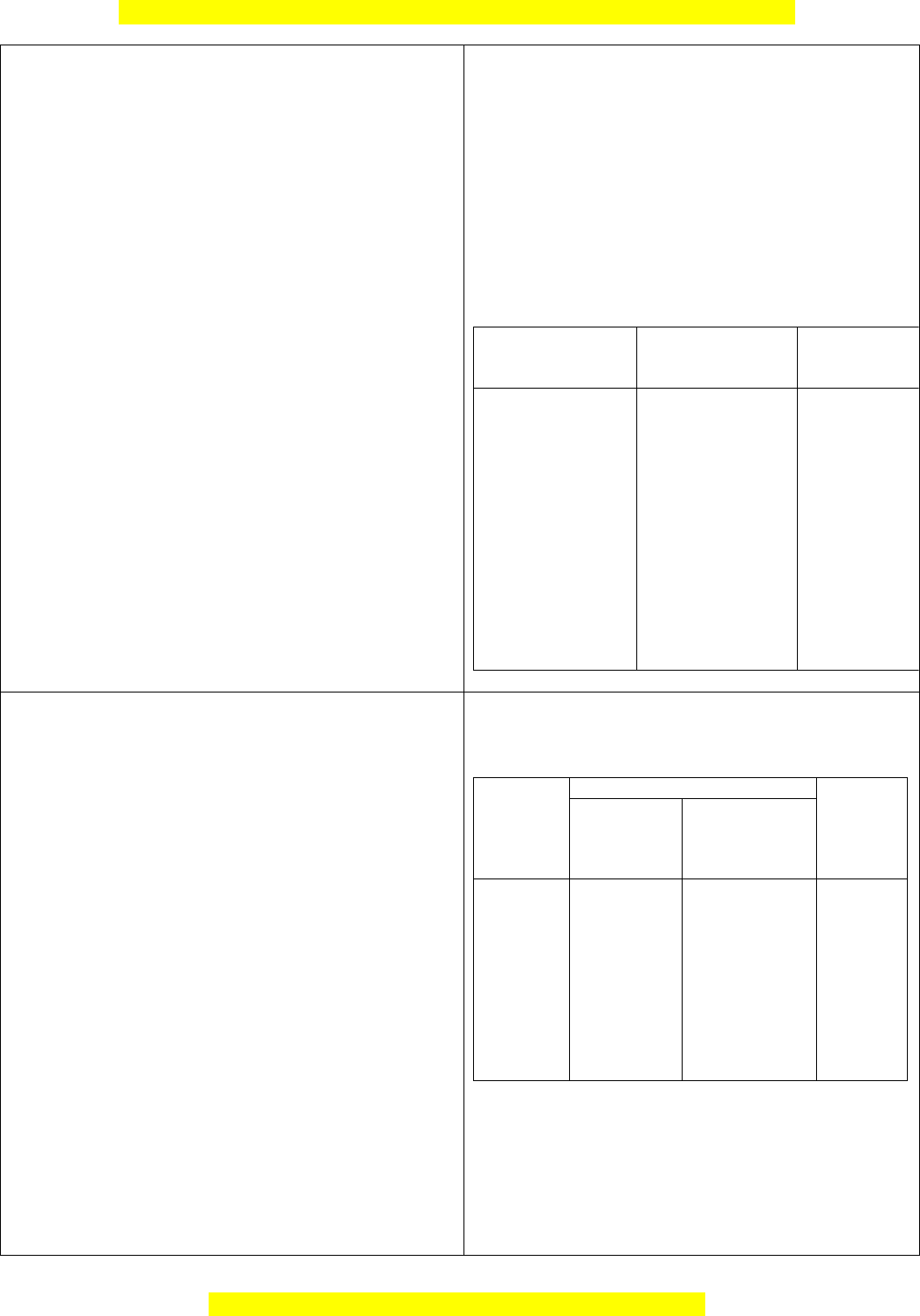
Đây là bản xem thử, vui lòng mua tài liệu để xem chi tiết (có lời giải)
125
Mọi thắc mắc vui lòng xin liên hệ hotline: 084 283 45 85
- Tell Ss to refer to the conversation to find
the expressions. Practise saying the
expressions (play the recording again as a
model if necessary). Pay attention to
intonation when asking for, making, or
responding to recommendations.
-T has Ss work independently. Then allow
them to share their answers before playing
the recording for them to check.
- T plays the recording for Ss to repeat the
phrases. T may remind Ss to pay attention to
the intonation.
3. go by air
4. beautiful sights
5. use rickshaws
6. the museums
b. Read the conversation again and find
the expressions Veronica and Mi use to
ask for, make, and respond to
recommendations.
Key:
Asking for
recommendations
Making
recommendations
Responding to
recommendations
- And do you know
any good places to
stay in Hue City?
- What’s the best
way to get around?
- So what are the
things we shouldn’t
miss – any good
museums?
- So what else is
worth seeing?
- I suggest going by
train.
- I’d recommend
The Romance
Hotel.
- It’s probably best
to use rickshaws.
- Er no, don’t
bother going to the
museums.
- You should
defiitely
s ractice gyal
Citadel.
- That sounds
better.
- Hmm, that’s good
to know.
- Yes, that’s what
I’ve heard.
- Ss work independently to do the matching.
- Allow them to share their answers before
giving comments, and make any corrections.
Ask Ss to work in pairs, practising
ractice gges.
- T may go around to provide help.
- First, have Ss work in pairs to match the
names of the places of interest to the
pictures.
- Then check with the whole class.
2a. Write the responses below into the
correct columns.
Key:
Asking for
recommen
dations
Making recommendations
Respondi
ng to
Recom-
mendatio
ns
Recommendi
ng
things
Not
recommending
things
- What
about
places
outside
Hue City?
- Have
you got
any other
tips?
- It’s well
worth
seeing.
- It’s
probably
best to go by
train.
- You really
must go to
Agra.
- Don’t drink
the water.
- I wouldn’t
eat anything
that’s sold in
the street.
- It isn’t
Ieally worth
seeing.
- Thanks,
that’s
really
useful.
b. Match sentences (1-4) to sentences (a-
d)to make exchanges. Then practise
th racticeges with a partner.
Key:
1. b 2. c 3. d 4. A
3a. Below are some places of interest in

Đây là bản xem thử, vui lòng mua tài liệu để xem chi tiết (có lời giải)
126
Mọi thắc mắc vui lòng xin liên hệ hotline: 084 283 45 85
- T may ask Ss to say the names of these
places of interest in Vietnamese and where
they are situated.
- Ss do the exercise individually and then
compare their answers with a partner.
- Check the answers with the whole class.
Viet Nam. Write them under the pictures.
Key:
1. b 2. c 3. e
4. a 5. f 6. d
b. Now put them in the correct columns.
Natural wonders
Man-made
wonders
l Ha Long Bay
l Phong Nha Cave
l Cuc Phuong
National Park
l Po Nagar Cham
Towers
l One Pillar Pagoda
l Saigon Notre-
Dame Cathedral
4. Application- 14’
a.Aim: Help Ss practice asking and answering about some wonders of Viet Nam.
b. Content : Ss work in pairs to ask and answer the questions about some wonders of Viet
Nam.
c. Outcome: Ss can ask and answer the questions about some wonders of Viet Nam.
d. Performance:
T asks Ss to work in pairs . Ask and answer
the questions about some wonders of Viet
Nam.
- T may go around to provide help.
- Call on some pairs to practise in racticef
the class.
Eg:
A: I had a wonderful trip this summer
vacation.
B: Where did you visit?
A: Cuc Phuong National Park.
B: Wow! Where is it?
A: It is located in Ninh Binh province.
B: What does it have?
A: Cuc Phuong is home to many kinds of
tree and flowers. There are also many
animals there. I did learn many things
about biology during the trip.
* Homework. – 1’
- Write down as many wonders of Viet Nam.
- Prepare: A closer look 1.
-------------------------------------------------------------/
Week 12 – Period 35
UNIT 5 : WONDERS OF VIETNAM
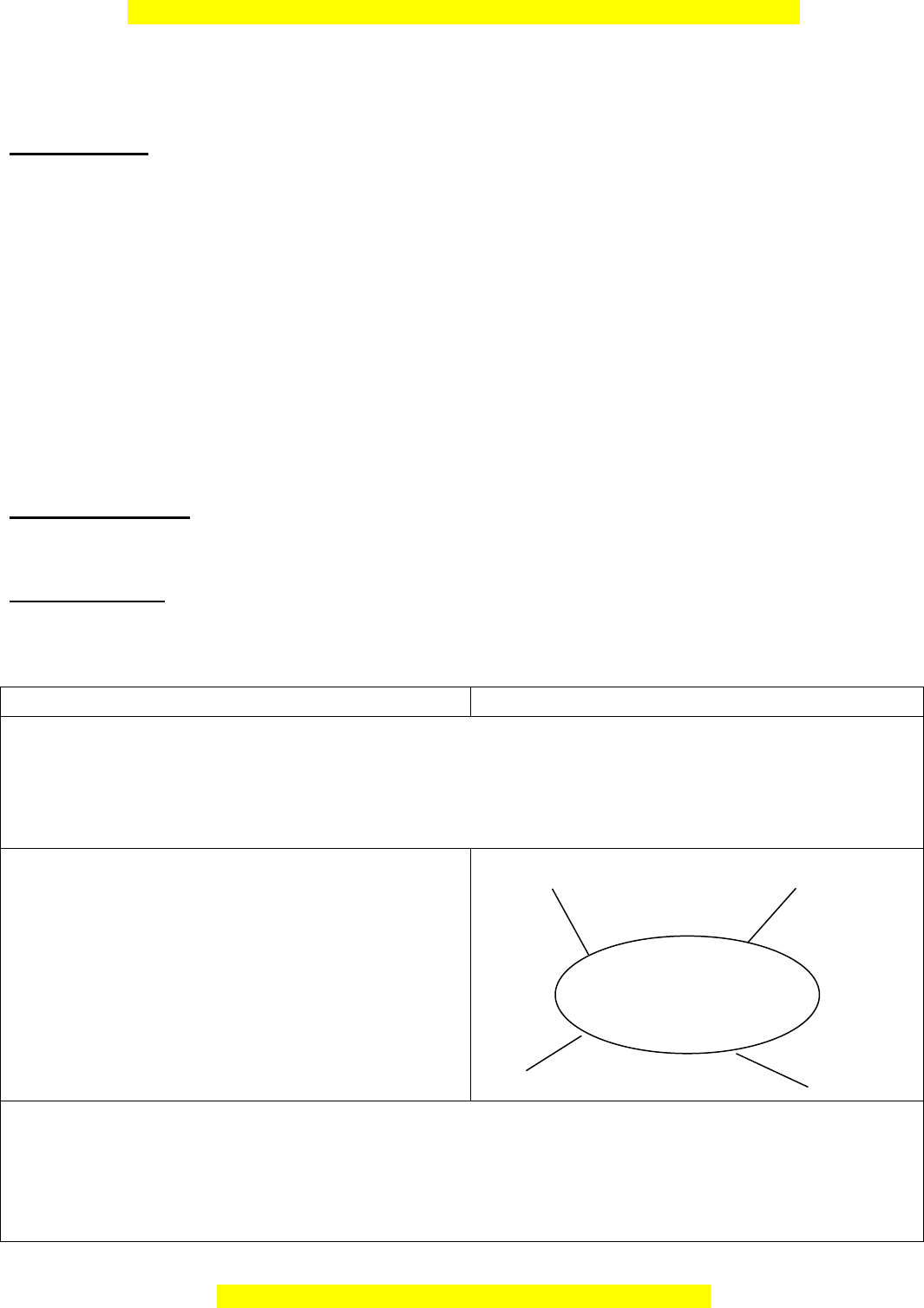
Đây là bản xem thử, vui lòng mua tài liệu để xem chi tiết (có lời giải)
127
Mọi thắc mắc vui lòng xin liên hệ hotline: 084 283 45 85
Preparing date:…. /…./2021
Teaching date:…/…../2021
Lesson 2 : A closer look 1
A. Objectives
1. Knowledge: By the end of the lesson students will be able to:
- Practise vocabulary related to the topic " wonders of Viet Nam".
- Identify in which situations to stress short words (a, of, or, etc.) in sentences and say
these sentences correctly.
- Vocabulary: vocabulary related to wonders of Viet Nam.
- Pronunciation: Stress on short words in sentences.
- Skill: Improve their listening skill, writing skill and pronunciation.
2. Competence: Teamwork and independent working, pair work, linguistic competence,
cooperative learning and communicative competence. Students can use language to describe
about wonders of Viet Nam.
3. Behavior: Ss will be more responsible for and be more aware of protecting and loving the
wonders of Viet Nam.
B. Teaching aids:
1. Teacher: Textbooks, teaching plan, teacher’s book…
2. Students: Textbooks, notebooks…
C. Procedures:
1. Checking: During the lesson.
2. New lesson:
Teacher’s and students’ activities
The main contents
1. Warm up (3’)
a, Aims: To attract Ss’ attention to the lesson and to lead in the new lesson.
b, Contents: Ss write words about places of interest
c, Outcome: Ss can write many words about places of interest.
d, Organization:
- Asks Ss to list places of interest in Viet
Nam.
*Network.
Hue citadel HCM museum
2. Presentation (20’)
a, Aims: Help Ss learn more vocabulary related to the topic " wonders of Viet Nam".
b, Contents:
+ Write the words with the correct pictures.
+ Fill in each blank with a suitable adjective from the box.
Places of
interest

Đây là bản xem thử, vui lòng mua tài liệu để xem chi tiết (có lời giải)
128
Mọi thắc mắc vui lòng xin liên hệ hotline: 084 283 45 85
c, Outcome: Ss can know some vocabularies about places of interest and do vocabulary
exercises well.
d, Organization:
- Ask Ss to do the exercise independently.
Then have them share their answers with one
or more partners. T may ask for translation of
the nouns in the box to check their
understanding. With a stronger class, ask Ss
to find some real-life examples of the nouns
in the box.
- Ss work independently and then share their
answers with one or more partners.
- T may ask for translation of some adjectives
to check their understanding.
1. Vocabulary.
1. Write the words with the correct
pictures.
Key: 1. B 2. D 3. A 4. E 5. C 6. F
2. Fill in each blank with a suitable
adjective from the box.
Key:
1. located/situated
2. picturesque
3. astounding
4. geological
5. administrative
3. Practice (15’)
a, Aims: Help Ss practice more vocabulary related to the topic " wonders of Viet Nam" and
identify in which situations to stress short words (a, of, or, etc.) in sentences and say these
sentences correctly
b, Contents:
+ Match the nouns in A to the definitions in B.
+ Now use the nouns in 3a to complete the sentences.
+ Pronunciation
c, Outcome: Ss can understand vocabulary to do exercise and can identify in which
situations to stress short words (a, of, or, etc.) in sentences and say these sentences
correctly
d, Organization:
- Ss work in pairs to match the nouns to the
definitions. Allow them to share their answers
before checking with the whole class.
- T may ask for translation of the nouns in the
box to check their understanding.
- Have Ss complete the sentences
individually, using the phrases in 3a. Then
have some of them read out their answers
before checking as a class.
3a. Match the nouns in A to the
definitions in B.
Key:
1. b 2. d 3. a 4. e 5. c
b. Now use the nouns in 3a to complete
the sentences.
Key:
1. structure
2. measures
3. setting
4. complex

Đây là bản xem thử, vui lòng mua tài liệu để xem chi tiết (có lời giải)
129
Mọi thắc mắc vui lòng xin liên hệ hotline: 084 283 45 85
5. recognition
- Play the recording and ask Ss to listen and
repeat the sentences, paying attention to
whether the words in red in each sentence are
stressed or not. T may play the recording as
many times as necessary.
- Read through and explain the rule in the
REMEMBER! box and ask some Ss to give
some examples of the cases where the short
words (a, of, the, etc.) are used in the strong
form.
- First, ask Ss to work in pairs to practise
reading aloud the mini-talks and decide in
which sentences the short words are stressed.
Then play the recording. Ss listen and
underline the stressed words. T may pause
after each sentence and ask them to repeat
chorally. Correct their pronunciation if
necessary.
- Ss practise the mini-talks in pairs. T may go
around to provide help.
-Call on some pairs to practise the mini-talks
in front of the class.
- Correct their pronunciation if necessary.
2. Pronunciation
4. Listen and repeat, paying attention to
the words in red in each pair of sentences
REMEMBER!
5. Read the mini-talks and underline the
short words (for, the, from, and, but, at,
of, to) you think use the strong form.
Then listen and check.
Key
1. A: Where are you from?
2. B:It’s OK but you shouldn’t use ‘ and’ at
the beginning of the paragraph.
3. want to.
4. B: No, the letter is to him, not from him.
6. Work in pairs. Practise the mini-talks
in 5.
4. Application (5’)
a, Aims: Help Ss remind the main contents of the lesson
b, Contents: Ss retell the main contents of the lesson.
c, Outcome: Ss can retell the main contents of the lesson
d, Organization:
T asks Ss to retell the main contents of the
lesson
Ss retell the main contents of the lesson
- Vocabulary
- Pronunciation
* Homework.- 2’
- Practice vocabulary and pronunciation again.
- Guide ss how to do EX in WB.
- Prepare: A closer look 2
- T asks Ss to change some reporting verbs into past participle. (say, think, believe,
know, hope, expect, report, understand, claim)
----------------------------------------------------------------/

Đây là bản xem thử, vui lòng mua tài liệu để xem chi tiết (có lời giải)
130
Mọi thắc mắc vui lòng xin liên hệ hotline: 084 283 45 85
Week 12 – Period 36
Preparing date:…. /…./2021
Teaching date:…/…../2021
UNIT 5 : WONDERS OF VIETNAM
Lesson 3 : A closer look 2
A. Objectives
1. Knowledge: By the end of the lesson, SS will be able to:
- Use the impersonal passive and the verb suggest +V-ing / clause with should.
a. Vocabulary: Review vocabulary related to the topic "wonders of Viet Nam".
b. Grammar: The impersonal passive, suggest + V-ing/clause with should.
c. Skills: Sentence completion, writing sentences, rewriting sentences, telling real
situations, reporting.
2. Competence: Teamwork and independent working, pair work, linguistic competence,
cooperative learning and communicative competence.
3. Behavior: Ss will be more responsible for preserving and more aware of protecting the
wonders of Viet Nam.
B. Teaching aids:
1. Teacher: Textbooks, teaching plan, teacher’s book…
2. Students: Textbooks, notebooks…
C. Procedures:
1. Checking: During the lesson.
2. New lesson:
Teacher’s and students’ activities
Contents
1. Warm up (7’)
a, Aims: To warm up the class and lead in the lesson.
b, Contents: Ss work individually to change some reporting verbs into past participle.
c, Outcome: Ss can change some reporting verbs into past participle.
d, Organization:
T asks Ss to change some reporting verbs
into past participle.
Ss go to the board and write
T corrects and asks Ss to read words
T introduces the lesson
* Reporting verbs –> past participle
1. say –> said
2. think –>
3. believe –>
4. know –>
5. hope –>
6. expect –>
7. report –>
8. understand –>
9. claim –>
2. Presentation (10’)
a, Aims: Help Ss use the impersonal passive and use the verb suggest + V-ing/clause with
should
b, Contents: Learn “The impersonal passive”
c, Outcome: Ss can know and use the impersonal passive and use the verb suggest + V-

Đây là bản xem thử, vui lòng mua tài liệu để xem chi tiết (có lời giải)
131
Mọi thắc mắc vui lòng xin liên hệ hotline: 084 283 45 85
ing/clause with should
d, Organization:
T introduces the form the impersonal
passive. And then gives some examples to
illustrate.
Ss listen, copy.
T explains and analyse the rule and the
examples in the box.
- Then ask some Ss to give some more
examples to check understanding.
T explains to Ss the structures used with
the verb suggest and ask them to make
some examples to illustrate.
Ss listen, copy and give examples
1. The impersonal passive
Form:
Active:
S + think/say/… S +V
Passive:
It + to be + past participle + that + S + V
Eg:
Active:
People think he is a great teacher.
Passive:
It is thought that he is a great teacher.
2. Suggest
(+) S + suggest + V-ing
(+) S + suggest + S should + V
Eg:
I suggest going by bike
I suggest we should go by bike
3. Practice (20’)
a, Aims: Help Ss practice doing exercises with the impersonal passive , using the verb
suggest + V-ing/clause with should.
b, Contents:
+ Ss work individually to complete the sentences using the correct passive form of the
verbs in brackets.
+ Ss work individually to write sentences about things we hear using the impersonal
passive.
+ Ss work individually to complete the sentences using suggest + V-ing/clause with
should and the prompts in brackets.
c, Outcome: Ss can practice doing exercises with the impersonal passive , using the verb
suggest + V-ing/clause with should.
d, Organization:
T asks Ss to complete the sentences
independently.
Ss work individually
T asks them to share their answers with a
partner.
Ss work in pair.
T asks some Ss to write the answer .
Ex2. Complete the sentences using the
correct passive form of the verbs in brackets.
Key:
2. It is believed...
3. It is reported …
4. It is claimed that …
5. It is understood that …
6. It is expected …

Đây là bản xem thử, vui lòng mua tài liệu để xem chi tiết (có lời giải)
132
Mọi thắc mắc vui lòng xin liên hệ hotline: 084 283 45 85
T gives comments and corrects.
T asks Ss to explain the exercise and write
the sentences independently, thenask Ss to
work in groups to do exercise.
Ss work independently and work in groups
to do exercise.
T gives comments, and makes any
correction if needed.
T asks Ss to do exercise 5 in pairs.
Ss work in pairs.
T may go around to provide help. Call
some pairs to practise in front of the class.
Ex3. Write sentences about things we hear
using the impersonal passive.
Key:
1. It is claimed that Po Nagar Cham Towers
were built in the 8th century by the Cham
people in central Viet Nam.
2. It is said that the Cham people built Po
Nagar Cham temple complex to honour
Yang Ino Po Nagar, mother of the
kingdom.
3. It is believed that the Po Nagar Cham
Towers were built on the site of an earlier
wooden temple, which was burned by the
Javanese in A.D. 774.
4. It is understood that the Po Nagar Kalan is
the main tower, which is one of the tallest
Cham structures.
5. It is known that a sculpture of the goddess
Mahishasuramardini may be found above the
entrance to the main temple.
6. It is thought that in the 17th century, the
Viet people took over the temple tower,
calling it Thien Y Thanh Mau Tower.
Ex5. Complete the sentences using suggest
+ V-ing/clause with should and the
prompts in brackets.
Key:
2. I suggest the government should limit/
limiting the number of visitors every day.
3. I suggest we should control/ controlling
the deforestation.
4. I suggest we should put/putting these
valuable things in high-security places.
5. I suggest we should raise/raising some
money.
6. I suggest we should reduce/reducing
smoke and exhaust fumes.
4. Application (5’)
a, Aims: Help Ss interact in real situation.
b, Contents:
+ Write the sentences using suggest + V-ing/clause with should
+ Report your partner’s ideas to another partner

Đây là bản xem thử, vui lòng mua tài liệu để xem chi tiết (có lời giải)
133
Mọi thắc mắc vui lòng xin liên hệ hotline: 084 283 45 85
c, Outcome: Ss can tell what should do in the real situations, using suggest + V-
ing/clause with should
d, Organization:
T gives a real situations and explains to Ss
how to give suggestions, using suggest +
V-ing/clause with should
Ss listen and give examples
T asks some Ss to report their previous
partners’ ideas to the whole class.
Ss report
T remarks and corrects
T provides to Ss some real situations (using
cards) and asks Ss to give suggestions,
using suggest + V-ing/clause with should
T asks Ss to go around the class and practise
with their friends
Ss go around the class and practise with their
friends.
Ex 6. Write the sentences using suggest +
V-ing/clause with should
* Practice
Eg:
- Your bicycle has stolen.
A: Oh no! My bike has been stolen.
What should I do now?
B: I suggest calling the police. (I suggest you
should call the police)
* Now report your partner’s ideas to
another partner
Eg:
I asked B what I should do when my bicycle
had been stolen. He suggested calling the
police
* Give 5 situations in the book.
* Give some real situations
1. Your pen has been stolen
2. Your telephone isn’t working.
3. You have broken the flower vase.
4. You have forgotten to turn off the lights.
5. You have forgotten to turn off the faucets.
3. Guides for homework – 3’
- Make 5 sentences using the impersonal passive and 5 sentences using suggest + V-
ing/clause with should .
- Learn the structure by heart.
- Prepare: Communication.
+ Find out names of wonders of Viet Nam
+ Look up the extra vocabulary.
+ Read the sentences and find the meaning part listening
+ Write 6 sentences that describe about places of interest of Viet Nam.
(Place, where, destinations, views, things to do there….)
=======================================/
Date of checking……../………/2021
……………………………………..

Đây là bản xem thử, vui lòng mua tài liệu để xem chi tiết (có lời giải)
134
Mọi thắc mắc vui lòng xin liên hệ hotline: 084 283 45 85
……………………………………..
……………………………………..
Week 13 – Period 37
Preparing date:…. /…./2021
Teaching date:…/…../2021
UNIT 5 : WONDERS OF VIETNAM
Lesson 4 : Communication + Test 15p
A. Objectives
1. Knowledge: By the end of the lesson, ss will be able to:
- Practice describing a wonder of Viet Nam.
- By the end of the lesson, Ss will be able to describe a wonder of Viet Nam.
a. Vocabulary: proper name, contestant, spectacular, round (in a game)
b. Grammar: The simple tense
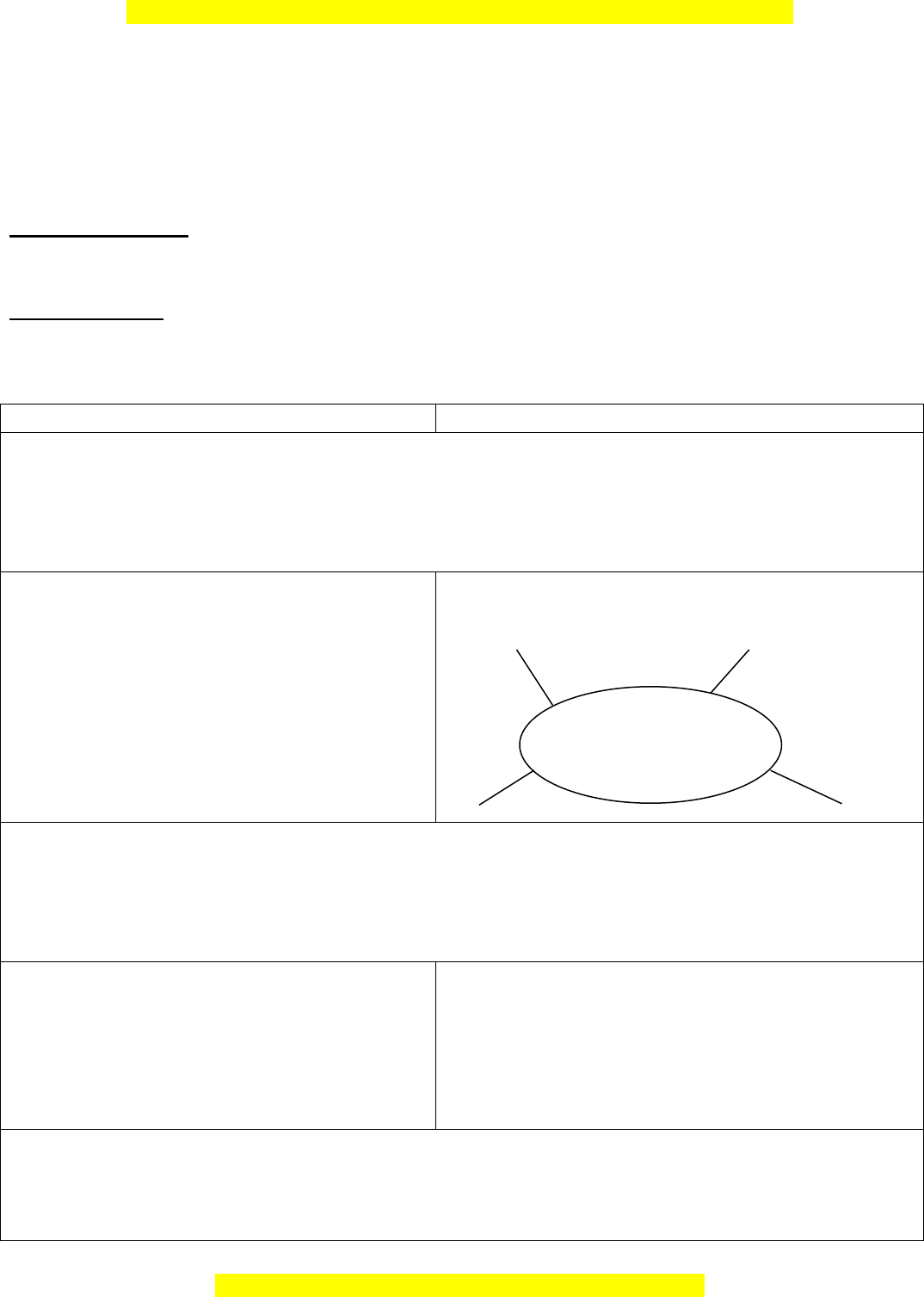
Đây là bản xem thử, vui lòng mua tài liệu để xem chi tiết (có lời giải)
135
Mọi thắc mắc vui lòng xin liên hệ hotline: 084 283 45 85
c. Skills: Listening and deciding on True, False; listening and sentence completion, writing
description sentences, telling description sentences, playing games.
2. Competence: Teamwork and independent working, pair work, linguistic competence,
cooperative learning and communicative competence.
3. Behavior: Ss will be more responsible for preserving and more aware of protecting the
wonders of Viet Nam.
B. Teaching aids:
1. Teacher: Textbooks, teaching plan, teacher’s book…
2. Students: Textbooks, notebooks…
C. Procedures:
1. Checking: During the lesson
2. New lesson:
Teacher’s and students’ activities
The main contents
1. Warm up (5’)
a, Aims: To know names of wonders of Viet Nam and to lead in the new lesson.
b, Contents: Ss write down names of wonders of Viet Nam.
c, Outcome: Ss can write down names of wonders of Viet Nam.
d, Organization:
T asks Ss to write down names of
wonders of Viet Nam.
Ss write down names of wonders of Viet
Nam
T corrects and remarks
T introduces the lesson
*Network.
Phong Nha cave Ha Long Bay
2. Presentation (5’)
a, Aims: Help Ss learn some extra vocabulary.
b, Contents: Ss learn some vocabularies.
c, Outcome: Ss can know some vocabulary words in the lesson
d, Organization:
T helps Ss understand the meanings of the
words in the Extra vocabulary box by
using examples, definitions, or even
translations.
Ss copy and read
1. Extra vocabulary
- proper name (n) : tên riêng
- spectacular (a) :- ngoạn mục:
- contestant (n) : Thí sinh
- round (in a game) : hiep, Vòng trong mộttrò
chơi:
3. Practice (14’)
a, Aims: Help Ss listen for specific information about the text to do exercise well.
b, Contents:
+ Listen and decide whether the following statements are true (T) or false (F).
Wonders of
Viet Nam

Đây là bản xem thử, vui lòng mua tài liệu để xem chi tiết (có lời giải)
136
Mọi thắc mắc vui lòng xin liên hệ hotline: 084 283 45 85
+ Listen and fill in the gaps with the words/numbers you hear.
+ Write six sentences that describe one of the wonders of Viet Nam.
c, Outcome: Ss can listen to a conversation describing wonders of Viet Nam and write 6
sentences about wonders of Viet Nam
d, Organization:
T asks Ss to read sentences and guess
statements are true or false.
Ss guess statements are true or false.
T asks Ss to listen to the tape and decide
whether the following statements are true
or false .
Ss listen and do exercise True or false
T corrects and gives keys
T has Ss read the next part of the radio
programme and guess what the missing
word for each gap in the conversation is.
Ss read and guess.
T plays the recording and asks Ss to close
their books and listen only. Then play the
recording again and allow Ss to fill in the
gaps as they listen.
Ss listen and complete the missing words.
T asks Ss to share their answers in pairs
before playing the recording the final time
to allow pairs to check their answers.
+ Groupwork:
- Divide the class into four groups.
- Time: 5minutes
- Write six sentences to describe (place,
where, destinations, views, things to do
there…)
- T corrects
2. Practice
Ex1. Listen and decide whether the following
statements are true (T) or false (F).
Key: 1. F 2. T 3. F 4. T 5. F
Ex2. Listen and fill in the gaps with the
words/numbers you hear.
Key:
1. central
2. 200 (two hundred)
3. park
4. discovered
5. Paradise
Ex3. Write six sentences that describe one of
the wonders of Viet Nam
Group 1: Phong Nha cave
Group 2: Ha Long Bay
Group 3: One Pillar Pogada
Group 4: Cuc Phuong National Park
4. Application (5’)
a, Aims: Help Ss remember wonders of Viet Nam
b, Contents: Play the game ‘What’s What?
c, Outcome: Ss can guess wonders of Viet Nam
d, Organization:
4. Play the game ‘What’s What? ’

Đây là bản xem thử, vui lòng mua tài liệu để xem chi tiết (có lời giải)
137
Mọi thắc mắc vui lòng xin liên hệ hotline: 084 283 45 85
T explains how to play: (the rules of the
game):
- Describe one of the wonders of Viet
Nam, either natural or man-made. This
description won't include the proper names
of any places.
- Contestants have to work out what the
wonder is.
- Whoever gives the correct answer first is
the winner.
Ss prepare a description and play games: ‘
What’s What?’
T goes around the groups to provide help.
Example 1:
A: It's a famous place in North mountainous
province. It is a historical cultural heritage. It is
the historic of Vietnamese revolution period of
August revolution. Do you know which place is
it?
Ss: The Tan Trao banyan tree.
A: Right.
Example 2:
A: It is located in Na Hang district. It is the third
large one standing after SonLa and Hoa Binh.
Do you know what is it?
Ss: It is hydroelectric power.
A: Right.
* Check 15 minutes- 15’
I. Complete the sentences using the words from the box
physical
technological changes
street vendor
traditions
events
1. Every country has its own customs and……………… .
2. People in the past were slower in accepting ………………… than they are today.
3.Traditionally, weddings and funerals are considered important village…………….. in
Viet Nam.
4. Eating from ……………..……. is a popular habit of people in big cities in Viet Nam.
5. ………………………….punishment was common at schools in the past.
II. What is not correct? Circle A, B, C or D
1. When we are on holiday, we used to go to the beach every day.
A B C D
2. We wish we can consult an expert on how to solve this problem.
A B C D
3. I used to listen to music during I was riding my bicycle to school.
A B C D
4. He said that they will have to set off soon after midnight.
A B C D
5. I wish my mum will talk about her childhood.
A B C D
Code 2
I. Complete the sentences using the words from the box

Đây là bản xem thử, vui lòng mua tài liệu để xem chi tiết (có lời giải)
138
Mọi thắc mắc vui lòng xin liên hệ hotline: 084 283 45 85
illiterate
generation
seniority
a special occasion
loudspeaker
1.
A…………………….is used to make the sound much louder so that many people can
hear it from a distance.
2. There is always a big gap between………………..… . The old sometimes find it difficult
to understand the young.
3. A wedding is………………..…. , not only for the bride and groom but also for other
attendants as they can meet friends and relatives.
4. Paying respect to people of ……………………….…. is a tradition in Viet Nam.
5. Quite a large number of ethnic people in the mountains are still……………….. . They
can’t read or write.
II. What is not correct? Circle A, B, C or D
1.When he lived in Japan, he didn’t used to eat food with forks, but with chopsticks.
A B C D
2. I wish I can learn more about other people’s traditions.
A B C D
3. I wish people in the world don’t have conflicts and lived in peace.
A B C D
4. She said that she will go to Paris the following day.
A B D D
5. I used to walk to school when I am a child.
A B C D
Code 3
I. Complete the sentences using the words from the box
face to face
kept a diary
preserve
stay in shape
bare -footed
1. In the past, most girls …………………….where they could write down their daily
thoughts and feelings.
2. We shoud work together to …………………They are lot of great value to us.
3. Doing exercise helps us keep healthy and ………………….
4. The children in my home village went …………………to school.
5. I prefer talking ………………….to talking on the phone.
II. What is not correct? Circle A, B, C or D
1. He thinks that English is not as difficult than Math.
A B C D
2. When I am young I used to walk to school.
A B C D
3. She wishes she can have a longer summer vacation.
A B C D
4. Did you used to listen to music when you were riding your bike to school?
A B C D
5. He said that they will have to set off soon after midnight.
A B C D
*Keys

Đây là bản xem thử, vui lòng mua tài liệu để xem chi tiết (có lời giải)
139
Mọi thắc mắc vui lòng xin liên hệ hotline: 084 283 45 85
Code 1
I. Complete the sentences using the words from the box
1. traditions
2. technological changes
3. events
4. street vendor
5. physical
II. What is not correct? Circle A, B, C or D
1. A 2. A 3. B 4. B 5. B
Code 2
I. Complete the sentences using the words from the box
1. loudspeaker
2. generation
3. a special occasion
4. seniority
5. illiterate
II. What is not correct? Circle A, B, C or D
1. C 2. B 3. B 4. B 5. D
Code 3
I. Complete the sentences using the words from the box
1. kept a diary
2. preserve
3. stay in shape
4. bare –footed
5. face to face
II. What is not correct? Circle A, B, C or D
1. D 2. B 3. B 4. A 5. B
3. Guides for homework – 1’
- T asks Ss to describe place of interest of their hometown
- Learn new words/ workbook: C. Speaking
- Prepare next lesson: Skills 1.
+ Find out man-made wonder of Viet Nam
+ Read about Perfume Pagoda and answer the questions
+ Find ways to protect and preserve man-made wonders of Viet Nam
------------------------------------------------/
Week 13 – Period 38
Preparing date:…. /…./2021
Teaching date:…/…../2021
UNIT 5 : WONDERS OF VIETNAM
Lesson 5 : Skills 1

Đây là bản xem thử, vui lòng mua tài liệu để xem chi tiết (có lời giải)
140
Mọi thắc mắc vui lòng xin liên hệ hotline: 084 283 45 85
A. Objectives
1. Knowledge: By the end of the lesson, SS will be able to:
- Practice reading about Perfume Pagoda and talking about man-made wonders of Viet Nam
and how to protect and preserve them
- Read for specific information about a man-made wonder of Viet Nam.
- Talk about man-made wonders of Viet Nam and how to protect and preserve them.
a. Vocabulary: - vast, pilgrim, theme, backdrop, reign
b. Grammar: The impersonal passive and suggest
c. Skills: scanning, comprehension reading, reading and answering, Giving the reasons,
speaking ideas, reporting
2. Competence: Groupwork, independent working, pairwork, linguistic competence,
cooperative learning and communicative competence.
3. Behavior: Ss will be more responsible for preserving and more aware of protecting the
man - made wonders of VN Huong Pagoda.
B. Teaching aids:
1. Teacher: Textbooks, teaching plan, teacher’s book…
2. Students: Textbooks, notebooks…
C. Procedures:
1. Checking: During the lesson.
2. New lesson:
Teacher’s and students’ activities
The main contents
1. Warm up (3’)
a, Aims: To attract Ss’ attention to the lesson and to lead in the new lesson.
b, Contents: Chatting
c, Outcome: Ss can answer the questions well.
d, Organization:
T asks Ss some questions.
Ss answer the questions
T introduces the new lesson.
* Chatting.
- Do you know any man-made wonder of Viet
Nam?
- Can you tell me some man-made wonder of
Viet Nam you know?
- Have you ever visited Perfume Pagoda?
- Can you retell some information about it?
2. Presentation (17’)
a, Aims: Help Ss read the information about Perfume Pagoda and know some vocabularies
related to Perfume Pagoda.
b, Contents: Discuss the question: ‘What conditions are the man-made wonders of Viet
Nam in right now?’.
c, Outcome: Ss can know some vocabularies related to Perfume Pagoda.
d, Organization:
+ Groupwork
1. Reading

Đây là bản xem thử, vui lòng mua tài liệu để xem chi tiết (có lời giải)
141
Mọi thắc mắc vui lòng xin liên hệ hotline: 084 283 45 85
- Divide the class into two groups
- Discuss the question: ‘What conditions
are the man-made wonders of Viet Nam in
right now?’
- Time: 3minutes
- Remarks
T asks Ss to scan the article to find the
words: vast, pilgrims, theme, backdrops,
and reign.
T helps Ss work out the meanings of these
words from the context.
Ss read the vocabulary
Here are some ideas:
+ in good condition
- safe
- restored
- protected against people and nature
+ in bad condition
- unsafe
- in ruins, falling down
- unprotected against people and nature
* Vocabulary
+ Vast (adj) =
extremely large in area, size, amount, etc.
+ Pilgrims (n) = hành hương
a person who travels to a holy space for
religious reasons.
+ Theme (n) = đề tài, chủ đề
the subject or main idea in a talk, piece of
writing, or work of art
+ Backdrop (n) = phông màn, nền
the general scene in which an event takes
place
+ Reign (n) = triều đại, thời gian trị vì
the period during which a king, queen,
emperor, etc. rule
3. Practice (18’)
a, Aims: Help Ss Read for specific information about a man-made wonder of Viet Nam and
do exercises.
b, Contents:
+ Read and answer the questions.
+ Work in pairs. Put them in order of seriousness. Give your reasons.
+ Give ways to protect and preserve the man-made wonders of Viet Nam.
+ Report your best ideas to the class.
c, Outcome: Ss can understand the content of the text and do exercises correctly
d, Organization:
T may set a longer time limit for Ss to read
the text again and answer the questions.
Ss read and answer the questions.
T asks Ss to note where they find the
information that helps them to answer the
questions.
Ss can compare their answers with a
Ex 2. Read and answer the questions.
Key:
1. It is located in Huong Son Commune, My
Duc District, Ha Noi.
2. It includes Den Trinh (Presentation Shrine),
Thien Tru (Heaven Kitchen) Pagoda, and the
Perfume Temple.
3. The centre of this complex, the Perfume

Đây là bản xem thử, vui lòng mua tài liệu để xem chi tiết (có lời giải)
142
Mọi thắc mắc vui lòng xin liên hệ hotline: 084 283 45 85
partner before discussing them as a class.
T corrects the mistakes
T asks Ss to work in pairs, to put the
things that have caused damage to the
man-made wonders of Viet Nam in order
of seriousness. T may go around to
provide help.
Ss report their choices and give the
reasons for them.
T asks Ss to work in pairs, and use the
ideas in 3 to suggest ways to protect and
preserve the man-made wonders of Viet
Nam.
Ss practise in pairs
T goes round to provide help.
T has the representative of each pair in
turn report their best ideas to the whole
class.
- Give comments and make any correction
if necessary.
Temple, also known as Chua Trong (Inner
Temple), is located in Huong Tich Cavern.
4. Its beauty has been used as a theme of many
famous songs and a topic of lyric poetry.
5. Pilgrims from all over Viet Nam do.
2. Speaking
Ex 3. Work in pairs. Put them in order of
seriousness. Give your reasons.
Keys
b-a-c-d-e
Ex4a. Give ways to protect and preserve the
man-made wonders of Viet Nam.
Eg:
A: It is reported that many of our man- made
wonders have been damaged. What should we
do to protect and preseve them?
B: I suggest that we shouldn’t build factories
and hotels around man- made wonders.
A: I agree with you. I suggest that the local
governments hve long-term measures to
protect man-made wonders from servere
weather conditions.
b. Report your best ideas to the class.
Example:
We suggested that we shouldn’t build factories
and hotels around man- made wonders. And
we suggest that the local governments have
long-term measures to protect man-made
wonders from servere weather conditions.
4. Application (5’)
a, Aims: Ss can interact in real situation.
b, Contents: Ss talk ways to protect and preserve about man-made wonders of your
hometown
c, Outcome: Ss can ways to protect and preserve about man-made wonders of your
hometown
d, Organization:
T asks Ss to talk ways to protect and
Example:

Đây là bản xem thử, vui lòng mua tài liệu để xem chi tiết (có lời giải)
143
Mọi thắc mắc vui lòng xin liên hệ hotline: 084 283 45 85
preserve about man-made wonders of your
hometown
Ss talk
T corrects
We suggested limiting the number of tourists
who can visit these important sites per day.
3. Guides for homework. – 2’
- Practice talking about ways to protect and preserve the man-made wonders of Viet
Nam.
- Prepare next lesson: Skills 2
Make note about a wonder of Viet Nam they visit
+ Name
+ Location
+ Reasons for choosing the place.
+ Main features of the place.
+ Comments and feelings about the place
----------------------------------------------------/
Week 13 – Period 39
Preparing date:…. /…./2021
Teaching date:…/…../2021
UNIT 5 : WONDERS OF VIETNAM
Lesson 6 : Skills 2
A. Objectives
1. Knowledge: By the end of the lesson, SS will be able to:
- Listen for specific information about a natural wonder of Viet nam.
- Write an article describing a wonder of Viet Nam.
a. Vocabulary: about wonders of Viet Nam.
b. Grammar: Review
c. Skills: Listening and deciding on True, False, listening and complete the table, writing a
paragraph and presentation to the class.
2. Competence: independent working, pairwork, linguistic competence, cooperative learning
and communicative competence.
3. Behavior: Talk about a natural disaster, ask and answer questions about what to do when
a natural disaster happens.
B. Teaching aids:
1. Teacher: Textbooks, teaching plan, teacher’s book…
2. Students: Textbooks, notebooks…
C. Procedures:
1. Checking: During the lesson.
2. New lesson:
Teacher’s and students’ activities
The main contents

Đây là bản xem thử, vui lòng mua tài liệu để xem chi tiết (có lời giải)
144
Mọi thắc mắc vui lòng xin liên hệ hotline: 084 283 45 85
1. Warm- up (3’)
a, Aims: To attract Ss’ attention to the lesson and to lead in the new lesson.
b, Contents: Chatting
c, Outcome: Ss can answer some questions
d, Organization:
T asks Ss some qs.
Ss answer
*Chatting.
- Have you visited Ha Long Bay?
- Can you describe it?
- Do you think it is a place of interest?
2. Presentation (10’)
a, Aims: Help Ss know how to describe about wonder of Viet nam
b, Contents: How to describe about wonder of Viet nam
c, Outcome: Ss can set the sence of the listenning.
d, Organization:
T guides Ss to listen and write about wonder of
Viet Nam they have know (Read: Remember)
Ss listen to the teacher to know how to listen
and write about wonder of Viet Nam they have
know
* How to describe about wonder of
Viet nam
1. Name:
2. Location:
3. Reasons for choosing the place:
4. Main features of the place:
5. Comments and feelings about the
place:
3. Practice (20’)
a, Aims: Help Ss listen for specific information about a natural wonder of Viet nam and
do exercise and Ss can understand how to write an article describing a wonder of Viet
Nam.
b, Contents:
+ Listen and decide whether the following statements are true (T) or false (F).
+ Listen again and complete the data chart
+ Make notes about a wonder of Viet Nam you have read about.
+ Use your notes in 3 to write a short article describing a wonder of Viet Nam and Then
present your final article to the class.
c, Outcome: Ss can listen for specific information about a natural wonder of Viet nam
and do exercise and Ss can understand how to write an article describing a wonder of
Viet Nam.
d, Organization:
T asks Ss to read the instruction carefully and
remind them to underline the key words in the
statements.
I. Listening
1. Listen and decide whether the
following statements are true (T) or

Đây là bản xem thử, vui lòng mua tài liệu để xem chi tiết (có lời giải)
145
Mọi thắc mắc vui lòng xin liên hệ hotline: 084 283 45 85
T plays the recording and asks Ss to decide
whether the statements are true or false. Then
ask two or three Ss to write their answers on the
board.
- Play the recording again for Ss to check the
answers.
T asks Ss to work in pairs to discuss the
missing word for each gap from the
information they have heard in1. Play the
recording again and allow Ss to fill in the gaps
as they listen. Ask Ss to share their answers in
pairs before playing the recording the final time
to allow pairs to check their answers.
T asks Ss to make notes about a wonder of Viet
Nam that they or their family members have
visited in the given table. Remind them that
they do not have to write full sentences and
they can use abbreviations.
Then ask Ss to share their notes with their
partners.
- T may ask some more able Ss to read out their
notes to the whole class.
T can also help them get started by writing the
opening sentence on the board, based on the
audio script:
It is said that [wonder] is a [adjective] place …
- Ask Ss to write the first draft. T may go
around to comment or provide help. Then have
Ss write their final version in class or at home.
If they write in class, they can also do it in pairs
or groups. T may display all or
some of the work on the wall/notice board.
- Other Ss and T give comments.
- Ss edit and revise their writing for homework.
false (F).
Key: 1. T 2. F 3. T 4. T
2. Listen again and complete the data
chart.
Key:
1. northeast
2. UNESCO
3. picturesque
4. zones
5. caverns
6. astounding
II. Writing
3. Make notes about a wonder of Viet
Nam you have read about.
4. Use your notes in 3 to write a short
article describing a wonder of Viet
Nam and Then present your final
article to the class.
4. Application (10’)
a, Aims: Ss can talk about wonders of Viet Nam.
b, Contents: Ss describe wonders of Viet Nam

Đây là bản xem thử, vui lòng mua tài liệu để xem chi tiết (có lời giải)
146
Mọi thắc mắc vui lòng xin liên hệ hotline: 084 283 45 85
c, Outcome: Ss can talk an article describing a wonder of Viet Nam.
d, Organization:
T asks Ss to describe wonders of Viet Nam
Ss talk
T corrects the mistakes
* Homework- 2’
- Revise the writing.
- Prepare next lesson: Looking back - Project.
Guide Ss to do exercise part: Looking back
=======================================/
Date of checking……../………/2021
……………………………………..
……………………………………..
……………………………………..
Week 14 – Period 40
Preparing date:…. /…./2021
Teaching date:…/…../2021
UNIT 5 : WONDERS OF VIETNAM
Lesson 7 : Looking back & project
A. Objectives
1. Knowledge: By the end of the lesson students will be able to:
- Review all the vocabularies, grammar and language function in Unit 5.
- Practice vocabulary and grammar points they have learnt in this unit.
- Practice making communication, project.
a, Vocabulary: Vocabulary about wonders of Viet Nam.
b, Structure: the impersonal passive, suggest + V-ing/a clause with should.
c. Skill: matching adjectives t definitions, choosing words, sentences completion, rewriting,
speaking in real situation, completing the dialogue.
2. Competence: develop the competences of communication, cooperation and using
languages and problem solving in doing exercises
3. Behavior: Ss have aware of protecting the wonders of Viet Nam.
B. Teaching aids:
1. Teacher: Textbooks, teaching plan, teacher’s book…
2. Students: Textbooks, notebooks…
C. Procedures:
1. Checking: During the lesson.
2. New lesson:
Teacher’s and students’ activities
The main contents
1. Warm up (3’)
a, Aims: To warm up the class.
b, Contents: Ss work individually to sing an English song.

Đây là bản xem thử, vui lòng mua tài liệu để xem chi tiết (có lời giải)
147
Mọi thắc mắc vui lòng xin liên hệ hotline: 084 283 45 85
c, Outcome: Ss can know sing an English song well.
d, Organization:
T lets Ss sing a song
Ss ing a song
2. Vocabulary (15’)
a, Aims: Help Ss review the vocabularies related to the topic: “wonders of Viet Nam”
b, Contents: Review some vocabularies they have learnt about communication
+ Ss work individually to match adjectives (1-5) in column A to definitions (a-e) in
column B.
+ Ss work individually to underline the correct word in each sentence.
+ Ss work ndividually to use the words from the box to complete the sentences.
c, Outcome: Ss can review some vocabularies they have learnt about communication and
do vocabulary exercises well.
d, Organization:
- Have Ss work independently.
- Then they can check their answers with
a partner before discussing the answers as a
class.
- However, tell Ss to keep a record of
their original answers so they can use that
information in their self-assessment.
- Ss work independently.
- Then they can check their answers with
a partner before discussing the answers as a
class.
- Ss work independently, and check their
answers with a partner.
- Give the answers as a class.
1. Match adjectives (1-5) in column A to
definitions (a-e) in column B.
Key:
1. b 2. d 3. a 4. e 5. c
2. Underline the correct word in each
sentence.
Key:
1. fortress
2. limestone
3. cavern
4. tombs
3. Use the words from the box to complete
the sentences.
Key: 1. complex
2. measures
3. recognition
4. setting
5. structure
3. Grammar (10’)
a, Aims: Help Ss review the impersonal passive and use the verb suggest
b, Contents: Review grammar points
+ Ss work rewrite the following sentences using the impersonal passive.
+ Ss work individually imagine four bad things that happened to you yesterday, and ask
your partner what you should do in each situation.
c, Outcome: Ss can Review the structures they have learnt about communication and do

Đây là bản xem thử, vui lòng mua tài liệu để xem chi tiết (có lời giải)
148
Mọi thắc mắc vui lòng xin liên hệ hotline: 084 283 45 85
grammar exercises well.
d, Organization:
- Have Ss work independently.
- Then they can check their answers with
a partner before discussing the answers as
a class.
- Ask Ss to work individually to write
down four bad things that happened to
them yesterday. Then have Ss discuss
with a partner what they should do in each
situation, use the verb suggest .
4. Rewrite the following sentences using
the impersonal passive.
1. It is expected that more than 100,000
people will attend the festivals at the
Perfume Pagoda this year.
2. It has been reported that Thien Duong is
the longest cave in Viet Nam.
3. It is believed that the Perfume Pagoda was
built during the reign of Le Thanh Tong in
the 15
th
century.
4. It is said that Ha Long Bay is one of the
most extraordinary natural wonders you will
ever see.
5. It is hoped that many defensive measures
will be taken to protect and preserve our
man-made wonders.
5. Imagine four bad things that happened
to you yesterday, and ask your partner
what you should do in each situation.
Eg: - Your bicycle has stolen.
A: Oh no! My bike has been stolen.
What should I do now?
B: I suggest calling the police. (I suggest you
should call the police)
4. Communication. (5’)
a, Aims: Help Ss practice making communication.
b, Contents:
+ Ss work in pairs to make travel suggestions using the prompts and respond to them.
+ Ss work individually to choose A-F to complete the following conversation. Practise
the conversation with your partner.
c, Outcome: Ss can Review the structures they have learnt about communication and do
grammar exercises well.
d, Organization:Aim:
- Model this activity with a more able
student. Ask Ss to work in pairs, one
student using prompts in the box to make
suggestions and another responding to
them T may have Ss refer to how to make
and respond to suggestions or
6. In pairs, make travel suggestions using
the prompts and respond to them.
Example:
A: It’s well worth going to the Perfume
Pagoda.
It’s very picturesque.

Đây là bản xem thử, vui lòng mua tài liệu để xem chi tiết (có lời giải)
149
Mọi thắc mắc vui lòng xin liên hệ hotline: 084 283 45 85
recommendations in GETTING
STARTED.
- Go around to provide help.
- Call on some pairs to practise in front of
the class.
- First, ask Ss to do the task individually
to choose the sentences (A-F) to complete
the conversation.
- Then ask them to check their answers
with a partner. Confirm the correct
answers. Ask Ss to practise the
conversation with their partner.
- Finally, ask Ss to complete the self-
assessment. Identify any difficulties and
weak areas and provide further practice.
B: Yes, that’s what I’ve heard
7. Choose A-F to complete the following
conversation. Practise the conversation
with your partner.
Key:
1. E 2. D 3. F 4. A 5. C 6. B
5. Project (10’)
a, Aims: Help Ss do project about communication breakdown.
b, Contents: Ss work in groups to do the project.
c, Outcome: Ss can know how to do the project and finish their project well.
d, Organization:
GUIDE STUDENT, ASK THEM TO
DO AT HOME
- Ask Ss to read the brochure about the
Complex of Hue Monuments and point
out what information should be included
in a brochure about a place of interest.
- Ask each group to choose one of the
wonders of Viet Nam they have visited
and design a brochure about it.
- Let Ss complete the project as
homework.
- Check their brochures in the next lesson,
T asks them to display their leaflets on the
wall/notice board.
T may choose some of the brochures and
ask Ss to give comments. Finally, ask the
whole class to vote for the best.
1. Read this promotional brochure about
a man-made wonder of Viet Nam.
2. Find a photo or draw a picture of a
wonder of Viet Nam you have visited.
Create a similar promotional brochure
about it
3. Organise an exhibition of posters you
have made among your group or class
members. Vote for the best.
* Homework- 2’
- Complete the project.
- Prepare next lesson: Unit 6- lesson 1
-------------------------------------------------------/
Week 14 – Period 41
UNIT 6 : VIET NAM THEN AND NOW

Đây là bản xem thử, vui lòng mua tài liệu để xem chi tiết (có lời giải)
150
Mọi thắc mắc vui lòng xin liên hệ hotline: 084 283 45 85
Preparing date:…. /…./2021
Teaching date:…/…../2021
Lesson 1 : Getting started
A. Objectives
1. Knowledge: By the end of the lesson students will be able to:
- Use the lexical items related to changes in transport systems, family groups, and school life
in Viet Nam in the past and at present.
- Interact a conversation about school life in Viet Nam in the past.
- Practice the conversation to understand about school in the past.
- Listen and read the conversation of Duong, Phuc, Tom and Nhi about their school in the
past for details.
- Talk about the changes of their own school.
a. Vocabulary: related to transport systems, family groups, and school life.
b. Grammar: adj + to-infinitive
c. Skills: Listening and reading, Deciding on True, False or not given statements, reading
and answering the questions, Sentence completion, interviewing, speaking.
2. Competence: Teamwork and independent working, pair work, linguistic competence,
cooperative learning and communicative competence
3. Behavior: Ss are interested talking about Viet Nam in the past and at present. Ss have
aware of protecting the traditions and promoting them in the future.
B. Teaching aids:
1. Teacher: Textbooks, teaching plan, teacher’s book…
2. Students: Textbooks, notebooks…
C. Procedures:
1. Checking: During the lesson.
2. New lesson:
Teacher’s and students’ activities
The main contents
1. Warm up (3’)
a, Aims: To attract Ss’ attention to the lesson and to lead in the new lesson.
b, Contents: Game.
c, Outcome: Ss can brainstorm some ideas about about things in the past and at present.
d, Organization:
+ Groupwork
- Time: 3 minutes
- Devide the class into two groups
- Ask each group to write sentences
about things in the past and at present
- Each member in each group goes to
the board to write sentences
- T remarks and gives point
* Game.
Group 1: things in the Past
- Students went bare-footed to school
- Students kept a diary
- Students walked to school
…
Group 2: things at present
- Students go to school by bus
- Students play games, watch TV
-…
2.Presentation (20’)

Đây là bản xem thử, vui lòng mua tài liệu để xem chi tiết (có lời giải)
151
Mọi thắc mắc vui lòng xin liên hệ hotline: 084 283 45 85
a, Aims: Help Ss read a conversation about school life in Viet Nam in the past
b, Contents:
+ Ss study the new words related to the topic. Then work in groups to listen and read.
+ Put a word/phrase from the box under each picture.
+ Find a word in the conversation that means
c, Outcome: Ss can understand the conversation and do some exercises related to the
conversation correctly.
d, Organization:
T asks Ss to look at the picture and
answer the question
Ss answer the questions
T introduces the dialouge and asks Ss to
listen to the tape.
T teaches new words by doing exercise
a.
Ss do exercise a.
T explain the words that Ss don’t
understand.
Then ask some Ss to read the
words/phrases aloud and correct their
pronunciation if necessary.
T has Ss work independently. Ss find
the words with the given meaning in the
conversation. Then have Ss share their
answers with a partner before asking
them to discuss as a class.
- Explain the use of structure adj + to-
infi.
1. Listen and read.
Questions:
• Who can you see in the picture?
• Where do you think they are?
• Is there anything in the small pictures on the
wall related to past and present?
* Vocabulary
- thatched house
(n):
nhà tranh mái lá
- trench
(n):
hào giao thông
- tiled roof
(n):
mái ngói
a. Put a word/phrase from the box under each
picture.
Key:
1. Trench
2. tiled roof
3. facilities
4. photo exhibition
5. rubber sandals
6. thatched house
b. Find a word in the conversation that means:
Key:
1. anniversary
2. fascinating
3. missing
4. conditions
5. improved
6. proper
* Stucture
adj + to V
eg:
It is fascination to see how the school used to
look.
3.Practice (15’)
a, Aims: use the words related to the topic “life in the past”.

Đây là bản xem thử, vui lòng mua tài liệu để xem chi tiết (có lời giải)
152
Mọi thắc mắc vui lòng xin liên hệ hotline: 084 283 45 85
b, Contents:
+ Read and decide whether the information is true (T) or false (F), or not given (NG).
+ Read again and answer the questions.
+ Complete each sentence.
c, Outcome: Ss can understand a conversation about school life in Viet Nam in the past and
do exercise. Use the lexical items related to changes in transport systems, family groups,
and school life in Viet Nam in the past and at present.
d, Organization:
T asks Ss to read sentences and decide
whether the information is true (T) or
false (F), or not given (NG).
Ss do exercise and write the correct
answers on the board and explain for
their choices
T remarks
T asks Ss to answer the questions in
pairs
Ss answer inpairs
T gives correct answers.
T has Ss read the Remember! Box
individually. Then go through the
points as a class and see if any Ss can
make sentences using these adjectives
and adverbs. Afterwards, ask Ss to
work individually on the gap-fill
exercise.
- Check the answers as a class.
c. Read and decide whether the information is
true (T) or false (F), or not given (NG).
Key:
1. F (It was founded in the 1960s.) 2. T
3. F (They wore rubber sandals and straw hats.)
4. NG
5. T
d. Read again and answer the questions.
Key:
1. The conversation takes place on the school’s
60th anniversary.
2. Because it explains a lot about how the school
was in the past.
3. There were trenches outside the classrooms.
4. The roof was made of tiles and some tiles were
broken. The window frames were made of wood
and some of them were missing.
5. They can learn that they are lucky to have such
great learning facilities nowadays.
2. Complete each sentence.
Key:
1. slight
2. dramatically
3. significantly
4. considerable
5. gradual
4.Application (5’)
a, Aims: Help Ss make an interviewer
b, Contents: Interview your teacher about the features of your school when she/he started
teaching here. Then use the information provided to talk about the changes to your school.
c, Outcome: Ss can interview your teacher about the features of your school when she/he
started teaching here.
d, Organization:

Đây là bản xem thử, vui lòng mua tài liệu để xem chi tiết (có lời giải)
153
Mọi thắc mắc vui lòng xin liên hệ hotline: 084 283 45 85
T asks Ss to work in pairs about the
features of your school. T gives
examples
Ss work in pairs
T observes and corrects the mistakes.
- Now have Ss work in small groups to
talk about the changes to the school.
Ask them to use the adjectives and
adverbs in Remember! box.
- T can tell Ss that they can talk about:
+ the school principal and school
teachers
+ the school playground
+ the library
+ the computer room
+ the classroom
3. Interview your teacher about the features of
your school when she/he started teaching here.
Then use the information provided to talk
about the changes to your school.
Eg:
S: Can you tell me about the features of your
school when you started teaching here?
T: Sure. I have taught here for 15 years. The
school is small. There are more 40 teachers.
There used to be 14 classrooms here. The
dormitory is small and it had 14 rooms.
3. Guides for homework- 2’
- Practice talking about your school in the past and in the present.
- Prepare: A closer look 1.
+ List names of changes in transport systems that they know in Viet Nam.
+ Do exercise part Vocabulary
---------------------------------------------------------/
Week 14 – Period 42
Preparing date:…. /…./2021
Teaching date:…/…../2021
UNIT 6 : VIET NAM THEN AND NOW
Lesson 2 : A closer look 1
A. Objectives
1. Knowledge: By the end of the lesson students will be able to:
- Use the lexical items related to changes in transport systems, family groups, and school
life in Viet Nam in the past and at present.
- Identify in which situations to stress all the words in sentences and say these sentences
correctly.
- Practice the conversation to understand about school in the past.
a. Vocabulary: tram, flyover, elevated walkway, Sky train, underpass, Tunnel.
b. Grammar: The past simple
c. Pronunciation: Stress on all the words in sentences
d. Skills: Matching words with pictures, sentence completion, matching words with
definition, listening and repeating
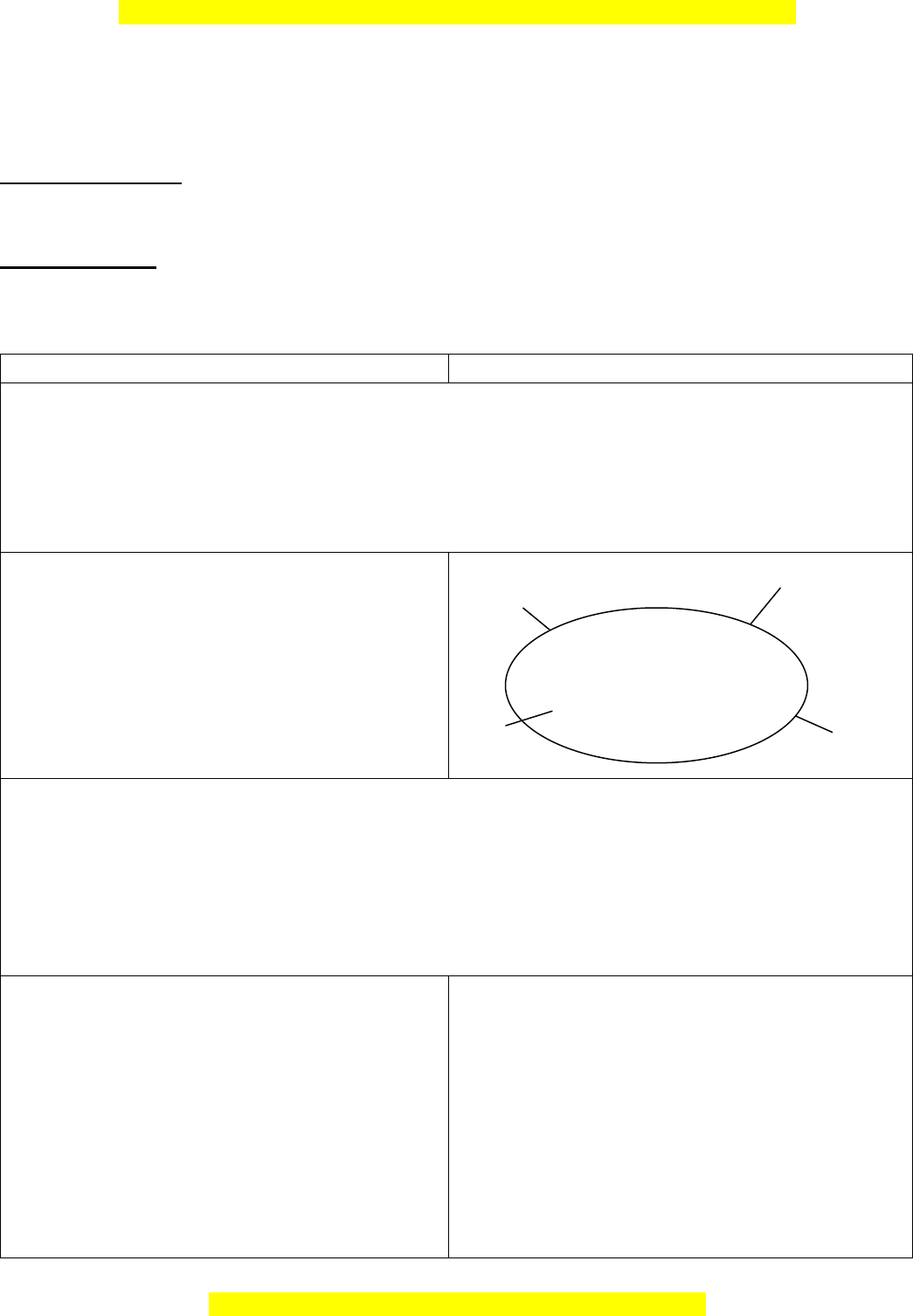
Đây là bản xem thử, vui lòng mua tài liệu để xem chi tiết (có lời giải)
154
Mọi thắc mắc vui lòng xin liên hệ hotline: 084 283 45 85
2. Competence: Teamwork and independent working, pair work, linguistic competence,
cooperative learning and communicative competence
3. Behavior: Ss are interested talking about Viet Nam in the past and at present and Ss have
aware of protecting the traditions and promoting them.
B. Teaching aids:
1. Teacher: Textbooks, teaching plan, teacher’s book…
2. Students: Textbooks, notebooks…
C. Procedures:
1. Checking: During the lesson.
2. New lesson:
Teacher’s and students’ activities
The main contents
1. Warm up (5’)
a, Aims: To attract Ss’s attention to the lesson and to lead in the new lesson.
b, Contents: Ss list names of means of transport systems that they know in Viet Nam.
c, Outcome: Ss can list names many means of transport systems that they know in Viet
Nam.
d, Organization:
T asks Ss to list names of means of
transport systems that they know in Viet
Nam.
Ss list names of means of transport systems
that they know in Viet Nam.
T introduces the lesson
*Network.
Hai van tunnel
2. Presentation (18’)
a, Aims: Help Ss know the lexical items related to changes in transport systems, family
groups, and school life in Viet Nam in the past and at present
b, Contents: Learn some vocabularies.
c, Outcome: Ss can know the lexical items related to changes in transport systems, family
groups, and school life in Viet Nam in the past and at present and do exercises well.
d, Organization:
T teaches vocabulary words by using
picture.
Ss copy and read
T asks some questions:
- Have you ever tried one of these means of
transport or road systems?
- How do you feel about using each of these
means of transport or road systems?
I. Vocabulary
a. Transport systems
1. tram
2. flyover
3. elevated walkway
4. Sky train
5. underpass
6. Tunnel
names of means of
transport or road
systems

Đây là bản xem thử, vui lòng mua tài liệu để xem chi tiết (có lời giải)
155
Mọi thắc mắc vui lòng xin liên hệ hotline: 084 283 45 85
Ss answer the questions
T introduces some other words
Ss copy and read.
b. other words
1. extended family
2. sympathetic
3. obedient
4. tolerant
5. nuclear family
6. Cooperative
3. Practice (15’)
a, Aims: Help Ss practice the lexical items related to changes in transport systems, family
groups, and school life in Viet Nam in the past and at present and identify in which
situations to stress all the words in sentences.
b, Contents:
+ Fill in each blank with a suitable word from1.
+ Match each word/phrase in the left column with the definition in the right one.
+ Fill each gap with a word/phrase in 3.
+ Pronunciation
c, Outcome: Ss can understand words and do exercise and ss can identify in which
situations to stress all the words in sentences and say these sentences correctly
d, Organization:
T has Ss work individually to fill in the
blanks. Allow them to share answers with a
partner before checking as a class.
Ss work individually and share answers
with a partner
T corrects the mistakes
T asks Ss to work in pairs to do the
matching. Then check the answers as a
class.
T asks the class these questions and ask for
a show of hands:
- Who lives in an extended family?
- Who lives in a nuclear family?
Now ask individual Ss
- Can any of these adjectives be used to
describe your father/ mother/ sister/
brother?
2. Fill in each blank with a suitable word
from1.
Key:
1. tunnel
2. elevated walkways
3. flyover
4. sky train
5. underpass
6. tram
3. Match each word/phrase in the left
column with the definition in the right
one.
Key:
1. f
2. b
3. e
4. d
5. c
6. a
4. Fill each gap with a word/phrase in 3.
Key:

Đây là bản xem thử, vui lòng mua tài liệu để xem chi tiết (có lời giải)
156
Mọi thắc mắc vui lòng xin liên hệ hotline: 084 283 45 85
Ask more able Ss to give a quick example
to illustrate their answers,
e.g. My father is tolerant. He always lets
us watch what we like on TV.
- Have Ss work individually to complete
the sentences. Have them compare their
answers in pairs.
Afterwards, check Ss’ answers as a class.
T has Ss silently read the information and
the examples in the box. Ask some Ss to
summarise the rules and read out the examples
in the box or to give their own examples.
- Ss write the sentences next to the patterns
individually, then compare their answers in
pairs.
- Ask some Ss to give the answers and
quickly write them on the board.
- Play the recording for Ss to check their
answers.
- Have the whole class repeat chorally after
the recording or after T.
T asks Ss to look at the pictures and do
with some drama
Ss work in groups
T observes and corrects
1. extended family
2. sympathetic
3. obedient
4. tolerant
5. nuclear family
6. Cooperative
II. Pronunciation
5. Write each sentence in the box next to
its pattern. Then listen, check, and repeat.
Key:
1. OO – I know!, That long?, Don’t cry!
2. OoO – Go away!
3. OOo – Keep going!
4. OOO – Don’t turn left!
6. Make a sentence for each picture. Then
practice reading all the sentences aloud.
Suggested answers:
1. Be quiet! OOo Don’t talk! OO
2. Don’t turn right! OOO
3. Wake up! OO Get up! OO
4. Smile please! OO Say cheese! OO
5. Don’t worry! OOo Don’t cry! OO
6. Look out! OO Look ahead! OoO
4. Application (5’)
a, Aims: Ss can debate about ways of communicating.
b, Contents: Ss work in pairs to choose one or more pairs of ways of communicating and
explain why.
c, Outcome: Ss can talk sentences to compare between past and now
d, Organization:
T asks Ss to talk sentences to compare
between past and now
Ss practice
T corrects
Eg:
In the past, students walked to school. And
now students go to school by bike….

Đây là bản xem thử, vui lòng mua tài liệu để xem chi tiết (có lời giải)
157
Mọi thắc mắc vui lòng xin liên hệ hotline: 084 283 45 85
3. Guides for homework- 2’
- Practice vocabulary and pronunciation again.
- Prepare: A closer look 2
+ T guides the past perfect
+ T guides the structure adj + to-infinitive and adj + that-clause
+ T asks Ss to do exercises about these grammar.
=======================================/
Date of checking……../………/2021
……………………………………..
……………………………………..
……………………………………..
Week 15 – Period 43
Preparing date:…. /…./2021
Teaching date:…/…../2021
UNIT 6 : VIET NAM THEN AND NOW
Lesson 3 : A closer look 2
A. Objectives

Đây là bản xem thử, vui lòng mua tài liệu để xem chi tiết (có lời giải)
158
Mọi thắc mắc vui lòng xin liên hệ hotline: 084 283 45 85
1. Knowledge: By the end of the lesson students will be able to:
- Use the lexical items related to changes in transport systems, family groups, and school life
in Viet Nam in the past and at present.
- Provide more words about transport , family and school life . Practice pronunciation of
stress on all the words in sentences
- Use the structure adj+ to-infinitive, the past perfect and adj + that-clause correctly
a. Vocabulary: related to transport systems, family groups, and school life.
b. Grammar: The past perfect, adj + to-infinitive and adj + that-clause
c. Skills: Sentence completion, making sentences, matching, rewriting
2. Competence: SS will develop some competences such as teamwork and independent
working, pair work, linguistic competence, cooperative learning and communicative
competence
3. Behavior: Students are hard-working and attentive. Ss have aware of protecting the
traditions and promoting them.
B. Teaching aids:
1. Teacher: Textbooks, teaching plan, teacher’s book…
2. Students: Textbooks, notebooks…
C. Procedures:
1. Checking: During the lesson.
2. New lesson:
Teacher’s and students’ activities
The main contents
1. Warm up (3’)
a, Aims: Help Ss review the past perfect and lead in the new lesson
b, Contents: Ss work individually to give form of past perfect
c, Outcome: Ss can remember the form of past perfect tense.
d, Organization:
- Elicit from Ss when to use the past
perfect tense. If necessary, remind Ss
that the past perfect is used to describe
an action before a stated time in the past
or an action that happened before
another action in the past.
*Past perfect: review
S + had + P.P
2. Presentation (18’)
a, Aims: Help Ss use the past perfect correctly
b, Contents:
+ Ss work individually to fill in each blank with the past perfect form of the verb in
brackets.
+ Ss work pair to ask and answer the following questions using the cues.
c, Outcome: Ss can know how to use the past perfect and do related exercises about the
past perfect correctly.
d, Organization:
1. Fill in each blank with the past perfect

Đây là bản xem thử, vui lòng mua tài liệu để xem chi tiết (có lời giải)
159
Mọi thắc mắc vui lòng xin liên hệ hotline: 084 283 45 85
- T asks Ss to work individually to fill
in the blanks.
- Check the answers as a class.
- Have Ss work in pairs. Together they
write the questions and answers. Have
some Ss write their sentences on the
board. Each student may write one or
two pairs of questions and answers to
save time. Have other Ss give
comments. Confirm
the correct sentences.
form of the verb in brackets.
Key:
1. had been 2. had played
3. had (you) used 4. had (only) seen
5. had had 6. had experienced
2. Ask and answer the following questions
using the cues.
Key:
1.-What family groups had Vietnamese
people lived in before 1990?
- They had lived in extended families.
2. -How had people in Viet Nam travelled
before the first motorbike was imported?
- They had travelled by bicycle.
3. -How had Vietnamese people lived before
the open-door policy in 1986?
- They had had a harder life.
4. -Where had your family spent holidays
before 2005?
-We had spent our holidays only in Viet Nam
before then.
5. -Who had ruled Viet Nam right before the
Tran dynasty?
-Ly Chieu Hoang had ruled the country
before the Tran dynasty
3. Practice (14’)
a, Aims: Help Ss use the structure adj + to-infinitive and adj + that-clause correctly
b, Contents:
+ Match the first half of the sentence in A with the second half in B.
+ Fill in each blank with one adjective from the box. More than one adjective can be
used.
+ Create one sentence by combining each pair of sentences using subject + be +
adjective + that-clause.
+ Finish the following sentences using your own ideas. Then compare your ideas with a
partner.
c, Outcome: Ss can know how to use the structure adj + to-infinitive and adj + that-
clause and do related exercises well.
d, Organization:
- Have Ss work in pairs to do the
matching exercise. Allow pairs to share
answers with other pairs.
- Then check their answers as a class.
3. Match the first half of the sentence in A
with the second half in B.
Key:
1. F 2. A 3. B 4. E 5. D 6. C

Đây là bản xem thử, vui lòng mua tài liệu để xem chi tiết (có lời giải)
160
Mọi thắc mắc vui lòng xin liên hệ hotline: 084 283 45 85
- Have Ss work in pairs to do the gap-fill
exercise. Allow pairs to share answers
with other pairs. Then check their
answers as a class, noting all the
possible options.
- Have Ss work in groups of about four
and give each group an A3-size sheet.
Ask them to write the sentences leaving
a large space between each one. Then
tell Ss to stick the sheets on the wall.
Each group moves around clockwise to
read the other groups’ answers and, if
necessary, correct the sentences by
writing any corrections on a sticky note
against each sentence.
- Check the answers as a class. Note that
this kind of peer review is effective and
can be used in many different teaching
situations.
- Ask Ss to work individually to finish
the sentences. For some classes it may
be better to have Ss choose just one or
two sentences to focus on, rather than do
them all. Allow them to share their ideas
with a partner.
- Then ask some Ss to read out their
sentences.
- Correct their sentences if necessary.
4. Fill in each blank with one adjective from
the box. More than one adjective can be
used.
Key:
1. glad/pleased
2. sorry
3. relieved/sorry/pleased
4. sure/certain
5. surprised/astonished
6. relieved/pleased
5. Create one sentence by combining each
pair of sentences using subject + be +
adjective + that-clause.
Key:
1. We were relieved that we had done well in
the exam.
2. I am sorry that our parents had very poor
school facilities.
3. Everyone was glad that the government had
decided to invest more in education.
4. Everyone is aware that it will be much safer
to have elevated walkways and underpass
systems for pedestrians.
5. All of us are delighted that life in the
countryside has improved considerably.
6. Finish the following sentences using your
own ideas. Then compare your ideas with a
partner.
Suggested answers:
1. to support the victims after the disaster
2. be able to build the country into a powerful
one
3. Viet Nam has good potential for tourism
4. there would be less land for agriculture in
Viet Nam
5. non-academic subjects are also significant
6. learn that some of his students could not get
scholarships
4. Application (8’)
a, Aims: Ss can interact to each other.
b, Contents: Ss talk sentences to use the structure adj + to-infinitive and adj + that-
clause

Đây là bản xem thử, vui lòng mua tài liệu để xem chi tiết (có lời giải)
161
Mọi thắc mắc vui lòng xin liên hệ hotline: 084 283 45 85
c, Outcome: Ss can talk sentences to use the structure adj + to-infinitive and adj + that-
clause correctly.
d, Organization:
T asks Ss to talk sentences to use the
structure adj + to-infinitive and adj +
that-clause
Ss do it
T corrects
3. Guides for homework- 2’
- Review past perfect, adj + to-infinitive and adj + that-clause.
- Make sentences with the past perfect, adj + to-infinitive and adj + that-clause
- Prepare: Communication.
+ Find out the changes in their neighbourhood
+ Look for the meanings of the words in extra vocabulary
+ Read the posts and do exercises
---------------------------------------------------------------/
Week 15 – Period 44
Preparing date:…. /…./2021
Teaching date:…/…../2021
UNIT 6 : VIET NAM THEN AND NOW
Lesson 4 : Communication
A. Objectives
1. Knowledge: By the end of the lesson students will be able to:
- Read about Viet Nam in the past.
- Talk about some changes in Viet Nam.
a. Vocabulary: Extra vocabulary about changes in Viet Nam.
b. Grammar: The past simple
c. Skills: Comprehension reading, summarize with the posts, speaking the posts, asking and
answering
2. Competence: Teamwork and independent working, pair work, linguistic competence,
cooperative learning and communicative competence.
3. Behavior: Ss are interested talking about Viet Nam in the past and at present.
B. Teaching aids:
1. Teacher: Textbooks, teaching plan, teacher’s book…
2. Students: Textbooks, notebooks…
C. Procedures:
1. Checking: During the lesson.
2. New lesson:
Teacher’s and students’ activities
The main contents
1. Warm up (3’)
a, Aims: To warm up the class and lead in the lesson.

Đây là bản xem thử, vui lòng mua tài liệu để xem chi tiết (có lời giải)
162
Mọi thắc mắc vui lòng xin liên hệ hotline: 084 283 45 85
b, Contents: Ss discuss a change in their neighbourhood that they have heard of or read
about.
c, Outcome: Ss can attent to the lesson
d, Organization:
- Ask them to work in groups to discuss a
change in their neighbourhood that they
have heard of or read about.
*Chatting.
Ex:
- The roads are wider.
- ....
2. Presentation (5’)
a, Aims: Help Ss know some vocabularies about some changes in Viet Nam
b, Contents: Ss study some extra vocabularies and brainstorm about communication
breakdown.
c, Outcome: Ss can know some extra vocabularies and understand the communication
breakdown.
d, Organization:
- Check if Ss understand the meanings of
the words in extra vocabulary. If they do
not, quickly teach the words by using
synonyms, explanations, or even
translations.
*Extra vocabulary
- suffer (v): to experience something
unpleasant, such as injury, defeat, or loss
- mushroom (v): a metaphor verb showing
something that grows or develops fast in
terms of number and speed
- illiteracy (n): inability to read and write
- exporter (n): a person, company, or
country that sells goods to another country
3. Practice (20’)
a, Aims: Help Ss know some vocabularies about some changes in Viet Nam and Help Ss talk
about some changes in Viet Nam
b, Contents:
+ Read the posts on Viet Travel Forum (VTF) from people who visited Viet Nam a long
time ago.
+ Read the posts on Viet Travel Forum (VTF) and retell them to your friends.
+ Write about the recent changes in Viet Nam that you have heard of or read about.
c, Outcome: Ss can understand about the changes in Viet Nam and do exercises correctly.
d, Organization:
- Ask Ss to look at 3 pictures in their book
and talk about the changes in Viet Nam.
- Then ask them to go to part 1 and read to
check their answers.
- Have Ss skim-read the posts individually.
In pairs, Ss compare how many ideas from
the posts they can remember. Then they can
1. Read the posts on Viet Travel Forum
(VTF) from people who visited Viet Nam
a long time ago.
2. Read the posts on Viet Travel Forum
(VTF) and retell them to your friends.
Suggested answers:
- Charles is from France. He said that the

Đây là bản xem thử, vui lòng mua tài liệu để xem chi tiết (có lời giải)
163
Mọi thắc mắc vui lòng xin liên hệ hotline: 084 283 45 85
read them a second time more slowly for
detail.
- Put Ss in groups of three. Tell them that
they can look back at the posts and each
group member reports on one post as in the
example. Afterwards, ask some Ss to retell
the posts to the class.
- Correct them if necessary.
first time he had been to Viet Nam was in
1965. He said that many people were/had
been illiterate then but he was astonished
that after nearly 30 years there was no more
illiteracy although the population had
nearly tripled. He was also surprised to
learn that the country was one of the largest
rice exporting countries.
- Peter is from America. He said that he had
gone to Ha Noi in 1997 when Viet Nam had
been part of ASEAN for two years. He was
shocked/astonished to see that so much had
changed over the last 18 years
- flyovers and high-rise buildings were
mushrooming.
3. Write about the recent changes in Viet
Nam that you have heard of or read
about.
4. Application (15’)
a, Aims: Help Ss discuss about “ which of the changes do you think are the most
beneficial?”
b, Contents: Ss work in groups to present your group’s posts to other groups.
c, Outcome: Ss can Present your group’s posts to other groups
d, Organization:
- Have Ss work in groups. Ask them to
focus on a couple of the suggestions in the
table to discuss and write down a few posts
on a big sheet of paper. They can pretend to
be foreign visitors and use the posts
in 1 as a model. Set a time limit of ten
minutes. They should also decide which
changes are the most beneficial.
4. Present your group’s posts to other
groups.
3. Guides for homework- 3’
- Learn new words/ workbook: C. Speaking
- Prepare next lesson: Skills 1.
+ Look for the vocabulary in reading
+ List the different types of traditional and modern transport systems in Viet Nam.
+ Talk 2 sentences about changes in transport in the neighbourhood.

Đây là bản xem thử, vui lòng mua tài liệu để xem chi tiết (có lời giải)
164
Mọi thắc mắc vui lòng xin liên hệ hotline: 084 283 45 85
--------------------------------------------------------/
Week 15 – Period 45
Preparing date:…. /…./2021
Teaching date:…/…../2021
UNIT 6 : VIET NAM THEN AND NOW
Lesson 5 : Skills 1
A. Objectives
1. Knowledge: By the end of the lesson students will be able to:
- Read about Viet Nam in the past.
- Read for general and specific information about the tram system in Ha Noi then and now.
- Talk about changes in transport in the neighborhood and express opinions about these
changes.
a. Vocabulary: Review
b. Grammar: Review
c. Skills: Reading and answering, Deciding on True, False or not given statements ,
Comprehension reading, speaking the changes in transport.
2. Competence: Teamwork and independent working, pair work, linguistic competence,
cooperative learning and communicative competence.
3. Behavior: Ss are interested talking about Viet Nam in the past and at present.
B. Teaching aids:
1. Teacher: Textbooks, teaching plan, teacher’s book…
2. Students: Textbooks, notebooks…
C. Procedures:
1. Checking: During the lesson.
2. New lesson:
Teacher’s and students’ activities
The main contents
1. Warm up (3’)
a, Aims: To attract Ss’ attention to the lesson and to lead in the new lesson.
b, Contents: Ss answer the teacher’s questions individually.
c, Outcome: Ss can answer the teacher’s questions well.
d, Organization:
- Ask Ss some question
*Chatting.
- Have you ever visited Ha Noi?
- How do you get there?
- What do you confirm about means of
transports and road systems in Ha Noi?
2. Presentation (20’)
a, Aims: Help Ss read for general and specific information about the tram system in Ha
Noi then and now and do exercise

Đây là bản xem thử, vui lòng mua tài liệu để xem chi tiết (có lời giải)
165
Mọi thắc mắc vui lòng xin liên hệ hotline: 084 283 45 85
b, Contents: Work in pairs to answer the following questions.
c, Outcome: Ss can understand the passage about the tram system in Ha Noi then and
now and do reading exercises correctly.
d, Organization:
- Ask Ss to look at the two pictures and
discuss the questions. Elicit the answers
from Ss. Give Ss two minutes to skim
the article and compare their answers
with the information in the article.
1. Work in pairs to answer the following
questions.
1. What are the things in the pictures?
2. When and where can you see them?
3. How different are they?
Suggested answers:
- The first picture shows an old tram. The
second picture shows a modern train.
- The tram would have been seen in a town or
city. These trains can be seen nowadays in big,
modern cities.
- They are different in many ways:
+ the first has fewer compartments (two or
three) than the second (four).
+ the first runs much more slowly.
+ the first is not air-conditioned while the
second is.
+ the first runs along tracks on the ground at
street level, while the second runs on elevated
tracks.
+ the first is powered by overhead electricity
wires, while the second runs on
electromagnetics.
3. Practice (7’)
a, Aims: Help Ss understand the text and do exercise and List different types of traditional
and modern transport systems in Viet Nam.
b, Contents:
+ Now read the article from a travel magazine. Then answer the questions that follow.
+ Decide if the following statements are true (T) or false (F).
+ Work in pairs. List different types of traditional and modern transport systems in Viet
Nam.
c, Outcome: Ss can understand the text and do exercise and List different types of
traditional and modern transport systems in Viet Nam
d, Organization:
- Have Ss read the article to answer the
questions in pairs. Ask some Ss to share
their answers.
2. Now read the article from a travel
magazine. Then answer the questions that
follow.
Key:
1. In the 20th century.
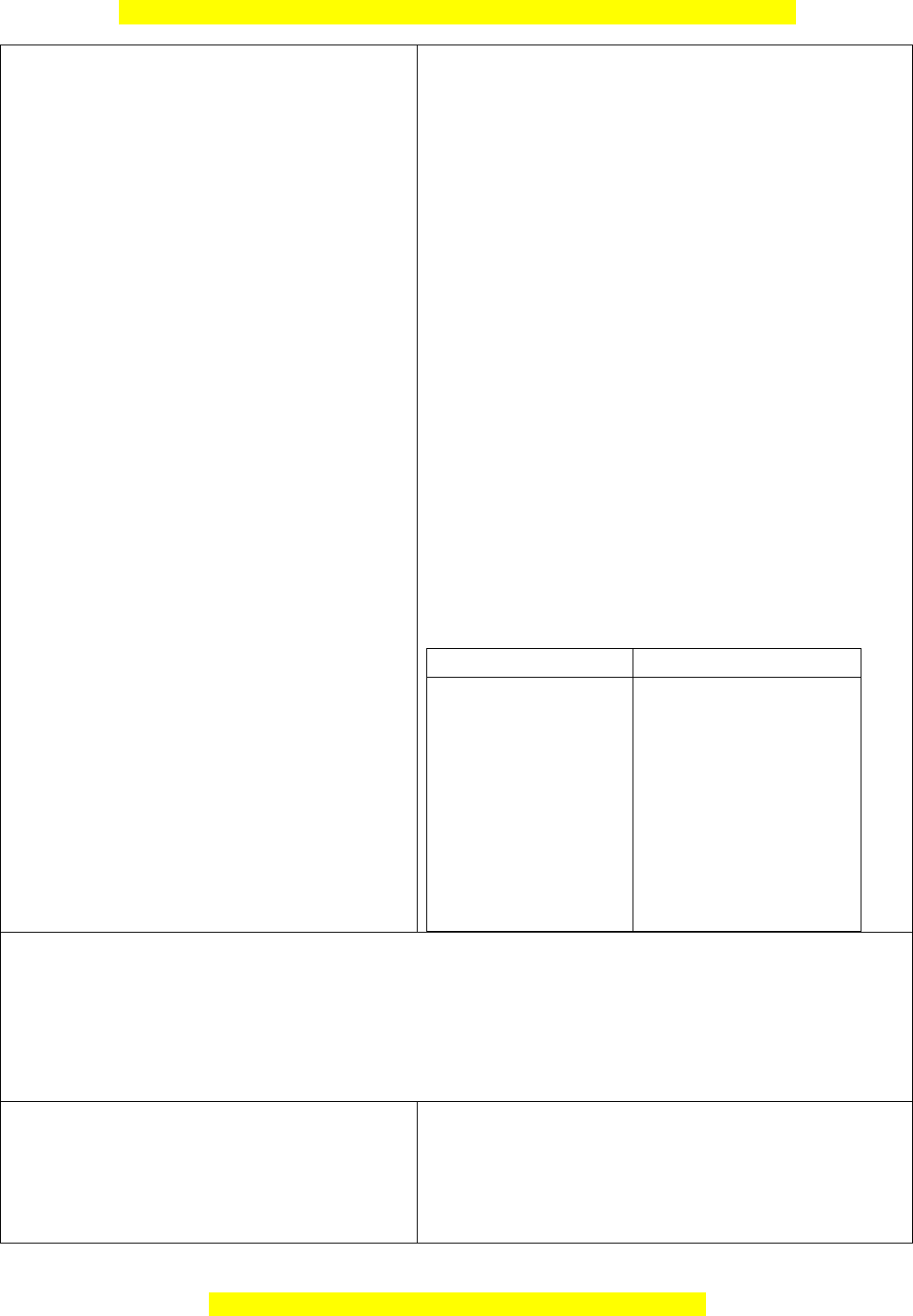
Đây là bản xem thử, vui lòng mua tài liệu để xem chi tiết (có lời giải)
166
Mọi thắc mắc vui lòng xin liên hệ hotline: 084 283 45 85
- Ask Ss to work individually. Remind
them to pay attention to key words in
each statement. Then allow them to
share answers before checking as a
class. Ask them to explain why some
statements are false.
- Ask Ss: Do you prefer the traditional
or modern transport systems in Ha Noi?
-Ss answer the question.
- This can be done as pair work or as a
game. Divide the class into two big
groups. Members of each group take
turns to come to the board to add to the
list of different types of transport
systems in Viet Nam. Set a time limit of
a few minutes. The group with more
words/phrases wins.
2. It was a major means of transport for
Hanoians.
3. In 1990.
4. The population has increased dramatically
5. New rail systems including a skytrain and a
subway are under way.
6. (Students’ own opinions)
3. Decide if the following statements are true
(T) or false (F).
Key:
1. F 2. T 3. F 4. T 5. F
- I prefer ………..
4. Work in pairs. List different types of
traditional and modern transport systems in
Viet Nam.
Suggested answers:
Past
Present
road types: path,
earthen road,
trench, brick road,
tunnel, alley, tram
system
vehicles: bicycle,
rickshaw, coach,
train, tram
road types:
underpass, flyover,
skytrain system,
skywalk system,
cable car, tunnel,
alley
vehicles: motorbike,
bicycle, coach, train,
car, tram, plane
4. Application (13’)
a, Aims: Help Ss talk about changes in transport in the neighbourhood
b, Contents: Discuss the changes in transport in your neighbourhood. Is there anything that
you prefer about the traditional/ modern transport systems where you live?
c, Outcome: Ss can talk about changes in transport in the neighbourhood confidently
d, Organization:
- Ask Ss to work in pairs to do the
discussion. Tell them that they can use
the information from 4 and the
examples in5. Ask some pairs to present
their ideas to the whole class.
5. Discuss the changes in transport in your
neighbourhood. Is there anything that you
prefer about the traditional/ modern
transport systems where you live?

Đây là bản xem thử, vui lòng mua tài liệu để xem chi tiết (có lời giải)
167
Mọi thắc mắc vui lòng xin liên hệ hotline: 084 283 45 85
3. Guides for homework- 2’
- Practice the changes in transport in your neighbourhood.
- Prepare next lesson: Skills 2
+ Describe the similarities or differences between pictures
+ Read the request of listening
+ Write 3 important qualities in an extended family.
=======================================/
Date of checking……../………/2021
……………………………………..
……………………………………..
……………………………………..
Vũ Thị Đua
Week 16 – Period 46
Preparing date:…. /…./2021
Teaching date:…/…../2021
REVIEW 2 (P1)
A. Objectives
1. Knowledge: By the end of the lesson Ss will be able to:
- Review pronunciation, vocabulary and the grammar points they have learnt in unit 4,5,6.
They can also practice making every day English.
a. Vocabulary: Review the vocabulary they have learnt in unit 4, 5, 6
b. Grammar: wish, suggest
c. Pronunciation: Stress on all the words in sentences
d. Skills: Listening and repeating, choosing the best answer, sentence completion,
rewriting the sentences, conversation completion, speaking.
2. Competence: Teamwork and independent working, pair work, linguistic competence,
cooperative learning and communicative competence.
3. Behavior: Students are hard-working and attentive and ready to take exam
B. Teaching aids:
1. Teacher: Textbooks, teaching plan, teacher’s book…
2. Students: Textbooks, notebooks…
C. Procedures:
1. Checking: During the lesson.
2. New lesson:
Teacher’s and students’ activities
The main contents
1. Warm up (3’)
a, Aims: To warm up the class and introduce the lesson.
b, Contents: Ss answer the teacher’s questions individually.
c, Outcome: Ss can answer the teacher’s questions correctly.
d, Organization:
*Chatting.

Đây là bản xem thử, vui lòng mua tài liệu để xem chi tiết (có lời giải)
168
Mọi thắc mắc vui lòng xin liên hệ hotline: 084 283 45 85
- Ask Ss to say if they are living in small
families with their parents and siblings
only
or in big families with grandparents and
other relatives. Ask them if they find any
difficulties living in their family group or if
they want to have anything changed.
2. Pronunciation (10’)
a, Aims: Help Ss review the rules of stress on auxiliaries, articles, and prepositions with Ss
as a class
b, Contents: Read the mini-talks and circle the words in red which you think are stressed.
Then listen and check
c, Outcome: Ss can review the rules of stress on auxiliaries, articles, and prepositions with
Ss as a class and do pronunciation exercises correctly.
d, Organization:
- Review the rules of stress on auxiliaries,
articles, and prepositions with Ss as a class.
- Have Ss then circle the stress
independently.
- Play the recording.
- Ss listen and check their answers.
- Confirm their answers.
- Ss listen again and repeat, in chorus and
individually.
1 Read the mini-talks and circle the words
in red which you think are stressed. Then
listen and check
Key:
1. at
- Isn’t
- is
2. - can’t
- on
- did.
3. - won’t.
- Please!
4. -haven’t.
- about?
- is. Look.
3. Vocabulary (10’)
a, Aims: Help Ss review the sentences with kind of word is needed for each sentence a
noun, a verb, an adjective....
b, Contents:
+ Choose the phrases in the box to complete the sentences.
+ Change the word form of the words provided to complete the sentences.
c, Outcome: Ss can review vocabularies they have learnt in unit 4,5,6 and do vocabulary
exercises correctly.
d, Organization:
- Make sure Ss understand the meanings of
the phrases in the box. Then have them
complete the exercise individually.
2. Choose the phrases in the box to
complete the sentences.
Key:
1. d 2. a 3. g 4. f 5. c 6. h 7. e 8. b

Đây là bản xem thử, vui lòng mua tài liệu để xem chi tiết (có lời giải)
169
Mọi thắc mắc vui lòng xin liên hệ hotline: 084 283 45 85
- Ask Ss to read the sentences and decide
what kind of word is needed for each
sentence (a noun? a verb? an adjective?...).
- Elicit their answers.
- Let Ss do the exercise independently.
- Ss can then share their answers with a
partner.
- Check and write the answers on the
board.
3. Change the word form of the words
provided to complete the sentences.
Key:
1. extended
2. obey
3. solution
4. Preserve
5. religious
6. recognised
7. contribution
8. Illiterate
4. Grammar (20’)
a, Aims: Help Ss review the use of impersonal passive, suggest, adjectives + to infinitive/
that + clauses and wishes
b, Contents:
+ Choose the correct answer A, B, C, or D to complete the sentences.
+ Complete the wishes for the situations.
+ Complete the conversation with A-D.
c, Outcome: Ss can review the use of impersonal passive, suggest, adjectives + to
infinitive/ that + clauses and wishes and do grammar exercises correctly.
d, Organization:

Đây là bản xem thử, vui lòng mua tài liệu để xem chi tiết (có lời giải)
170
Mọi thắc mắc vui lòng xin liên hệ hotline: 084 283 45 85
- This exercise revises the use of
impersonal passive, suggest, adjectives + to
infinitive/ that + clauses.
- Have a brief revision with Ss if necessary.
Then have Ss do the exercise individually.
- Ss exchange their answers and discuss if
there is any difference in their answers.
- Check and explain each answer.
- Have Ss read the situations and decide
which type of wish is used in each
sentence. - Elicit their answers.
- Then let Ss do this exercise
independently, and share their answers
with the class.
- T checks.
- Have Ss read the phrases and sentences
carefully before they do this exercise in
pairs.
- Correct their answers and ask some pairs
to act out the dialogues.
4. Choose the correct answer A, B, C, or D
to complete the sentences.
Key:
1. B 2. D 3. B 4. C 5. D 6. C
5. Complete the wishes for the situations.
Suggested answers:
1. I wish I was now participating in an
international summer camp in Brazil.
2. I wish we still had traditional markets.
3. I wish I could visit Nha Trang.
4. I wish I had time to learn ceramic
painting.
5. I wish I was not at home writing an essay./
I wish I was playing with my friends.
* Everyday English.
6. Complete the conversation with A-D.
Key:
1. C 2. A 3. D 4. B
3. Guides for homework- 2’
- Do the exercises in workbook.
- Review all knowledge in unit 4, 5, 6.
T guides Ss to do exercise part skills
-----------------------------------------------/
Week 16 – Period 47
Preparing date:…. /…./2021
Teaching date:…/…../2021
REVIEW 2 (P2)
A. Objectives
1. Knowledge: By the end of the lesson Ss will be able to:
- Practice 4 skills with the knowledge they have learnt in unit 4,5,6
a,Vocabulary: Review
b, Grammar: Review
c. Skills: Comprehension reading, speaking, listening and deciding on True, False,
writing a passage.

Đây là bản xem thử, vui lòng mua tài liệu để xem chi tiết (có lời giải)
171
Mọi thắc mắc vui lòng xin liên hệ hotline: 084 283 45 85
2. Competence: SS will develop some competences such as being determined, self-studying,
creative and communicating. They will use language correctly.
3. Behavior: Students are hard-working and attentive.
B. Teaching aids:
1. Teacher: Textbooks, teaching plan, teacher’s book…
2. Students: Textbooks, notebooks…
C. Procedures:
1. Checking: During the lesson.
2. New lesson:
Teacher’s and students’ activities
The main contents
1. Warm up (3’)
a, Aims: To attract Ss’ attention to the lesson and to lead in the new lesson.
b, Contents: Ss work individually to answer the teacher’s questions.
c, Outcome: Ss can answer the teacher’s questions correctly.
d, Organization:
T asks Ss some questions
Ss answer the question
* Questions
- What do you do in your free time?
- Do you like ….
-
2. Reading (7’)
a, Aims: Help Ss know how to do the reading exercise.
b, Contents: Ss work in pairs to read the following passage and choose the correct answer
A, B, C, or D for the questions.
c, Outcome: Ss can understand the passage and do reading exercise correctly.
d, Organization:
- Ss read the text and answer the
questions independently. They can then
compare their answers with a partner.
- Check and have Ss explain where in
the text they found the information for
the answers.
1 Read the text and choose the correct
answer A, B, C, or D for the questions.
Key:
1. A 2. D 3. D 4. B 5. C
3. Speaking (10’)
a, Aims: Help Ss know how to give their opinion
b, Contents: These are some ideas taken from Reading. Do you agree or disagree with
them? Support your answers with ideas from the passage or of your own.
c, Outcome: Ss can practice speaking and discuss about the topics well.
d, Organization:
- This is an open speaking exercise.
Allow Ss some time to read the ideas
and form their own opinion.
- Ss can work in groups.
- Have some Ss/groups present their
2. These are some ideas taken from
Reading. Do you agree or disagree with
them? Support your answers with ideas from
the passage or of your own.

Đây là bản xem thử, vui lòng mua tài liệu để xem chi tiết (có lời giải)
172
Mọi thắc mắc vui lòng xin liên hệ hotline: 084 283 45 85
own opinions in front of the class.
4. Listening (8’)
a, Aims: Help Ss listen and do do execise: True or false.
b, Contents: Listen to Nguyen’s presentation about a natural wonder in Viet Nam and
decide if the sentences are true (T) or false (F).
c, Outcome: Ss can do listening exercises well.
d, Organization:
- Ask Ss to carefully read the questions
first. T then plays the recording. Ss
listen and decide if the statements are
true or false. Write Ss’ answers on the
board. Don’t confirm their answers at
this stage. Have them listen again and
check their own answers. Then correct
them.
3. Listen to Nguyen’s presentation about a
natural wonder in Viet Nam and decide if the
sentences are true (T) or false (F).
Key:
1. F 2. T 3. F 4. T 5. T
6. F
5. Writing (15’)
a, Aims: Help Ss write a short paragraph about a traditional home in the countryside of
Viet Nam in the past.
b, Contents: Based on the notes below, write a short paragraph about a traditional home in
the countryside of Viet Nam in the past. In your writing, you can include all orsome of the
ideas below.
c, Outcome: Ss can write a short paragraph about a traditional home in the countryside of
Viet Nam in the past well.
d, Organization:
- Have Ss read the notes of a traditional
home first. They can then arrange their
ideas and start writing.
- T may call on a volunteer to write on
the board. Other Ss and T comment on
it. Ss then refer back to their own
writings and see if they want to make
any changes.
- Collect some work to correct at home.
4. Based on the notes below, write a short
paragraph about a traditional home in the
countryside of Viet Nam in the past. In your
writing, you can include all orsome of the
ideas below.
3. Guides for homework- 2’
- Do the exercises in workbook.
- Review all knowledge in unit 4, 5, 6.
- Prepare: The first term test.
-----------------------------------------------/
Week 16 – Period 48
REVISION

Đây là bản xem thử, vui lòng mua tài liệu để xem chi tiết (có lời giải)
173
Mọi thắc mắc vui lòng xin liên hệ hotline: 084 283 45 85
A. OBJECTIVES :
1. Knowledge : By the end of the lesson, Ss will be able to
- Review all the vocabularies, grammar and language function in Unit 4,5.
- Revise vocab, use grammar in unit 4 ,5 and 6 and do well all exercises related.
a,Grammar : used to, present wish, passive voice: Impersonal passive, Suggest V-ing/
that S should do sth.
b, Vocabulary : words related to topic unit 4 and 5
c, Skills : Listening, speaking, reading, writing
2. Competences : develop the competences of communication, cooperation and using
languages and problem solving in doing exercises
3. Behavior : serious in revising knowledge
B. Teaching aids:
1. Teacher: Textbooks, teaching plan, teacher’s book…
2. Students: Textbooks, notebooks…
C. Procedures:
1. Checking: During the lesson.
2. New lesson:
Teacher’s activities
Students’ activities
I. WARM UP - 5’
Chatting
? What grammar have you learnt in unit 4 and
5?
? Say again the theory , please.
? what grammar do you find the most difficult?
II.NEW LESSON - 38’
1. Used to + V -> Past habits
Ex1 : Fill in the blank with “use, used to, be
used to, or be used for”
1. I ……….. this pen to write my lessons.
2. I…………………… love Ann but now she
gets on my nerves.
3. There…………… be a tree in front of my
house.
4. They……………… have a computer to do
the most complicated calculations.
5. These bricks…………………… building a
new school .
Ex 2. Write a sentence for each of the
- Answer the questions.
+ used to V, wishes for the present
+ Impersonal passive, suggest –
Ving/ clause with should.
- Do the exercise
1. use
2. used to
3. used to
4. used to
5. are used for
Preparing date:…. /…./2021
Teaching date:…/…../2021

Đây là bản xem thử, vui lòng mua tài liệu để xem chi tiết (có lời giải)
174
Mọi thắc mắc vui lòng xin liên hệ hotline: 084 283 45 85
following using used to or didn’t use to.
1. When Barbara was in Italy, she stayed with
an Italian family.
->
2. I quite like drinking coffee in the morning,
although I wasn’t keen on it when I was
younger
- >
3. We seem to have lost interest in our work.
->
4. I don’t mind travelling by train now.
->
5. I went to the church when I was a child.
->
2. Wishes for the present
Ex 1 : Supply the correct form of the verbs in
brackets
1. I wish my room ( be ) __________ bigger.
2. I wish it ( not / rain ) __________ so much
in London.
3. I wish there ( not / be ) __________ so
many people there.
4. I wish I ( not / have ) __________ to work.
5. I wish she ( can ) __________ get a good
job.
6. I wish he ( want ) __________ to dance with
me.
7. I wish I ( have ) __________ a new bike.
8. I wish they ( stop ) __________ making so
much noise so that I could concentrate.
9. John wishes he ( know ) __________ how to
use a printer.
10. She wishes she ( live ) __________ in a big
city.
3. SUGGEST + v-ING / THAT-SHOULD
I. Supply the correct form of the verbs in
brackets
1. I suggest (collect) old books and notebooks.
2. I suggest that you (work) __________harder
on your pronunciation.
3. I suggest (collect) __________unused
clothes.
- Go to the board and write .
- Check and correct with the whole
class.
1. .....she used to stay with an Italian
family.
2. I didn’t use to drink coffee in the
morning when I was younger
3. We used to have interest in our work
4. I didn’t use to travel by train .
5. I used to go to the church when I was
a child
EX 2. Rewrite the sentences beginning
with “I wish”.
1. I don’t know many people (and I’m
lonely).
=>............................................................
2. I don’t have a key (and I need one).
=>I wish ..........................................
3. Ann isn’t here (and I need to see her).
=>....................
4. It’s cold (and I hate cold weather).
=>............................................................
.5. I live in a big city (and I don’t like
it).=>.......................
6. I can’t go to the party (and I’d like
to).=>........................
- Do the exercises
1. collecting
2. should work
3. collecting
4. should listen

Đây là bản xem thử, vui lòng mua tài liệu để xem chi tiết (có lời giải)
175
Mọi thắc mắc vui lòng xin liên hệ hotline: 084 283 45 85
4. I suggest that you (listen) __________to
English programmes on the radio or on TV.
5. I suggest (organize) __________a show to
raise money.
6. I suggest that you (practice)
__________writing English sentences.
7. I suggest (play) soccer after school.
8. I suggest that you (use) __________English
with friends in class.
9. I suggest (take) _________a taxi home
10. I suggest that you (practice)
__________listening to English lessons on
tapes.
II. Choose the most appropriate answer.
1. My teacher suggested I ___ harder to pass
the exam.
A. studies B. study C. studying
2. The professor suggested he _____ the
research before March.
A. summit B. summiting C. summits
3. Her leader suggested _____ on time.
A. being B. be C. is
4. Linh suggests they _____ a meeting every
week.
A. should have B. have C. Both
are correct
5. The coacher suggested that they _____ a
Facebook group.
A. have B. has C. having
4. Impersonal passive
18. They say that Jenny is the brightest student
in the class.
19. People believed that the Earth stood still.
20. No one believes his story.
21. Are the police making inquires about the
thief.
22. They declared that she won the
competition.
23. The speaker reported that the President had
suffered a heart attack.
24. They think that he had died a natural death.
III. SUMMARY & HOMEWORK-2’
5. organizing
6. should practice
7. playing
8. should use
9. taking
10. should practice
1. B
2. A
3. A
4. C
5. A
- Go to the board and write
18. It is said that Jenny is the brightest
student in the class.
19. It was believed that the Earth stood
still.
20. his story isn’t believed
21. Are inquires about the thief being
made the police
22. It was declared that she won the
competition.
23. It was reported that the President
had suffered a heart attack.
24. It is thought that he had died a
natural death.

Đây là bản xem thử, vui lòng mua tài liệu để xem chi tiết (có lời giải)
176
Mọi thắc mắc vui lòng xin liên hệ hotline: 084 283 45 85
- Do more exercises at home to prepare for
the FIRST END-TERM TEST
- Listen and remmember
---------------------------------------------------/
Date of checking……/……/2021
………………………………
………………………………
……………………………….
Vũ Thị Đua
Week 17 – Period 49
Date of planning: …./…../2021
Date of teaching: …/…../2021
THE FIRST END-TERM TEST
A. Objectives
1. Knowledge: By the end of the lesson, ss will be able to finish the test on time.
2. Competence: SS can use language correctly.
3. Behavior: SS are serious to do the test.
B. Teaching aids: CD and stereo, paper tests.
C. Procedures
ĐỀ THI DO PHÒNG GIÁO DỤC RA
------------------------------------------------------/
Week 17 - Period 50+51
Date of planning: …./…../2021
Date of teaching: …/…../2021
REVISION (ORAL TEST IF POSSIBLE)
A. Objectives
1. Knowledge: By the end of the lesson, Ss will be able to finish their speaking test.
2. Competence: Ss can do the speaking test well.
3. Behavior: SS are serious to do the speaking test.
B. Teaching aids
1. Teacher: Textbooks, teaching plan, handouts…
2. Students: Textbooks, notebooks…
C. Procedures
1. Checking: During the lesson.
2. New lesson:
Teacher’s and Students’ activities
Contents
Oral test
a, Aims: Check Ss’ speaking abilities.
b, Contents: Ss work individually to do the oral tests.
c, Outcome: Ss can do the oral tests well.

Đây là bản xem thử, vui lòng mua tài liệu để xem chi tiết (có lời giải)
177
Mọi thắc mắc vui lòng xin liên hệ hotline: 084 283 45 85
d, Organization:
- Asks Ss to do the oral tests.
- Ss do the oral tests individually.
- T gives comments and marks.
PART 1.Talk about yourself (0.5pt, time: 1’ - 2’)
I. Full name? Name of class and school? (0.25pt)
+ I am ...............
+ I go to ...............................school
+ I am in class .........................
II. Your hobbies (0.25pt)
+ I like......................../ My favorite subject(s)/ activities is/ are .................
+ I don’t like...................
Questions in use
(This list must not be shown. Each student asked five questions)
Ss have to answer teacher’s five questions about personal information .
1. How many people are there in your family?
2. Where do you live?
2. What does your father/ mother look like?
3. What is he/ she like?
4. Who do you live with?
5. Who are your friends?
6. Is your school big or small?
7. What do you usually do after school?
8. What is your favorite subject?
9. Which subjects are you good at?
10. Do you like English?
11 . When do you do your homework?
12. Where do you often go shopping?
13. Do you often go to the supermarket?
14. Is there a shopping mall near your house?
15. Do you like to live in the country or in the city? Why?
Part II. Oral test:
1. Describe a place of interest in your hometown.
A
B
1. What is your traditional craft in your
area?
1. What is the craft village in Viet Nam
you would like to visit?
2. What are the challenges that artisans
may face?
2. What is it famous for?
3. What would you do if you were
responsible for promoting traditional
craft?
3. What do you think the government
should do to improve these craft villages
in our country?
2. Do you like living in the city? Why or why not?
A
B

Đây là bản xem thử, vui lòng mua tài liệu để xem chi tiết (có lời giải)
178
Mọi thắc mắc vui lòng xin liên hệ hotline: 084 283 45 85
1. Talk about the advantages of living in
the countryside.
1. Talk about the disadvantages of living
in the countryside.
2. What do you think the most serious
problem in the big cities?
2. Tell three famous cities around the
world. Where are they?
3. What should you do to solve that
problem?
3. What city in the world would you like
to visit most? Why?
3. Talk about teen stress and pressure and how to cope with them
A
B
1. What do you think are the necessary
life skills for teenagers in our country?
1. Imagine you have a problem at school
or with your friends.
2. Which skills do you think you have
already had?
2. How do you think you can do to deal
with the problem?
3. Which skills do you need to develop?
Why?
3. What do you think is the most
important quality a person needs to be
able to get along with others? Why?
4. Talk about children’s pastimes in the past.
A
B
1. Tell three names of the traditional
games children in the past often played.
1. Tell three facilities which were not
available twenty years ago.
2. Do you like playing these games? Why
or why not?
2. What would happen if that facility
disappeared now?
3. How do you think students in the past
studied without facilities?
3. What was the life in the past without
facilities like?
5. Describe a wonder of Viet Nam
A
B
1. Name three man-made wonders of Viet
Nam
1. Name three natural wonders of Viet
Nam
2. Tell some of the things that have
caused damage to the man-made
wonders.
2. Do you think we should limit the
number of tourists who can visit these
sites? Why?
3. What should we do to protect and
preserve our damaged man-made
wonders?
3. Do you think we should raise money to
protect and preserve them? Why?
6. Talk about some changes in your hometown.
A
B
1. What is a nuclear family? What about
an extended family?
1. List different types of traditional and
modern transport system in Viet Nam.
2. Do you prefer living in a nuclear or
extended family? Why?
2. What kind of transport system do you
prefer? Why?
3. What are the disadvantages of living in
a nuclear family?
3. Is there anything that you prefer about
the traditional or modern transport system

Đây là bản xem thử, vui lòng mua tài liệu để xem chi tiết (có lời giải)
179
Mọi thắc mắc vui lòng xin liên hệ hotline: 084 283 45 85
where you live?
Part III: Extra questions related to the topics (0.5pt, time: 1’ – 2’)
=> Using extra questions in Part 2 (0.25pt/ each answer to each suggested
question)
---------------------------------------------------/
Date of checking……/……/2021
………………………………
………………………………
……………………………….
Vũ Thị Đua
Week 17 – Period 52
Preparing date:…. /…./2021
Teaching date:…/…../2021
UNIT 6 : VIET NAM THEN AND NOW
Lesson 6 : Skills 2
A. Objectives
1. Knowledge: By the end of the lesson students will be able to:
- Listen for general and specific information about life in an extended family.
- Write about some qualities a person needs to get along in an extended family.
a. Vocabulary: about family groups in Viet Nam in the past and at present.
b. Grammar: Review
c. Skills: Listening completion, listening and deciding on True, False ,writing to give
reasons.
2. Competence: SS will develop some competences such as being determined, self-studying,
creative and communicating. They will use language correctly.
3. Behavior: Students are hard-working and attentive. Ss have aware of protecting the
traditions and promoting them.
B. Teaching aids:
1. Teacher: Textbooks, teaching plan, teacher’s book…
2. Students: Textbooks, notebooks…
C. Procedures:
1. Checking: During the lesson.
2. New lesson:
Teacher’s and students’ activities
The main contents
1.Warm up (4’)
a, Aims: To help Ss to pay attention in the lesson.
b, Contents: Ss work individually to draw aliens and answer the questions.

Đây là bản xem thử, vui lòng mua tài liệu để xem chi tiết (có lời giải)
180
Mọi thắc mắc vui lòng xin liên hệ hotline: 084 283 45 85
c, Outcome: Ss can answer the questions correctly.
d, Organization:
- Ask Ss to say if they are living in
small families with their parents and
siblings only or in big families with
grandparents and other relatives. Ask
them if they find any difficulties living
in their family group or if they want to
have anything changed.
*Chatting.
2. Presentation (15’)
a, Aims: Help Ss listen for general and specific information about life in an extended
family and do exercise
b, Contents:
+ Describe what you see in each picture. What are the similarities or differences between
them?
+ Nick is talking to Mrs Ha, Duong’s mother, about her family in the past. Listen to the
conversation and fill in the blanks.
+ Listen again and decide if the following statements are true (T) or false (F).
c, Outcome: Ss can listen to life in an extended family and do listening exercises correctly.
d, Organization:
- Ask Ss to work in pairs to describe the
pictures and answer the question.
- Ask a pair to share their ideas with
the class.
- Tell Ss that they are going to listen to
a talk between Nick and Mrs Ha,
Duong’s mother, about her family in the
past.
- Ask them to read the information in
the table carefully and try to predict the
answers. Tell them to decide the part of
speech of the words they will need to
fill in the blanks, then listen carefully to
find the
words from the recording.
- Play the recording twice.
- Have two Ss write their answers on the
board.
- Confirm the correct answers.
1. Describe what you see in each picture.
What are the similarities or differences
between them?
2. Nick is talking to Mrs Ha, Duong’s mother,
about her family in the past. Listen to the
conversation and fill in the blanks.
Key:
1. extended family
2. three generations
3. shared
4. their day
5. their work
6. things happening
7. to be tolerant
8. talk
9. listen
10. compromise

Đây là bản xem thử, vui lòng mua tài liệu để xem chi tiết (có lời giải)
181
Mọi thắc mắc vui lòng xin liên hệ hotline: 084 283 45 85
- Have Ss work individually to
underline the key words in the
statements.
- Ask Ss to do the exercise without
listening to the recording.
- Write their answers on the board
without confirming the correct answers.
- Play the recording again for Ss to
check.
3. Listen again and decide if the following
statements are true (T) or false (F).
Key:
1. T 2. T 3. F
4. F 5. T 6. T
3. Practice (20’)
a, Aims: Help Ss discuss some qualities a person needs to get along in an extended family
and Help Ss write about some qualities a person needs to get along in an extended family.
b, Contents:
+ Work in pairs. Discuss which three of the following qualities would be necessary for
people living in an extended family. Remember to give reasons.
+ Write about the three most important qualities you think a person needs to be able to get
along with other members in an extended family. You can use the suggested words/phrases
above or use your own.
c, Outcome: Ss can know more qualities a person needs to get along in an extended family
and write about some qualities a person needs to get along in an extended family well.
d, Organization:
- First, check that everybody
understands the meaning of all the
adjectives in the box. Set a time limit
for pairs to brainstorm ideas and do the
discussion. Move around and help Ss if
necessary.
- Ask Ss to refer back to the listening in
2 and 3, and the example for useful
language and ideas.
- Ask some pairs to present their ideas
to the whole class. Confirm that they
should give examples to support their
main points.
- Now that Ss have talked about the
topic, it’s time they wrote about it. Ss
should work individually to get their
ideas down on paper and check the
accuracy of what they have written.
- Give them about 10 minutes to write
and edit their work.
- Next they should pass their work to
4. Work in pairs. Discuss which three of the
following qualities would be necessary for
people living in an extended family.
Remember to give reasons.
5. Write about the three most important
qualities you think a person needs to be able
to get along with other members in an
extended family. You can use the suggested
words/phrases above or use your own.
Some samples:
Positive comments – Good point/Interesting
argument/Original/Good English/Very clear
Suggestions – Can this be clearer?/Please give

Đây là bản xem thử, vui lòng mua tài liệu để xem chi tiết (có lời giải)
182
Mọi thắc mắc vui lòng xin liên hệ hotline: 084 283 45 85
someone who wasn’t in their pair for
them to do peer review and add their
comments and corrections. It may help
to give Ss ideas of comments they can
write on their classmate’s work. Write
some samples on the board.
- If time allows, give feedback on a few
Ss’ work. If not, ask Ss to write the
second draft for homework.
- Remind them to refer to peers’
comments and feedback.
an example/Please explain more
4. Application (5’)
a, Aims: Help Ss practice speaking
b, Contents: Ss talk about most important qualities you think a person needs to be able to
get along with other members in an extended family
c, Outcome: Ss can talk about most important qualities you think a person needs to be
able to get along with other members in an extended family
d, Organization:
T asks Ss to talk about most important
qualities you think a person needs to be
able to get along with other members in
an extended family
Ss do it
T corrects the mistakes
3. Guides for homework
- Revise the writing.
- Prepare next lesson: Looking back - Project.
+ Find the transportation then and now
+ Guide to do exercise
----------------------------------------------------------/
Week 18 – Period 53
Preparing date:…. /…./2021
Teaching date:…/…../2021
UNIT 6 : VIET NAM THEN AND NOW
Lesson 6 : Looking back and project
A. Objectives
1. Knowledge: By the end of the lesson students will be able to:
- Practice vocabulary and grammar points they have learnt in this unit.
- Practice making communication, project.
a. Vocabulary: about changes in transport systems, family groups, and school life in Viet
Nam in the past and at present
b. Grammar: the past perfect, adj + to-infinitive and adj + that-clause.
c. Skills: Sentence completion, correcting the mistakes, speaking the conversation,
answering the questions.

Đây là bản xem thử, vui lòng mua tài liệu để xem chi tiết (có lời giải)
183
Mọi thắc mắc vui lòng xin liên hệ hotline: 084 283 45 85
2. Competence: Teamwork and independent working, pair work, linguistic competence,
cooperative learning and communicative competence
3. Behavior: Ss have aware of protecting the traditions and promoting them.
B. Teaching aids:
1. Teacher: Textbooks, teaching plan, teacher’s book…
2. Students: Textbooks, notebooks…
C. Procedures:
1. Checking: During the lesson
2. New lesson:
Teacher’s and students’ activities
The main contents
1. Warm up (3’)
a, Aims: To attract Ss’ attention to the lesson and to lead in the new lesson.
b, Contents: Chatting
c, Outcome: Ss can attention to the lesson.
d, Organization:
- Ask Ss some question
*Chatting.
- Have you ever visited Ha Noi?
- How do you get there?
- What do you confirm about means of
transports and road systems in Ha Noi?
2. Vocabulary (10’)
a, Aims: Help Ss practice the lexical items related to changes in transport systems, family
groups, and school life in Viet Nam in the past and at present
b, Contents:
+ Complete the following word web with transport systems in Viet Nam then and now.
+ Fill in each blank with one word/phrase.
+ Read the passage and fill in each blank with a suitable word from the box.
c, Outcome: Ss can review vocabularies about changes in transport systems, family groups,
and school life in Viet Nam in the past and at present and do vocabulary exercises
correctly.
d, Organization:
- Have Ss work individually to list all the
words on a piece of paper. Set a time limit
of three minutes. Then have them combine
to work in groups. Ask them to note down
as many words they have just listed as
possible on a larger piece of paper. Set a
new time limit. When the time is up,
groups stick their pieces of paper on the
board. The group with the highest number
of words/phrases wins.
I. Vocabulary
1. Complete the following word web with
transport systems in Viet Nam then and
now.
Suggested answers:
Then: earthen road, path, trench, brick road,
tunnel, alley, tram system
Now: concrete road, underpass, flyover,
skytrain system, skywalk system, cable car,
tunnel, alley
2. Fill in each blank with one word/phrase.

Đây là bản xem thử, vui lòng mua tài liệu để xem chi tiết (có lời giải)
184
Mọi thắc mắc vui lòng xin liên hệ hotline: 084 283 45 85
- Ask Ss to work individually, then
compare their answers with a partner.
- Ask Ss to write their answers on the
board. - Confirm the correct answers.
- Have Ss work in pairs. Tell them that
they should pay attention to the cues in the
passage for their answers.
- Elicit the answers from Ss.
Key:
1. extended
2. nuclear
3. facilities
4. Rubber sandals
5. trenches
3. Read the passage and fill in each blank
with a suitable word from the box.
Key:
1. extended
2. nuclear
3. disobedient
4. sympathetic/ understanding
5. understanding/sympathetic
6. tolerant
7. caring
8. share
3. Grammar (15’)
a, Aims: Help Ss review adj + to-infinitive and adj + that-clause and Help Ss practice
making communication
b, Contents:
+ Complete the sentences with appropriate adjectives.
+ Correct the italised text where necessary.
+ Communication
c, Outcome: Ss can review adj + to-infinitive and adj + that-clause and do grammar
exercises correctly.
d, Organization:
- Ask Ss to work individually first.
- Then have Ss check their answers with a
partner before having them discuss as a
class.
- Remind Ss to keep a record of their
original answers so that they can use that
information in their self-assessment.
II. Grammar
4. Complete the sentences with appropriate
adjectives.
Key:
1. necessary/important 2.certain/sure/hopeful
3. certain/sure/conf dent
4. sorry/sure
5. sorry
6. convinced/certain/sure
5. Correct the italised text where
necessary.
Key:
1. no change 5. no change
2. take → could take 6. no change
3. no change 7. no change
4. let → to let 8. be → was

Đây là bản xem thử, vui lòng mua tài liệu để xem chi tiết (có lời giải)
185
Mọi thắc mắc vui lòng xin liên hệ hotline: 084 283 45 85
- First, ask pairs to role-play. They can
then switch partners and roles and role-
play again.
- Ask for volunteer pairs to perform in
front of the class, praise their efforts at
fluency and ability to communicate rather
than
the accuracy of their language.
3. Communication
6. Role-play. Interview a travel agent about
Vietnamese people’s holiday trends before
and after 2000.
Example:
Interviewer: Have the Vietnamese changed
the way they spend their holidays over the
last 20 years?
Travel agent: Considerably. For example,
they’ve changed their holiday destinations.
Interviewer: So… where did they often go
before 2000?
Travel agent: They often went to…
4. Project (5’)
a, Aims: Help Ss practice making project at home well
b, Contents: Ss listen T’s guide.
c, Outcome: Ss can do communication exercise well and Ss can know how to do project
d, Organization:
- Have Ss work in groups to ask and
answer the questions
GUIDE STUDENT, ASK THEM TO
DO AT HOME
- Ss follow the instructions in the book to
research and prepare a photo exhibition of
their own.
If resources are available, this would be
best done as a computer slide show.
Answer Ss’ questions if there are any.
- Have Ss present their work in the next
session, then ask the whole class to vote
for the best exhibition/ show.
4. Project
1. What do you like most about each of the
pictures? Why?
2. Plan a photo exhibition about school life
in Viet Nam then and now. Work in groups
of four. Search for information about
the subject. Find photos which show the
similarities and differences between then
and now. Put them together with some
captions as a photo exhibition.
3. Present your group’s photo exhibition
to the rest of the class. Remember to say
what values you’ve learned from school life
in the past.
3. Guides for homework(2’)
- Complete the project.
- Prepare next lesson: Review 2
T guides Ss to do execises in Review 2
----------------------------------------------------------/

Đây là bản xem thử, vui lòng mua tài liệu để xem chi tiết (có lời giải)
186
Mọi thắc mắc vui lòng xin liên hệ hotline: 084 283 45 85
Week 18 – Period 54
Date of planning: …./…../2021
Date of teaching: …/…../2021
THE SECOND END-TERM WRITTEN
TEST CORRECTION
A. Objectives
1. Knowledge: By the end of the lesson, ss will be able to realize what they have done, what they
haven’t done.
2. Competence: They can self-evaluate their studying and have good plans to improve it.
3. Behavior: Students are hard-working and attentive. They will try their best to get better
results.
B. Teaching aids
1. Teacher: Textbooks, teaching plan, paper tests, loud speaker.
2. Students: Textbooks, notebooks, paper tests.
C. Procedures
1. Checking: During the lesson.
2. New lesson:
• Review
• Result:
Class
3,5 - 5
%
5 – 6,5
%
6,5 - 8
%
8 - 10
%
8A
8B
Grade 8
• Keys and points: are provided by Thanh Mien Division of Education and Training.
----------------------------------------------------------/
Date of checking……/……/2021
………………………………
………………………………
……………………………….
Vũ Thị Đua

Đây là bản xem thử, vui lòng mua tài liệu để xem chi tiết (có lời giải)
187
Mọi thắc mắc vui lòng xin liên hệ hotline: 084 283 45 85
Date of preparation
Date of teaching
Class
Absentees
Period 54

Đây là bản xem thử, vui lòng mua tài liệu để xem chi tiết (có lời giải)
188
Mọi thắc mắc vui lòng xin liên hệ hotline: 084 283 45 85
CORRECTING THE FIRST TERM TEST
I. OBJECTIVES:
1. Knowledge:
- Find the mistakes for all the exercises which they have done in the first term test
and correct themselves.
- Know the answer keys.
- Encourage students to study harder to get good mark for the next writing test.
2. Skills: listening, reading, writing
3. Attitude: Ss will be more aware of studying harder.
4. Competence development: independent working.
II. TEACHING AIDS
1. Teacher: Textbooks, plan
2. Students: Textbooks.
III. PROCEDURE
1. Checking: No
2. New lesson:
Teacher’s and students’ activities
Content
1.Warm up
Aim: To warm up the class
T asks Ss some questions
Ss answer the questions
Eg:
How do you feel today?
Do you want to get good mark?
Can you guess what is your point?
.......
2. Listening
Aim: Ss can understand more about listening skill.
*Notice ss some experiences when
doing listening exercises:
- Read the qs before listening
- Guess the meaning of the new
words.
Ss listen to the teacher.
* Retell the qs of the test.
- Ask Ss to listen and give the
correct answer.
- Ss listen and do exercise I.
- Give key.
A. LISTENING
1. Listen and tick True or False for
the following sentences. (1,0 point).
1- T
2 - F
3 - F
4- T
2. Complete the sentences. (1,0 point)
5. fierce .

Đây là bản xem thử, vui lòng mua tài liệu để xem chi tiết (có lời giải)
189
Mọi thắc mắc vui lòng xin liên hệ hotline: 084 283 45 85
6. academic.
3. Vocabulary and Grammar
Aim: Ss can know how to do exercise abour vocabulary and grammar
- Ask Ss to do exercises
- Call some ss to give the answers.
- Ss perform before class /write on
the board.
- Call others to correct.
- Give key.
- Point out the mistakes about
grammar, vocabulary.
- Ss listen to the teacher and
remember.
- Repeat again all the main
knowledge about vocabulary and
grammar that ss don’t understand
well.
- Ss listen to the teacher and write
down.
Choose the best option (A, B, C or D) to
complete each sentence. (2,0 points)
7 – C.
Although
8- B.
carved
9- D.
more
crowded
10-
A.
with
11- A.
didn’t use
to
12- B.
was
not
sitting
13- D.
where
14-
A. if
4. Reading
Aim: Ss can know how to do reading again and correct their mistakes
* Notice ss some experiences when
doing reading exercises:
- Read the qs before reading
- Guess the meaning of the new
words.
Ss listen to the teacher.
- Call some ss to give the answers.
- Ss perform before class /write on
the board.
- Call others to correct.
- Give key.
1. Write True (T) or false (F) for the
following statements. (1,0 point).
15. F 16. T 17. T 18. F
2. Answer the following questions. (1,0
point).
19. It was established in 1908.
20. It is a very nice, spacious school
with great views of the lake from the
class windows
21. He was a famous Vietnamese
Confucianism teacher during the Tran
Dynasty
22. I think it is because he used to be a
famous and dedicated teacher
5.Writing
Aim: Help Ss know to rewrite sentences and write a passage
1. Rewrite the following sentences. (1,0
points).

Đây là bản xem thử, vui lòng mua tài liệu để xem chi tiết (có lời giải)
190
Mọi thắc mắc vui lòng xin liên hệ hotline: 084 283 45 85
T & Ss:Find out the reasons of
making mistakes and the way to
correcting.
T notices ss to do the next test better
and learn by heart all structures and
vocabulary again.
23. It is said that he invented the digital
camera.
24. She said she would visit me that
week.
25. We were happy that we did well in
the exam.
26. We went out for a picnic although
the weather was bad.
*Homework.
- Practice grammar from unit 1 to unit 3 again.
- Do all exercises in unit 1, 2, 3 in work book.
- Prepare:Unit 7
